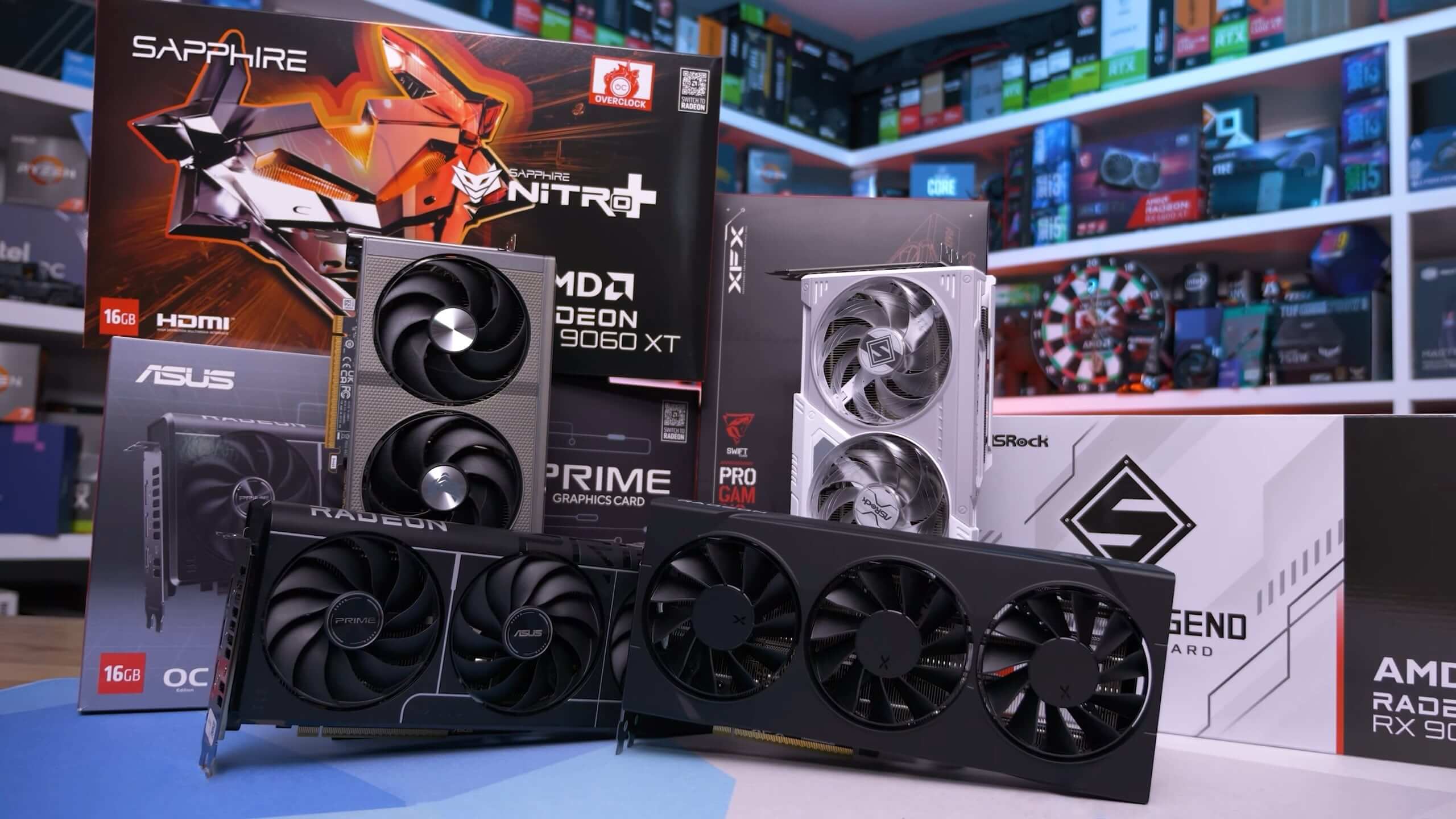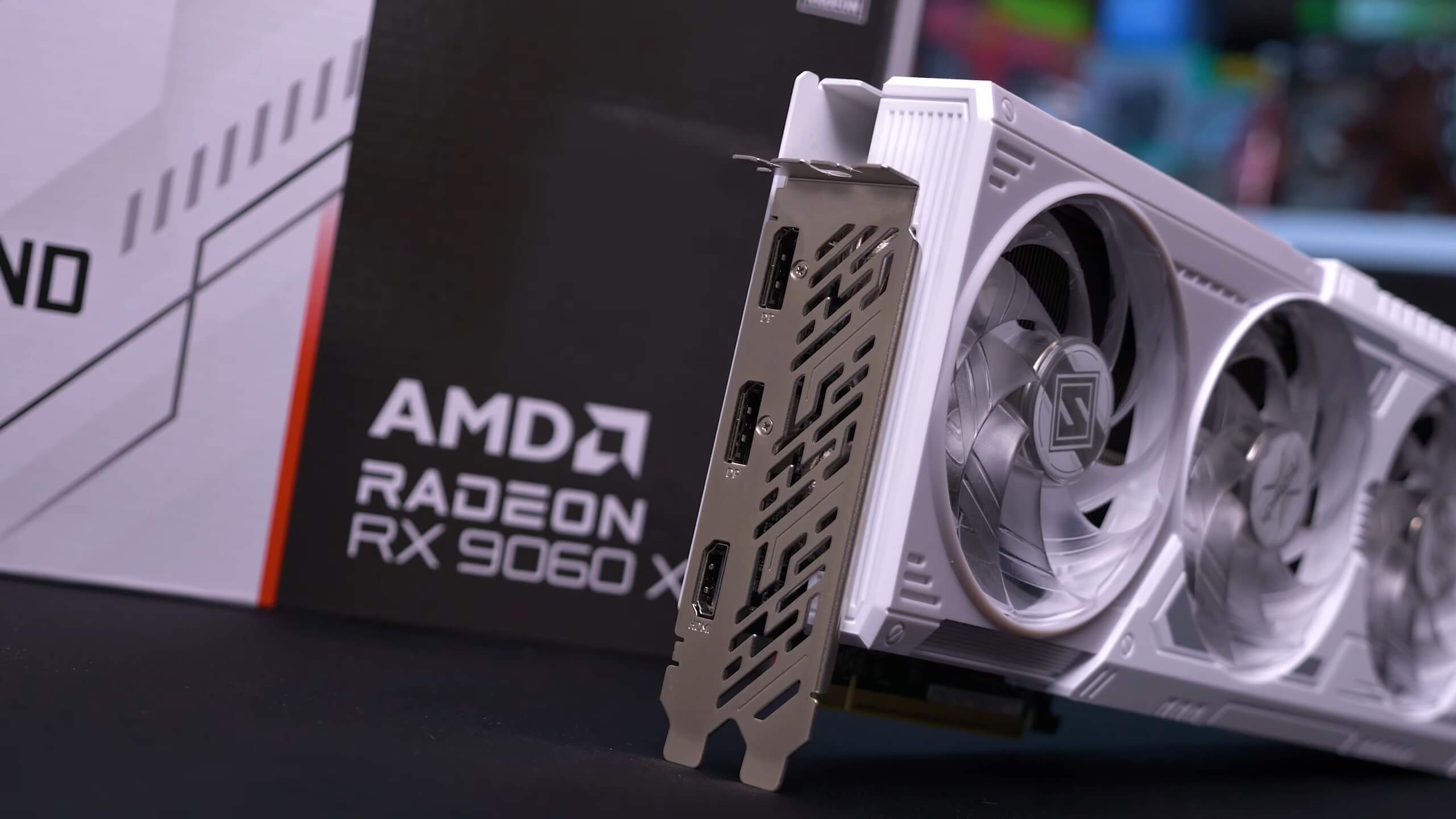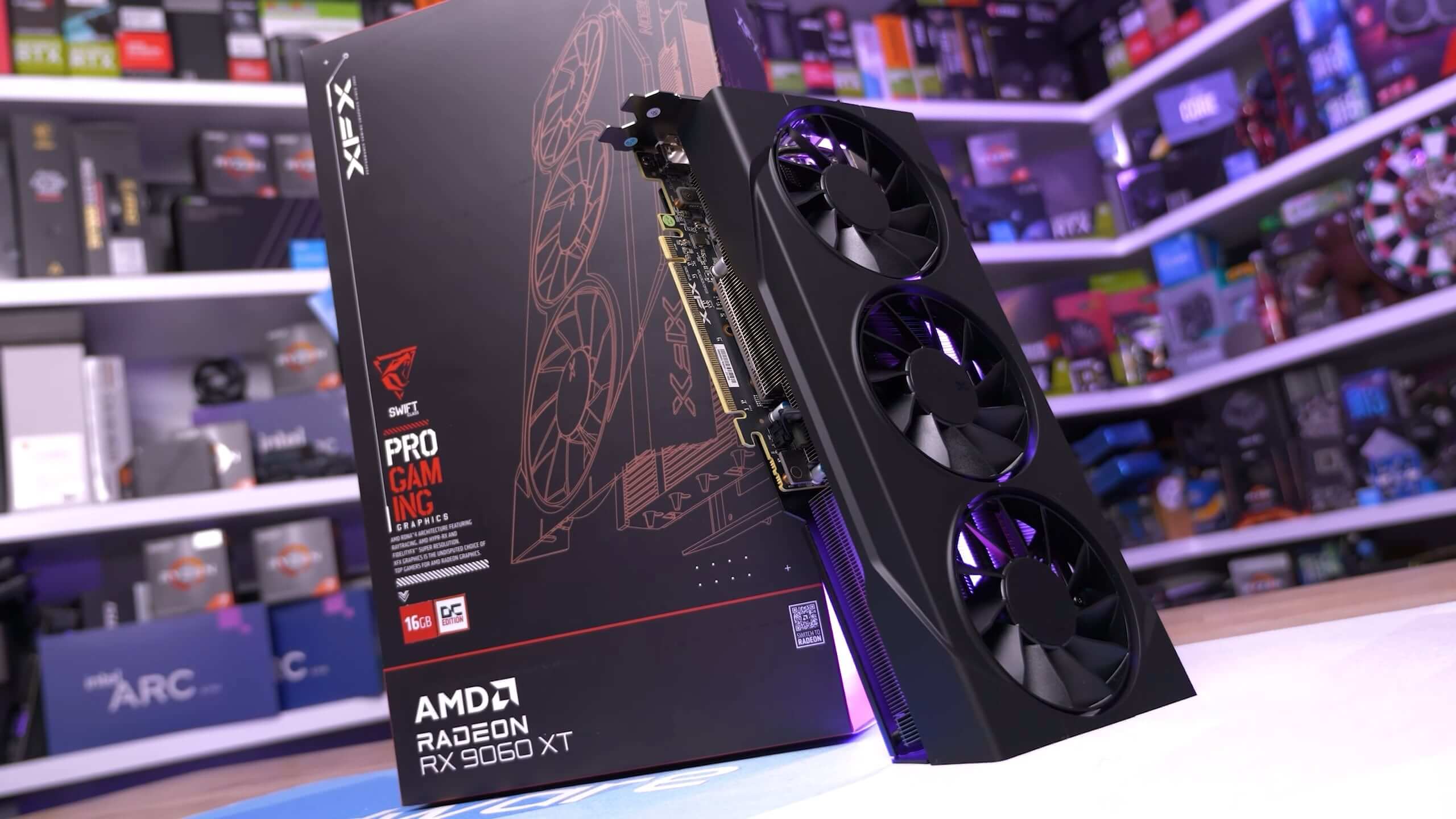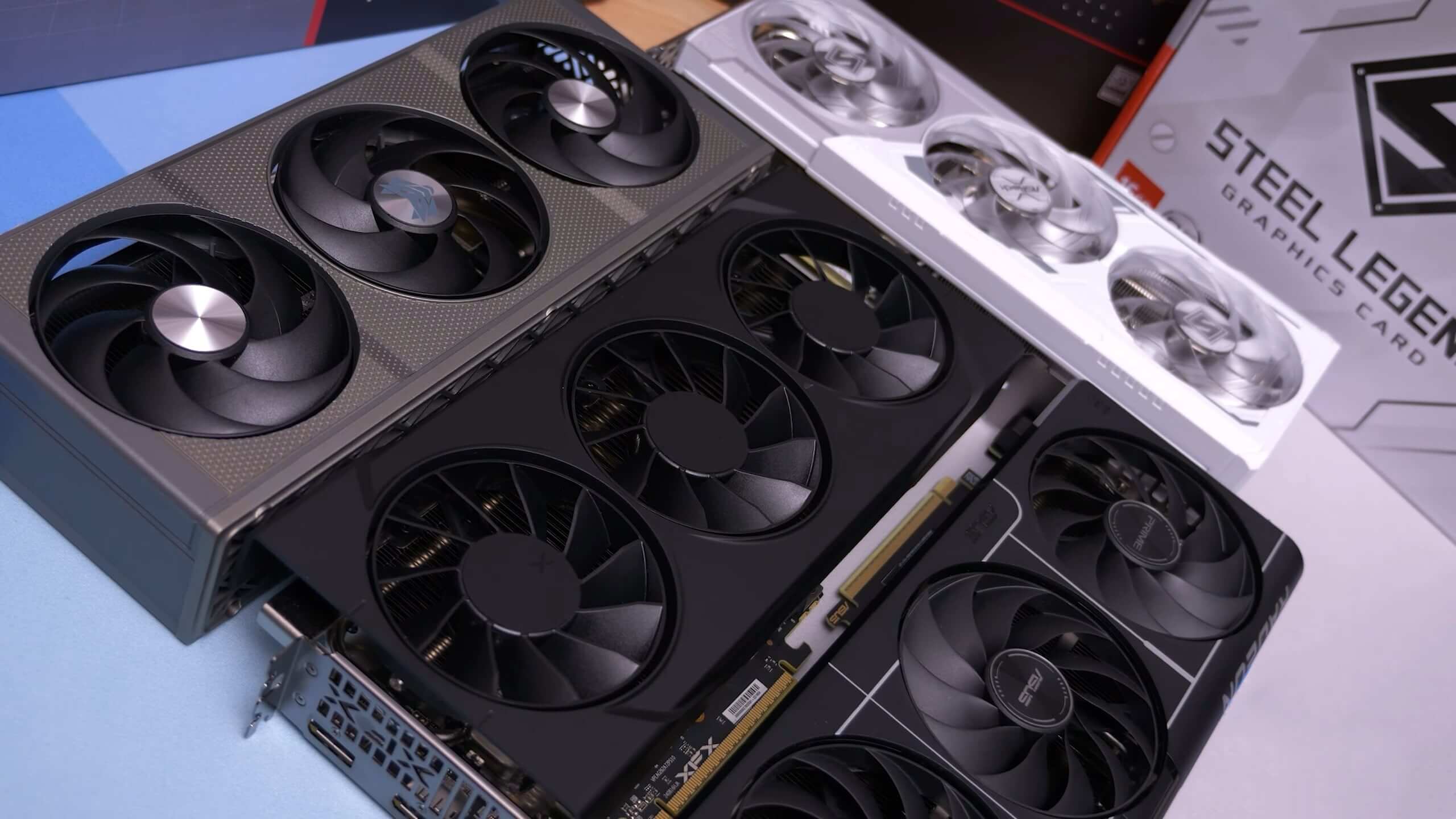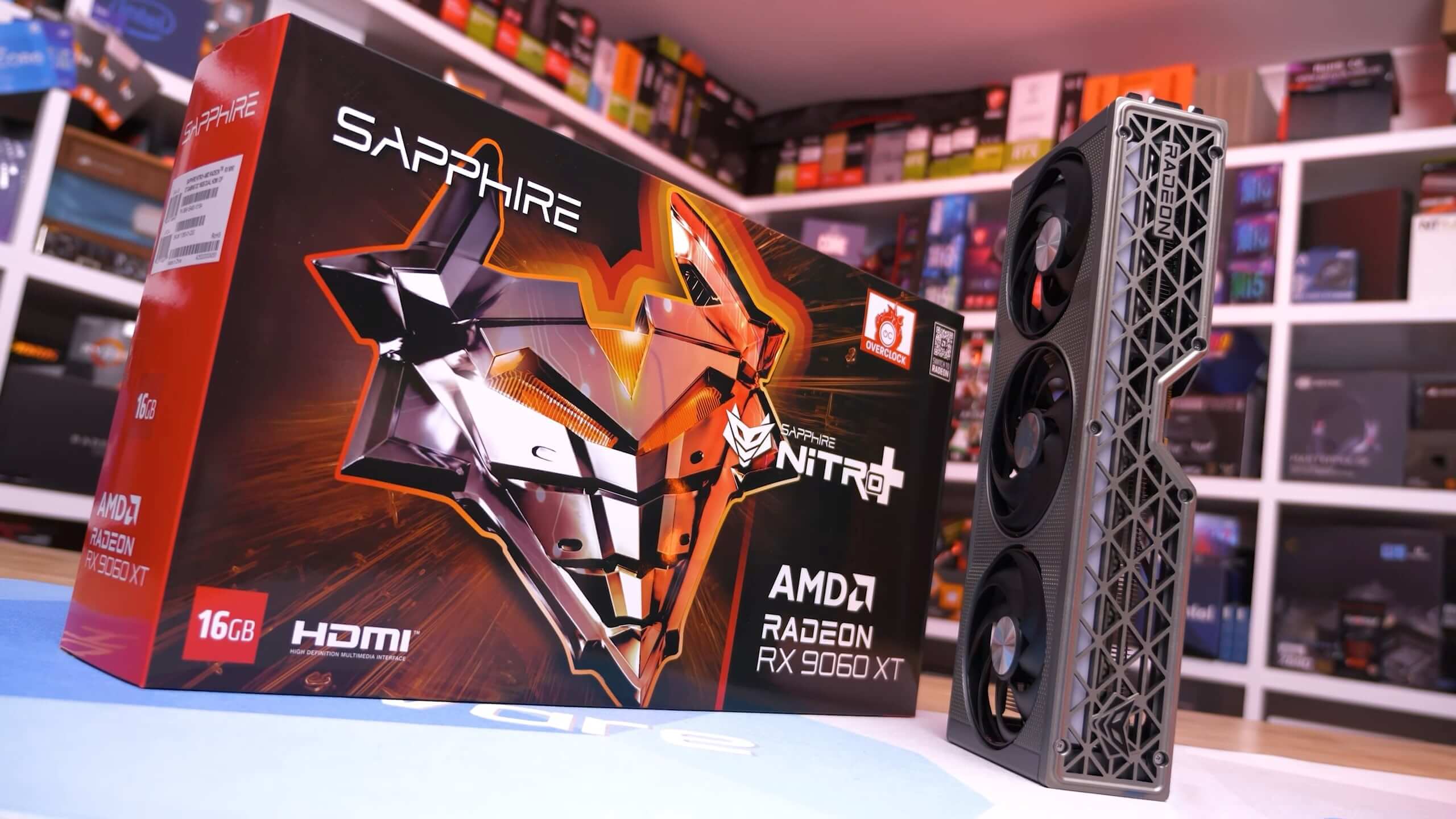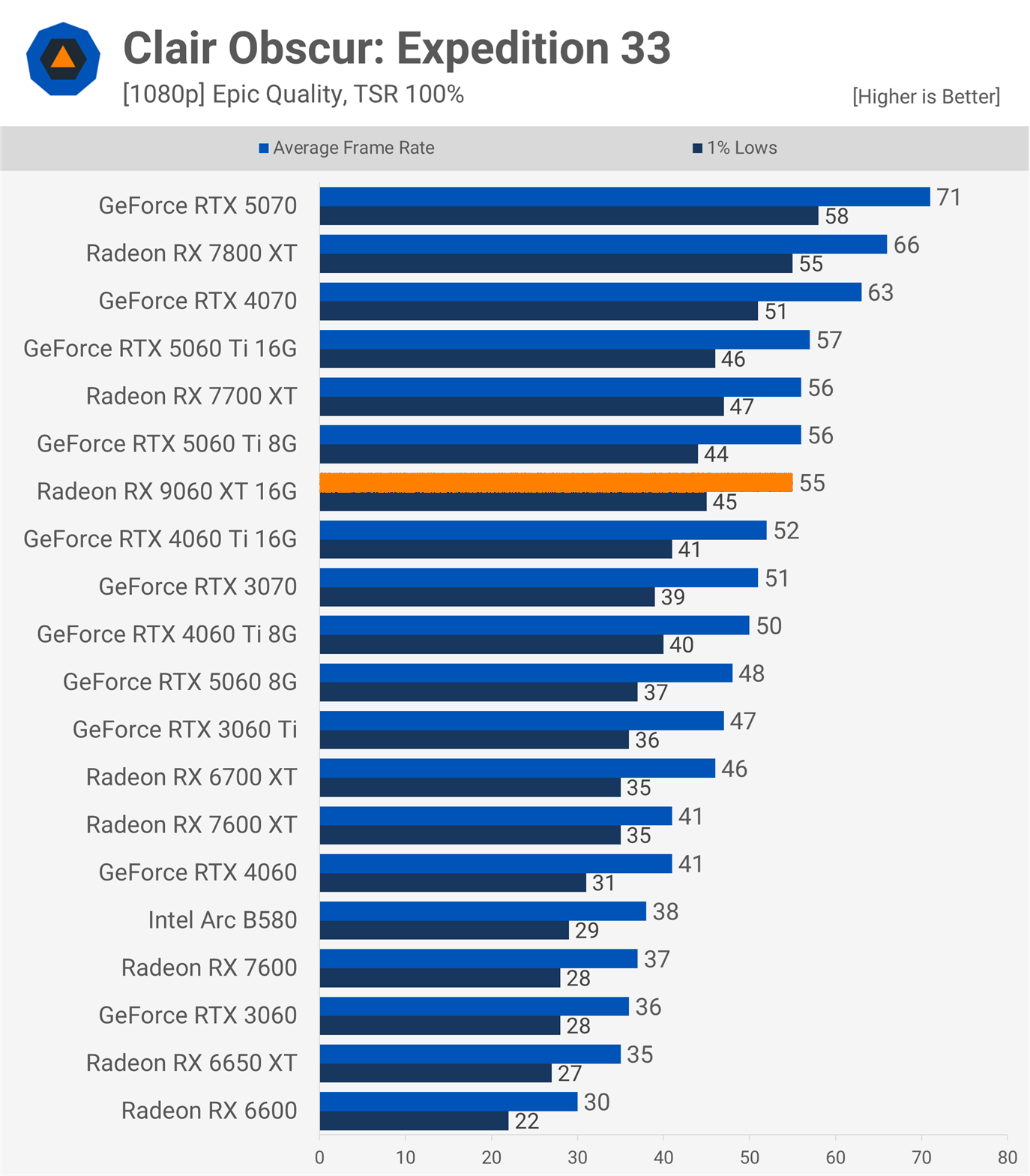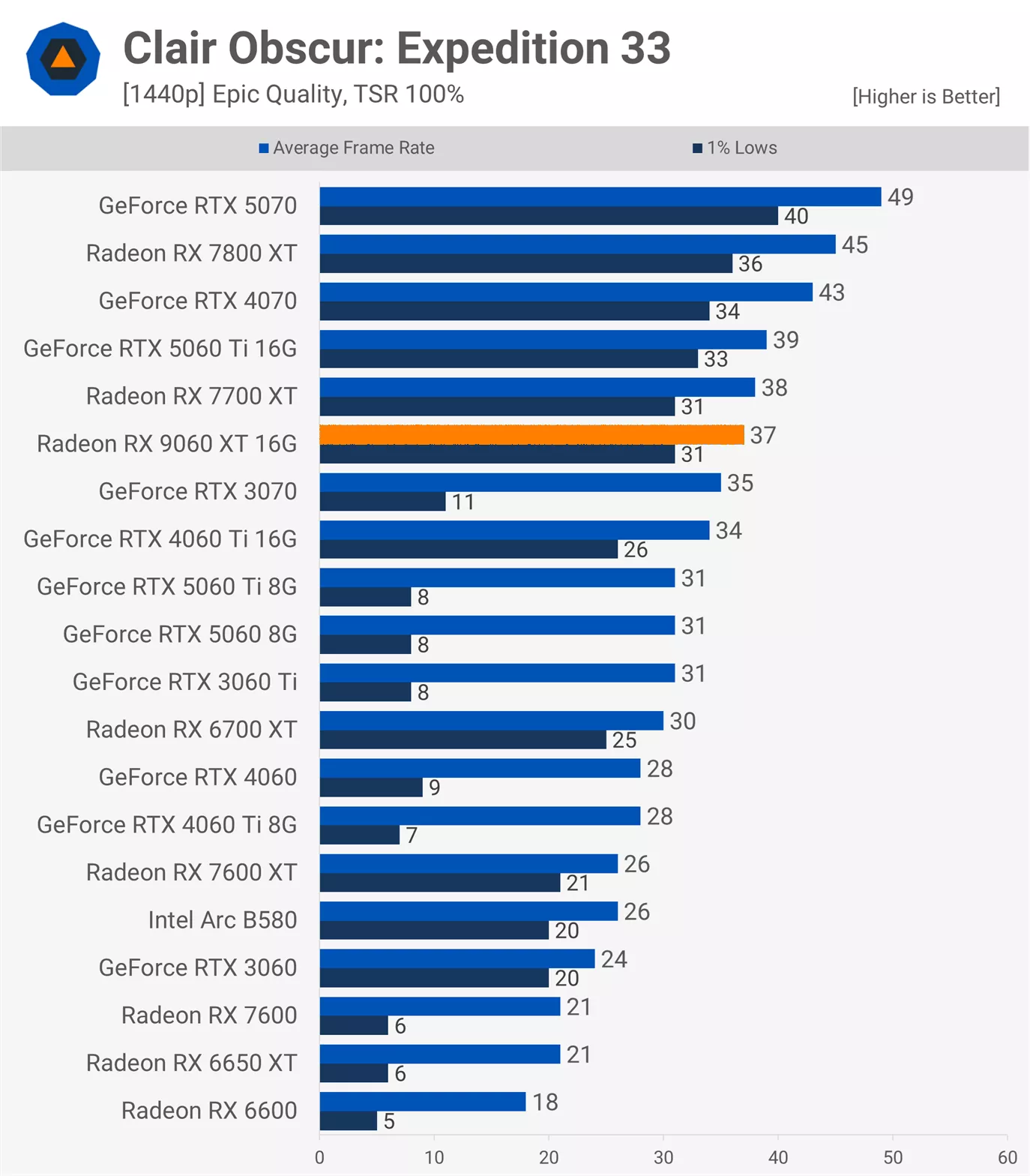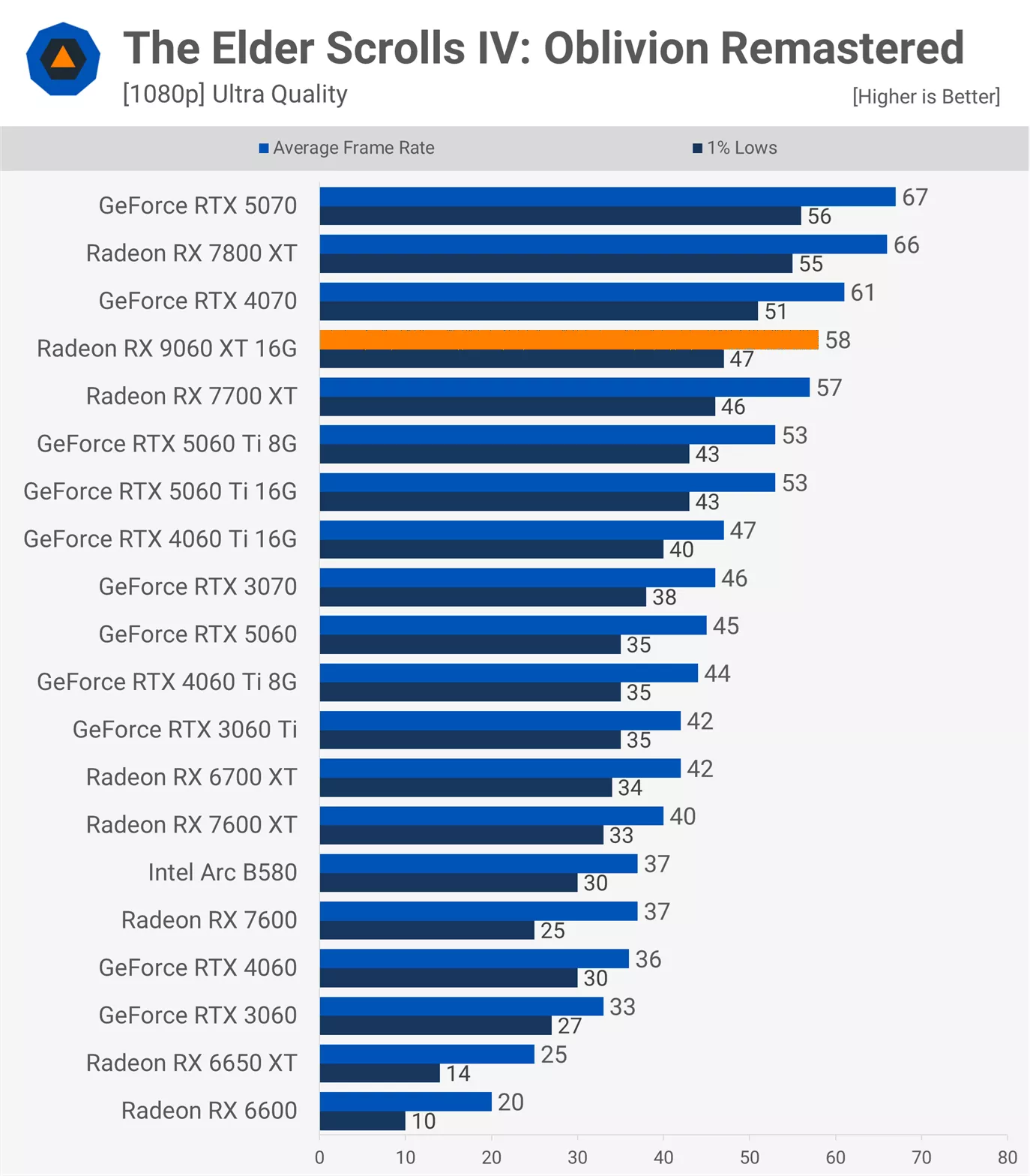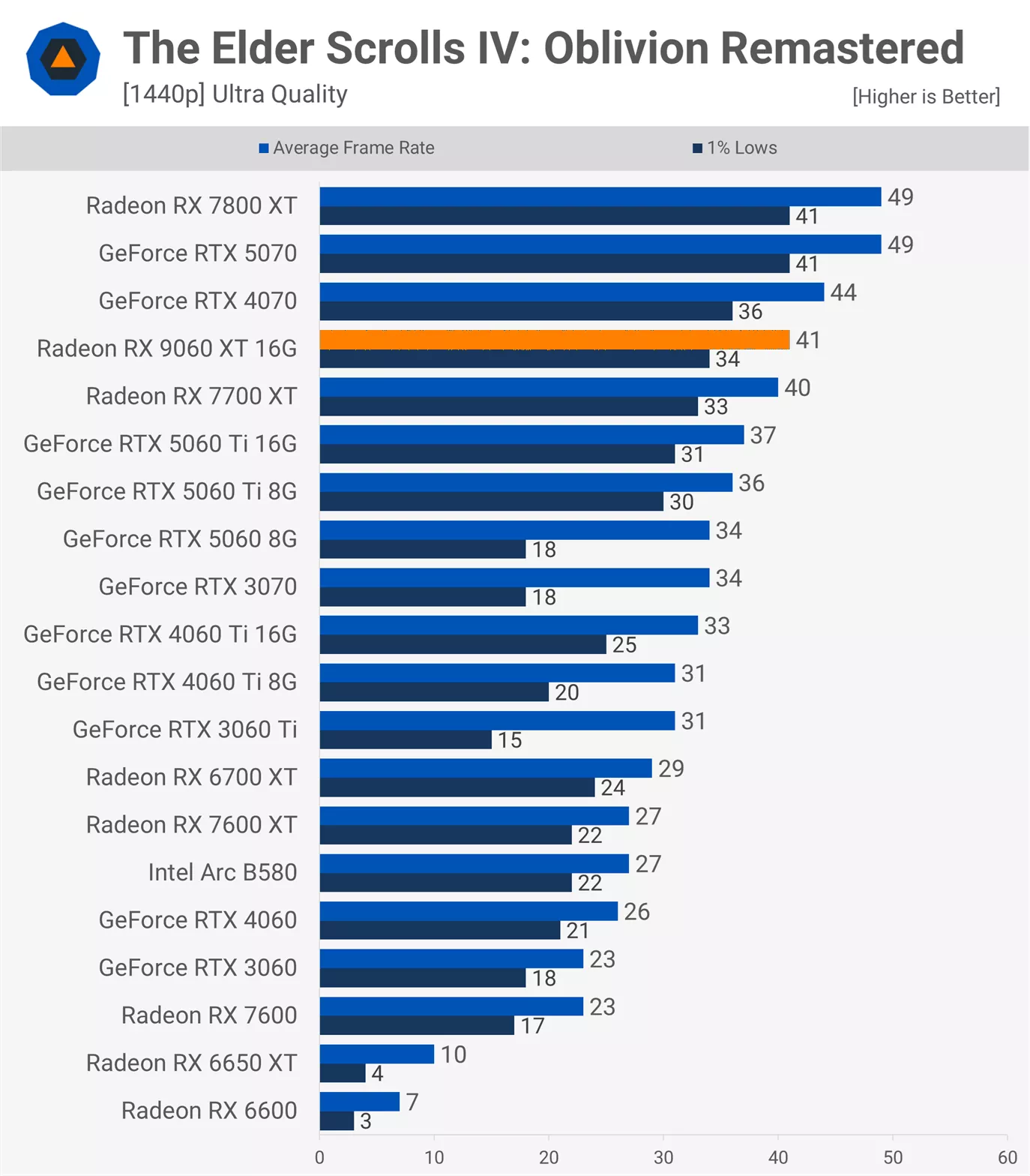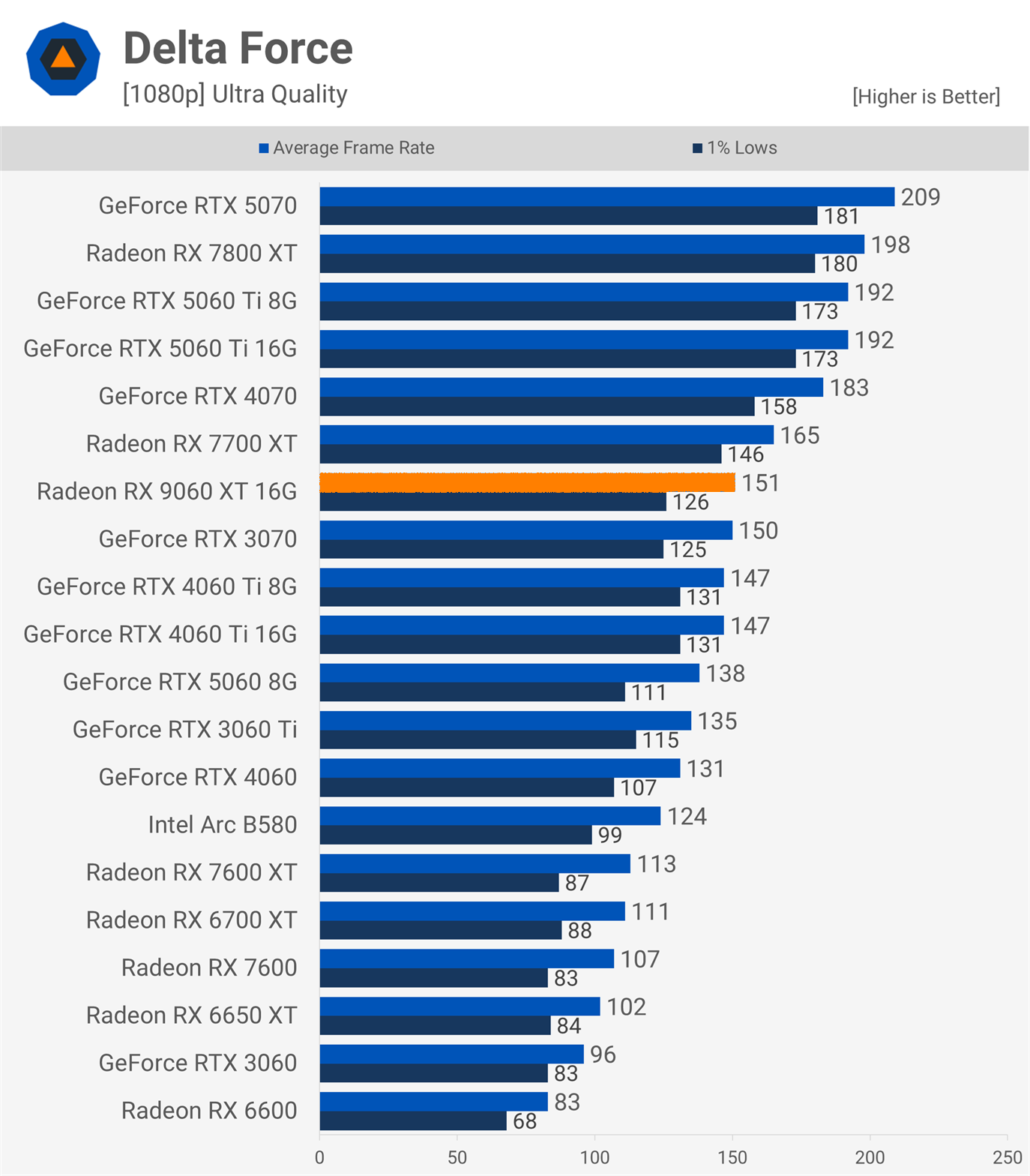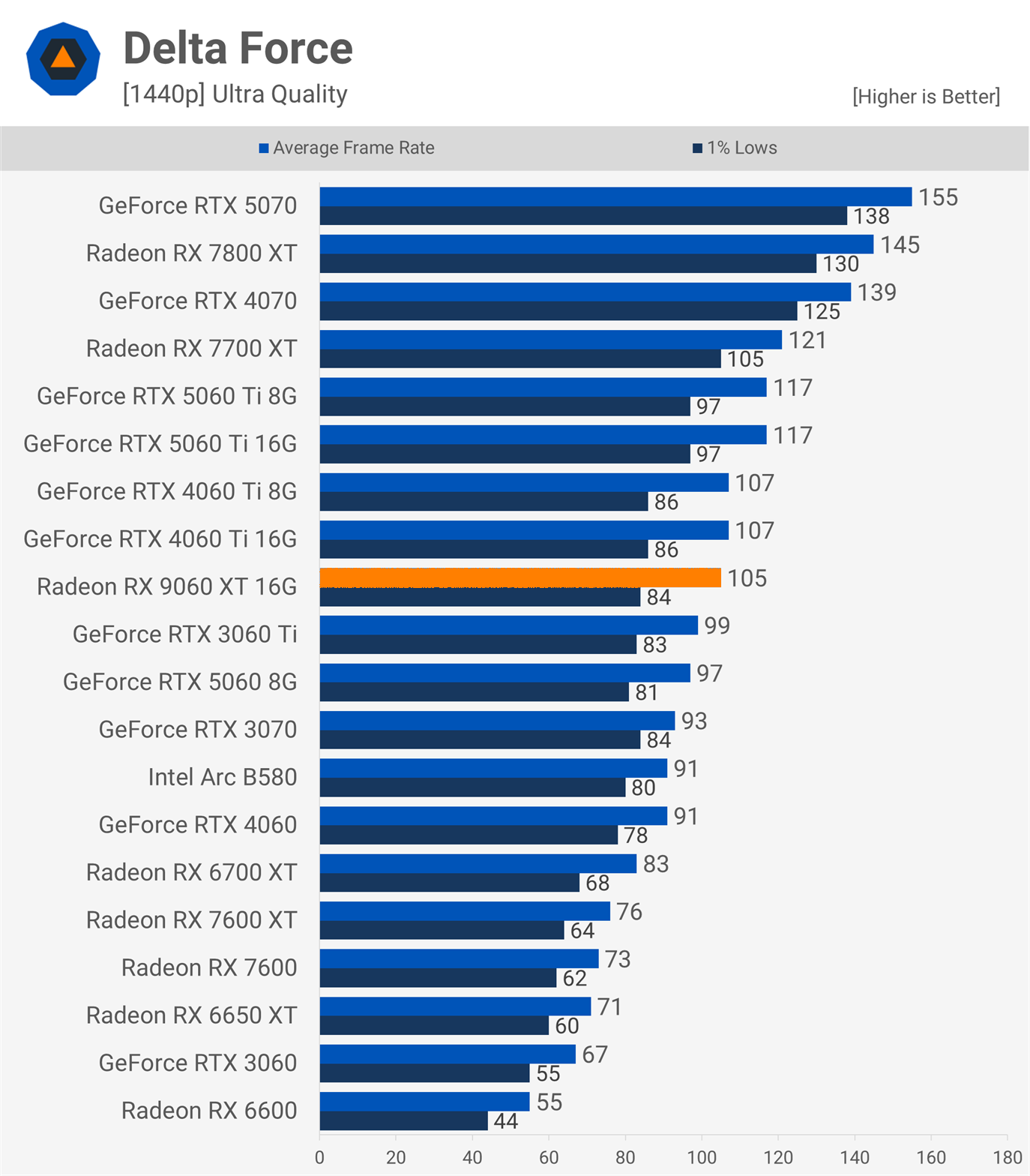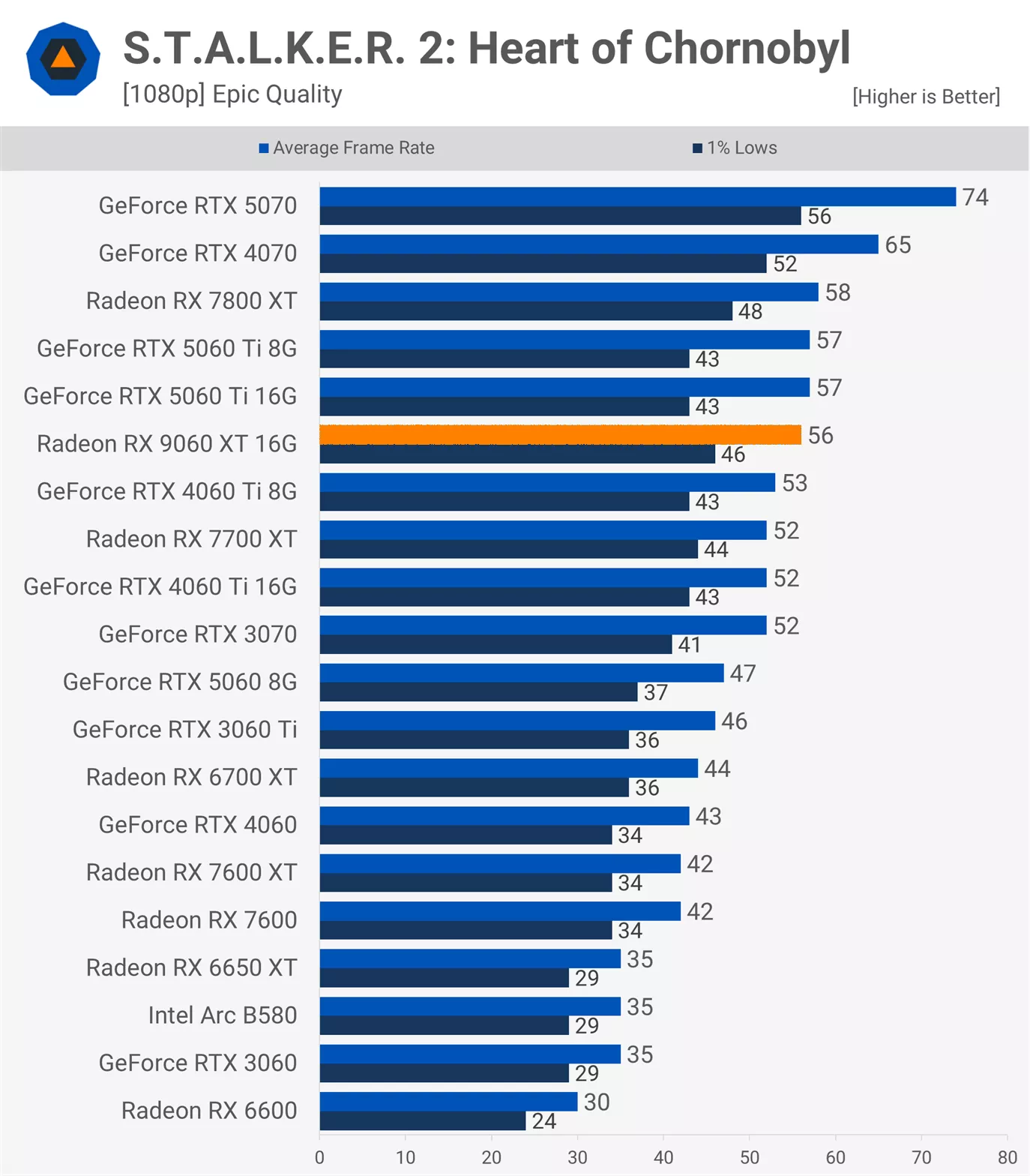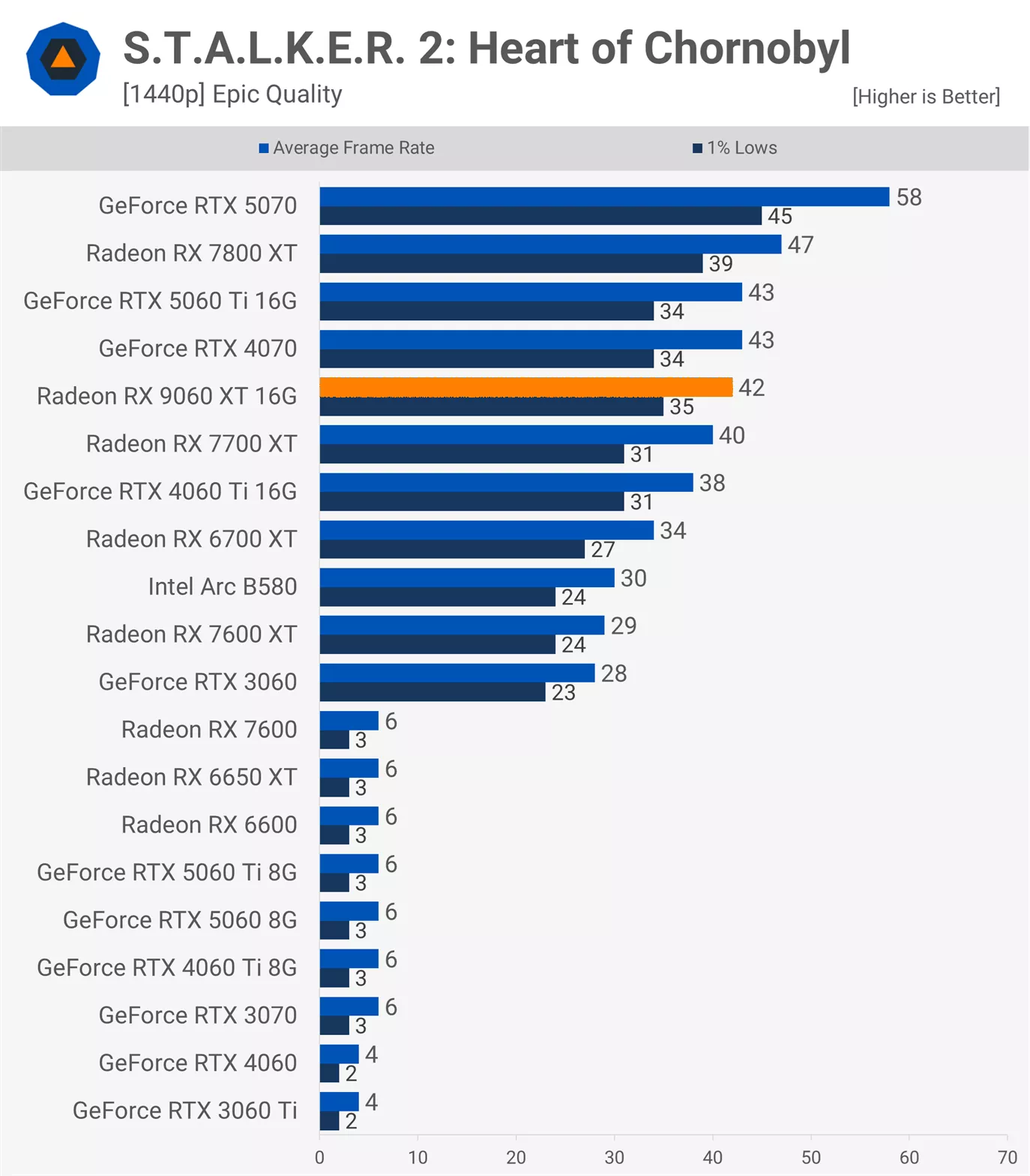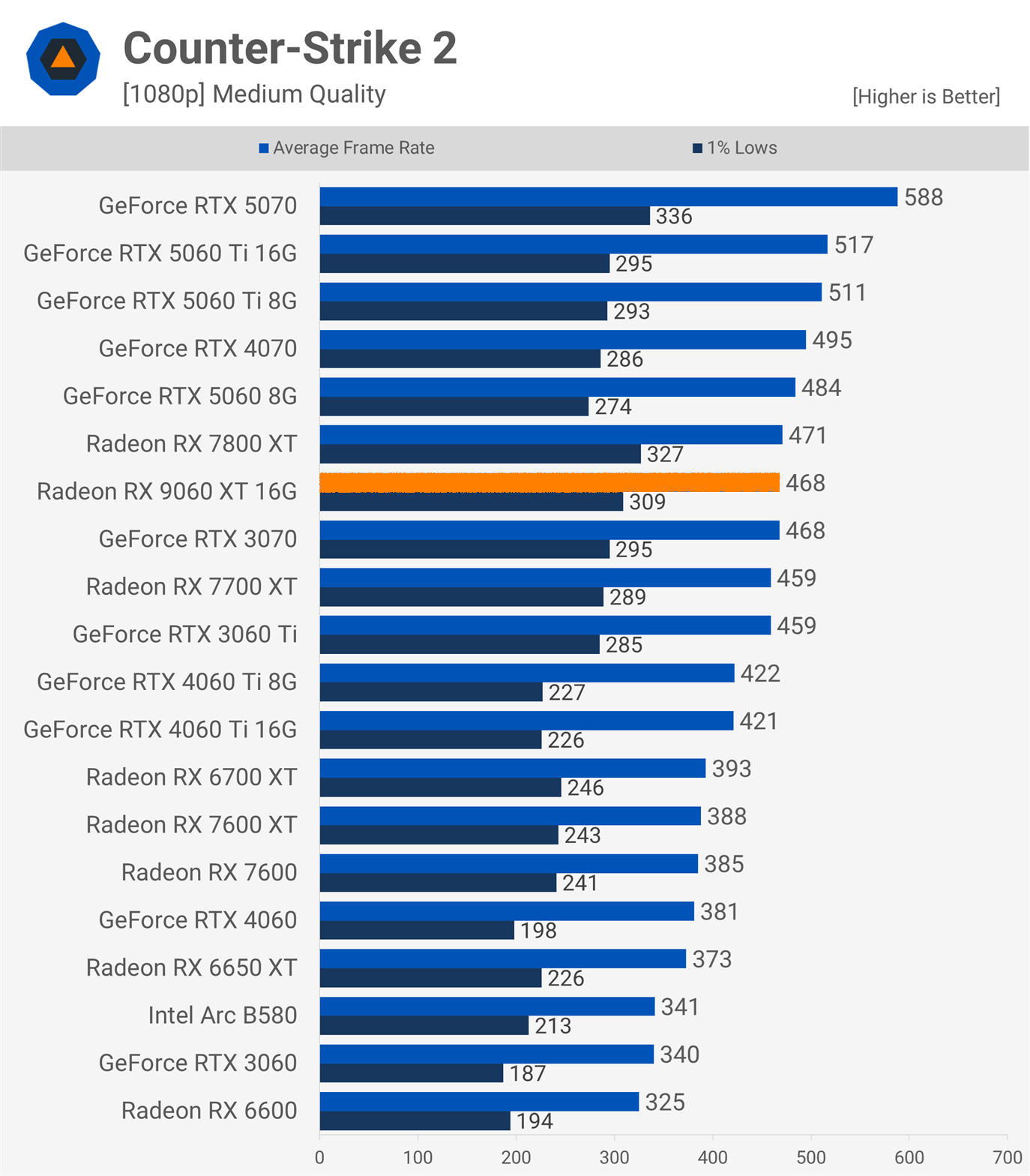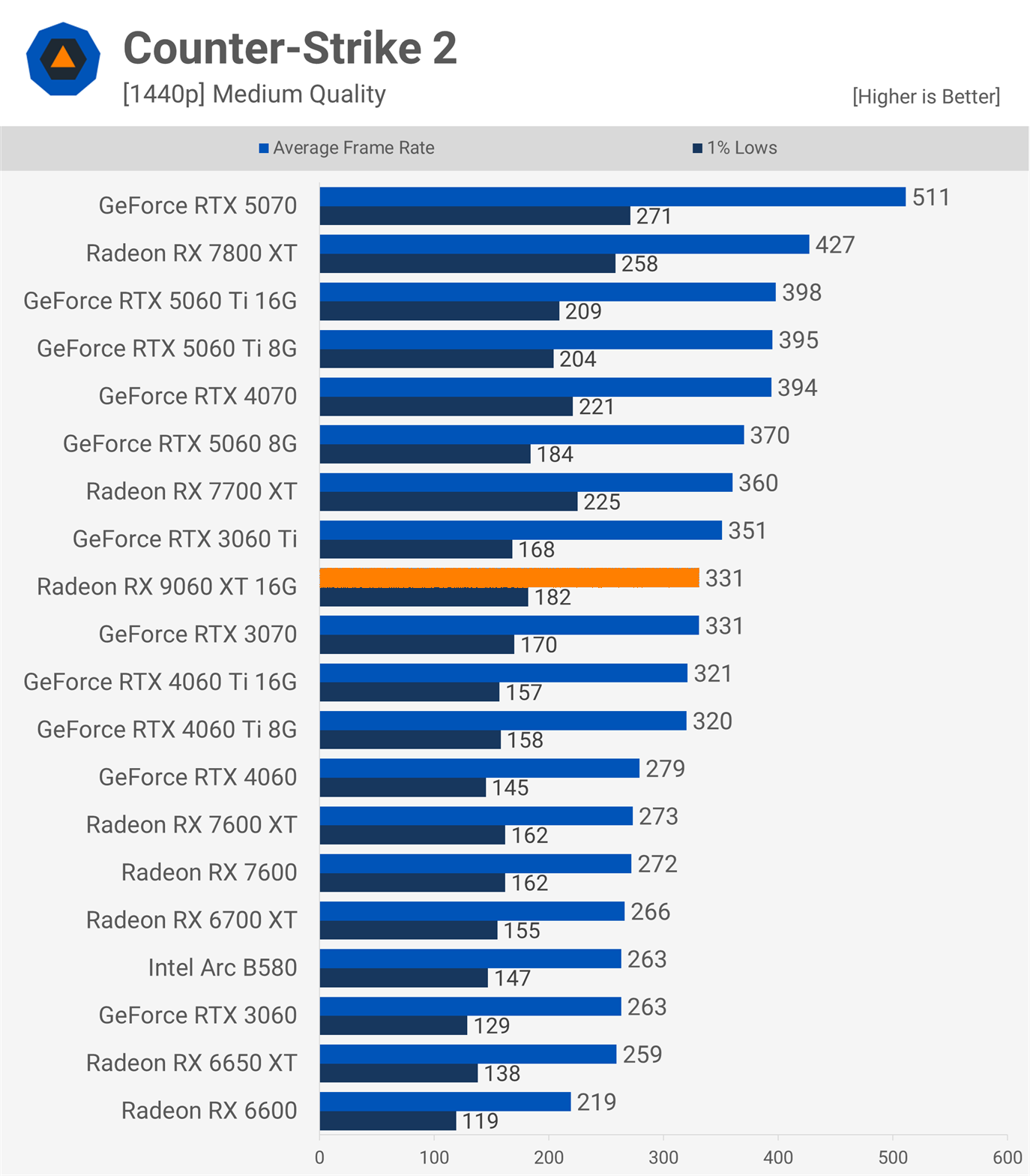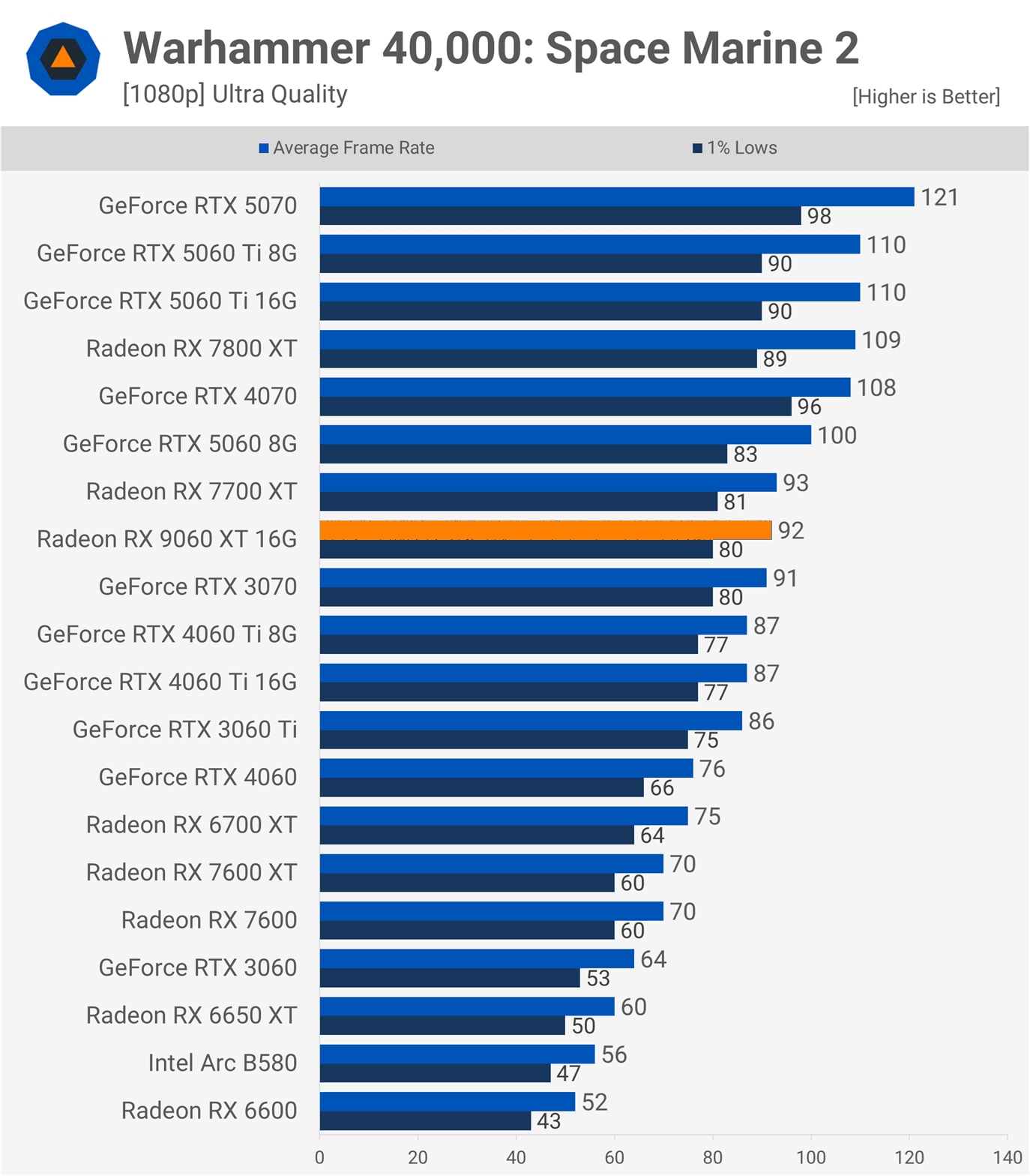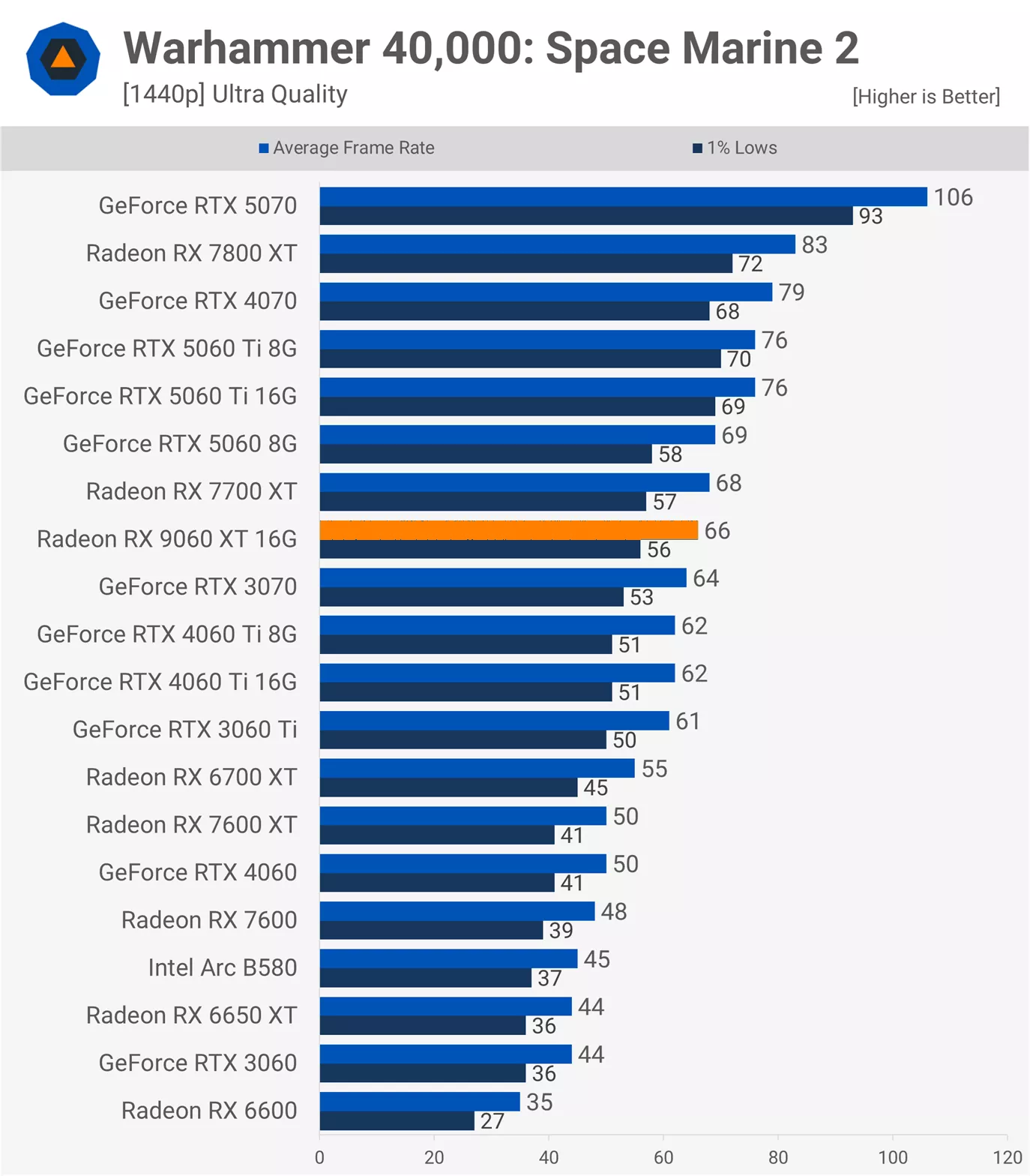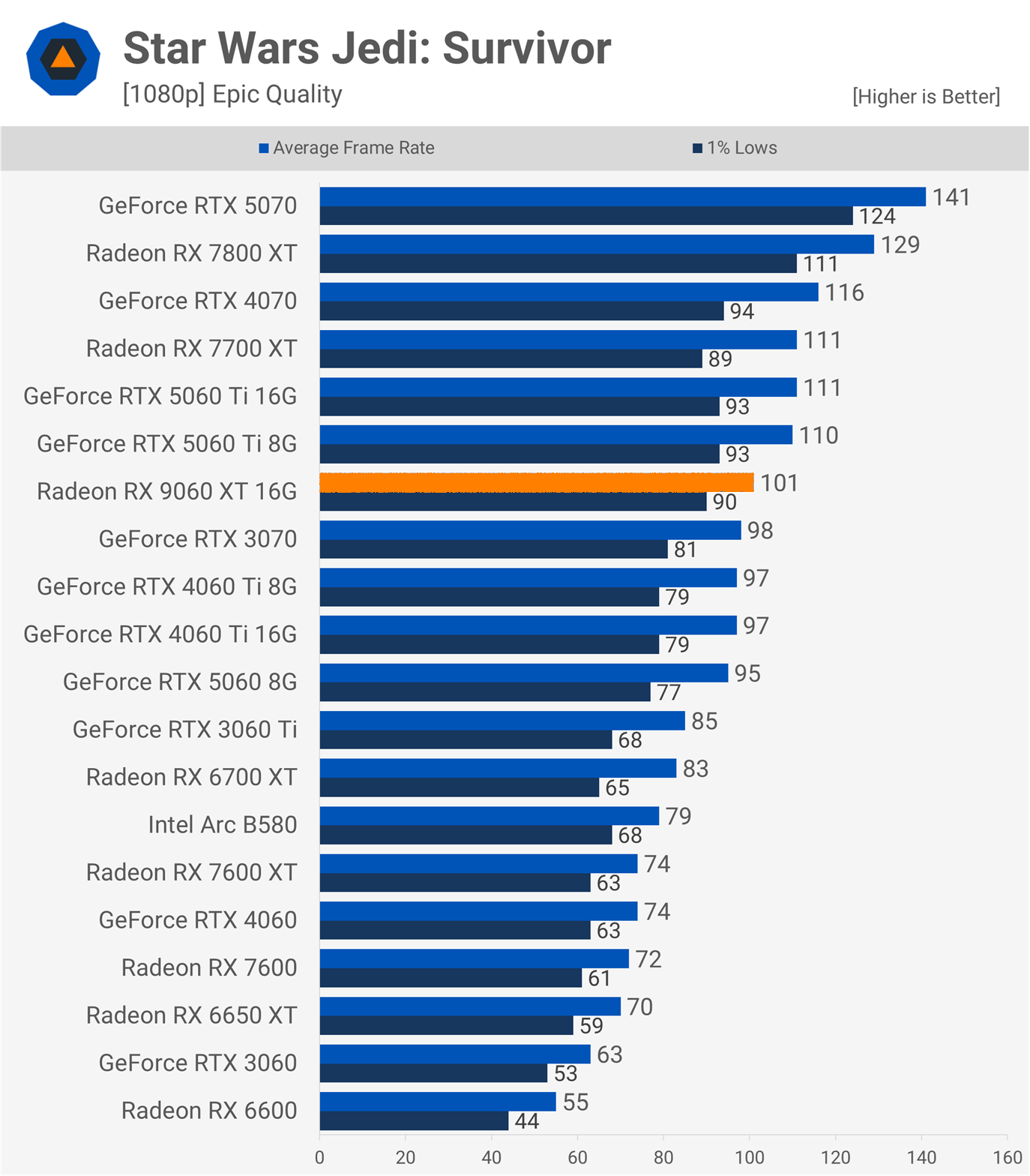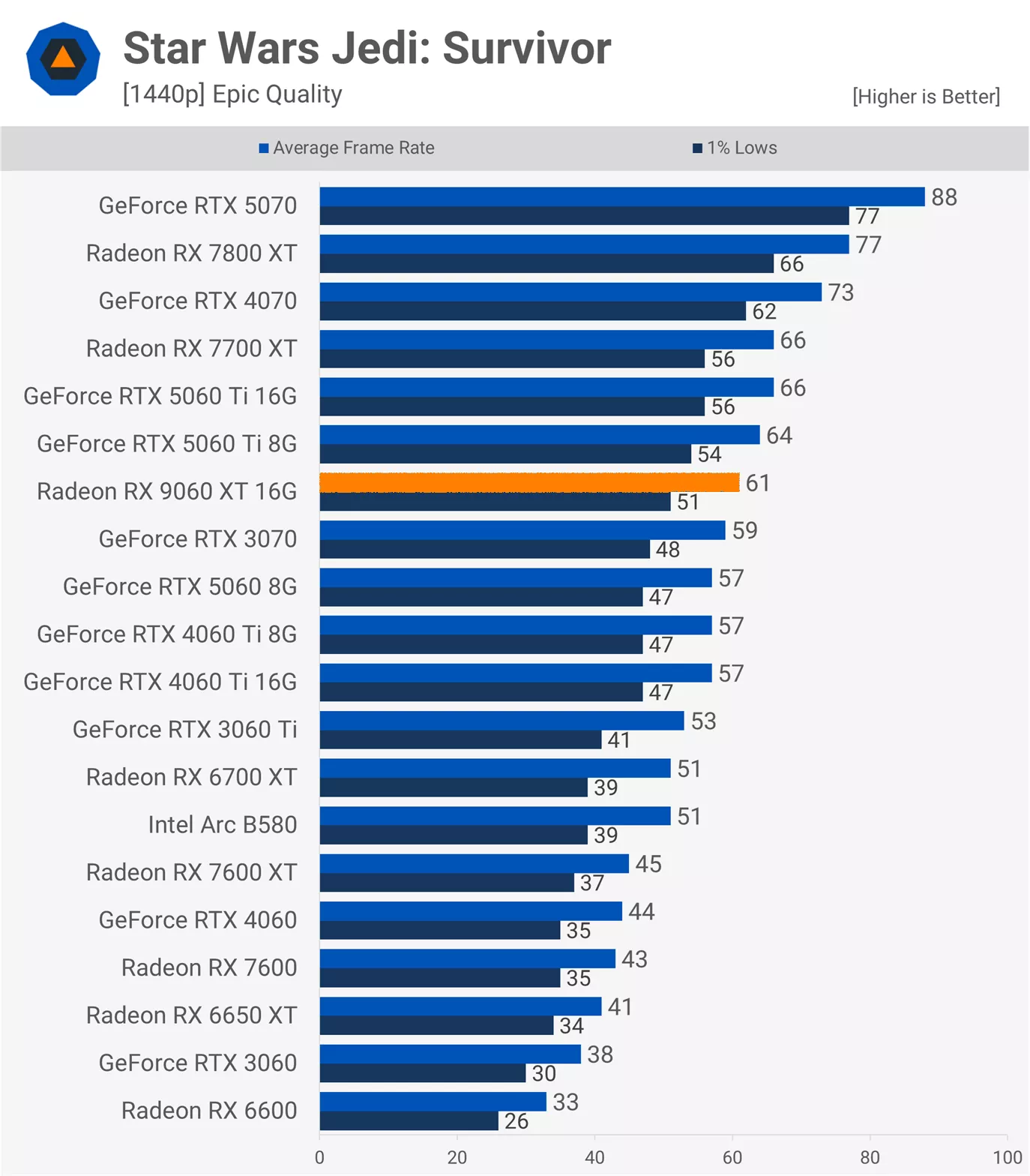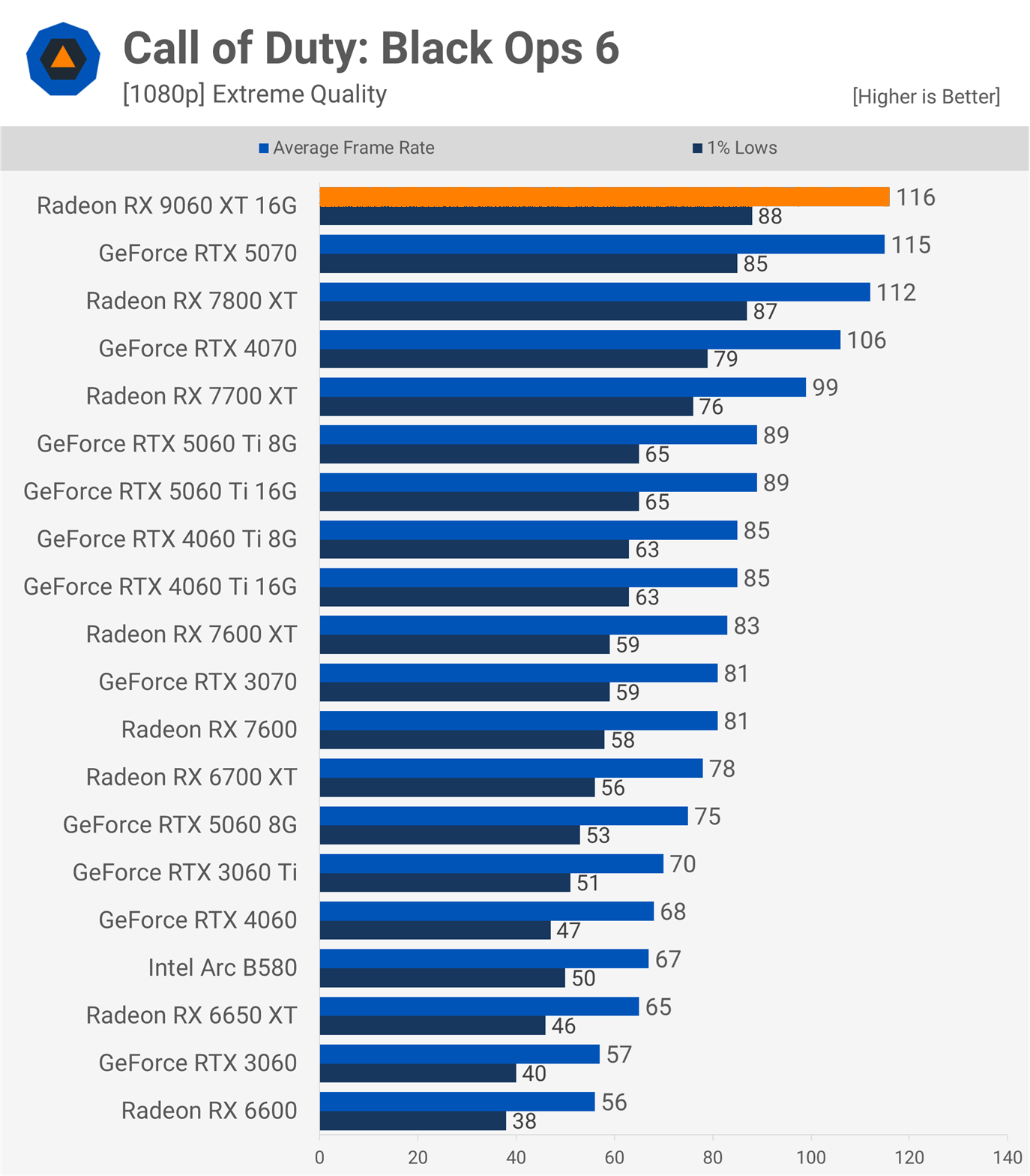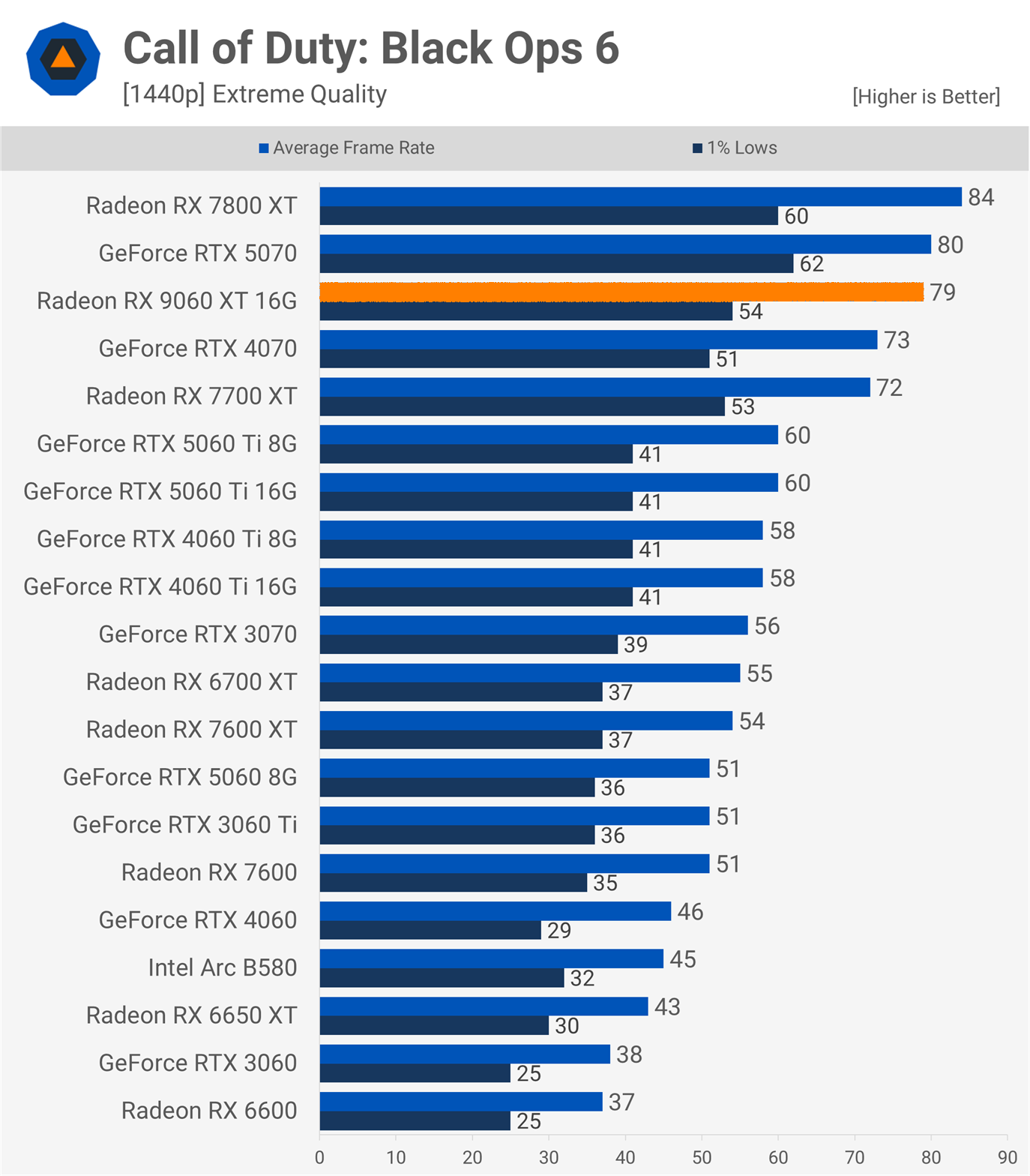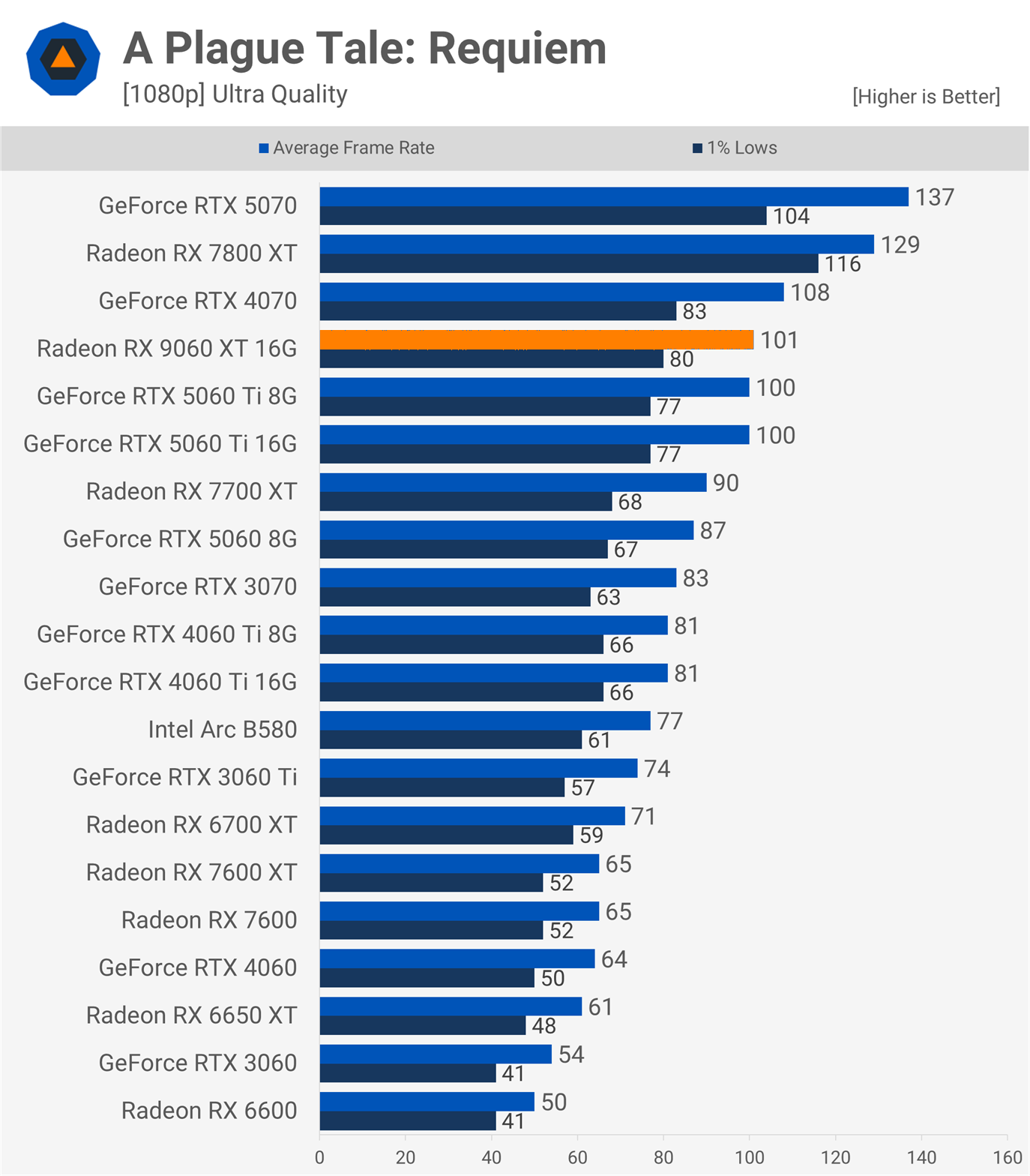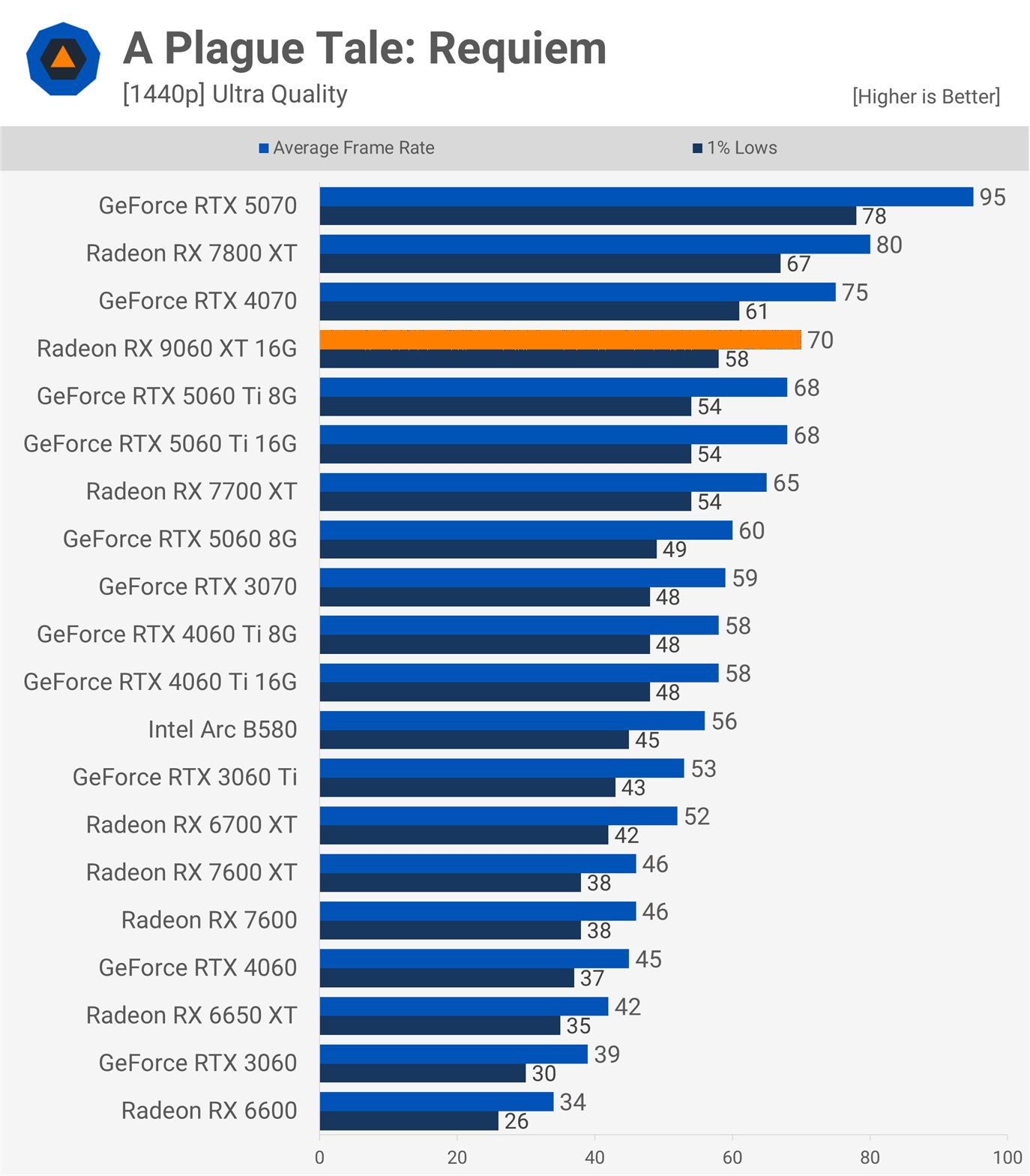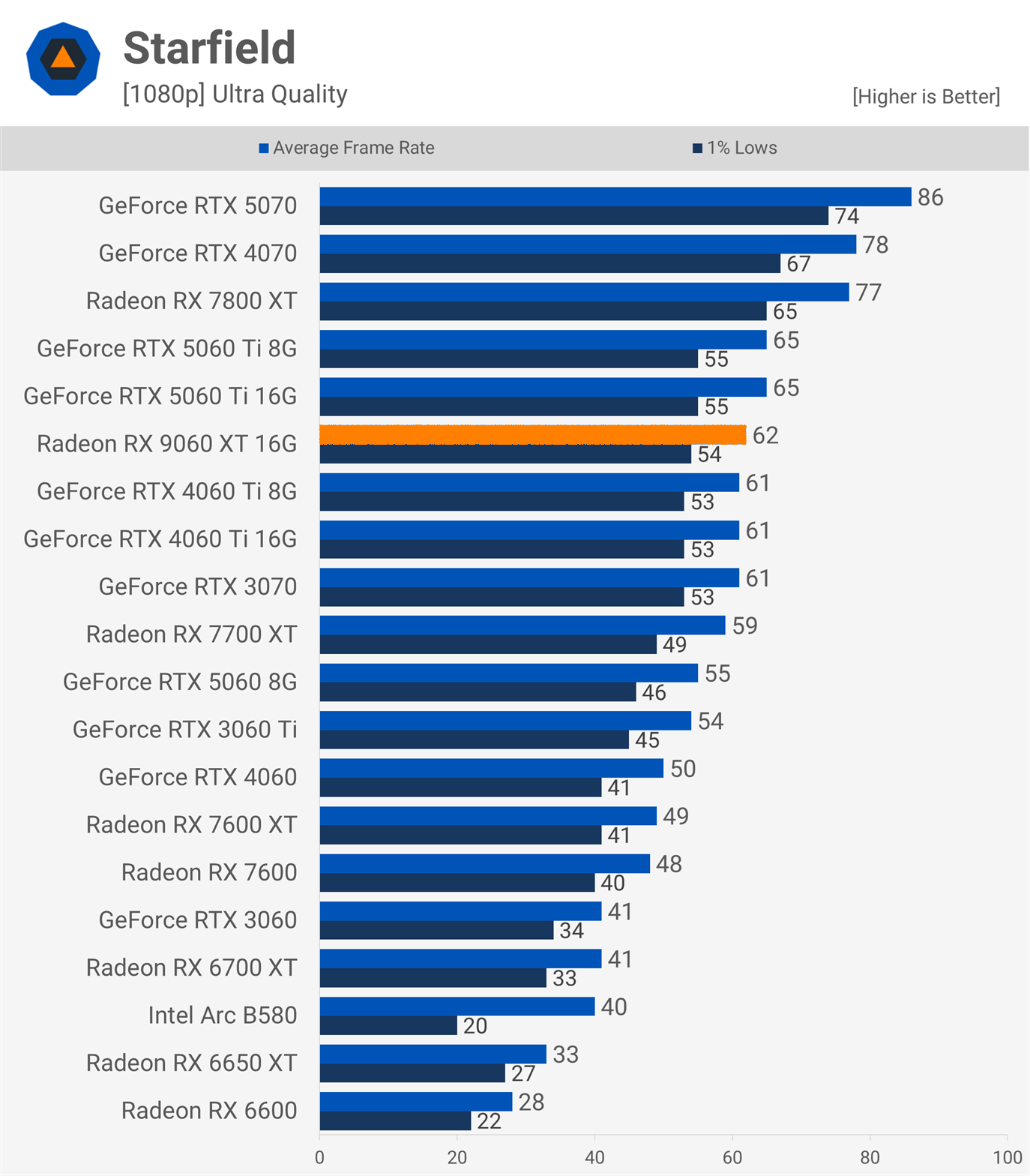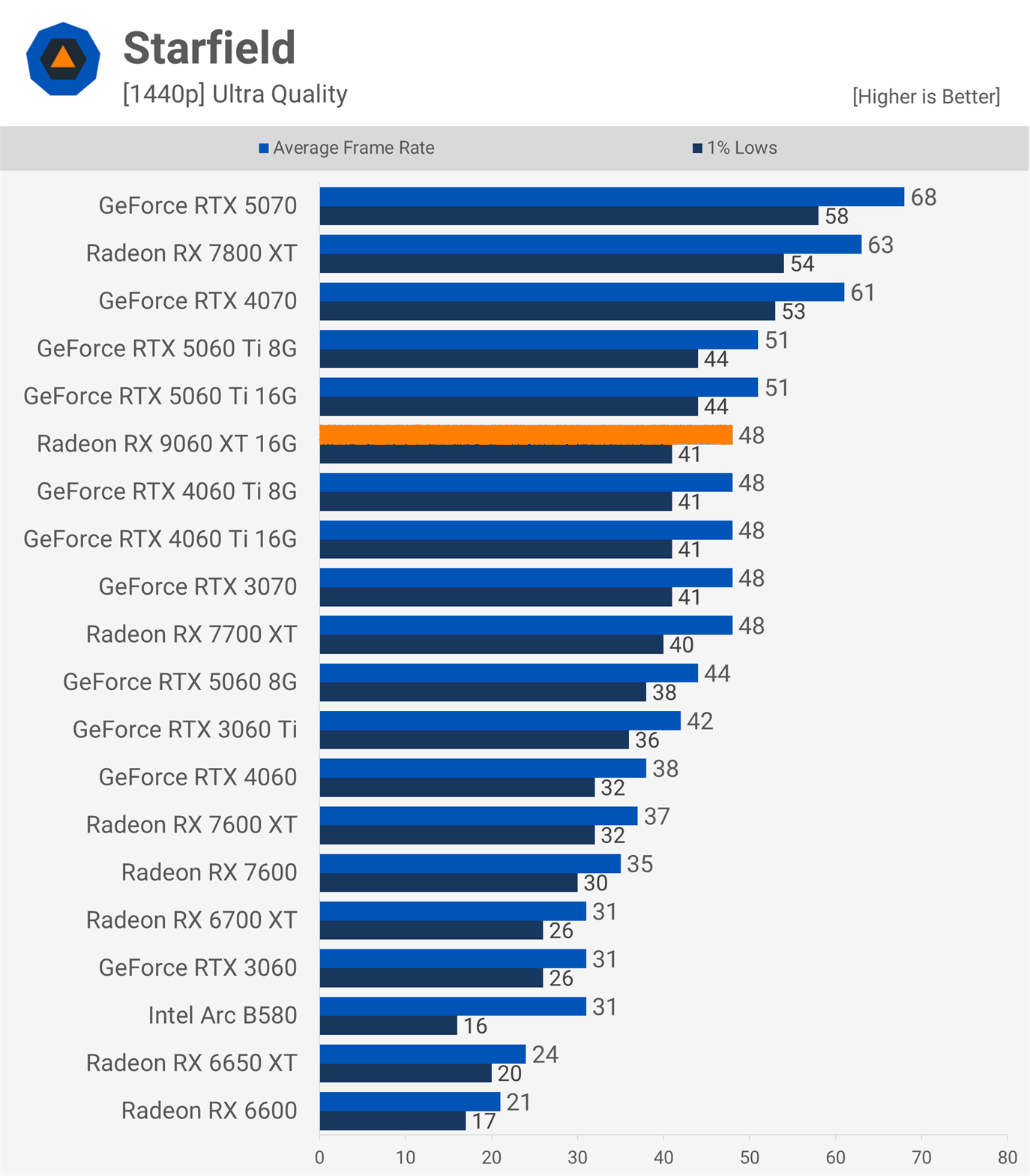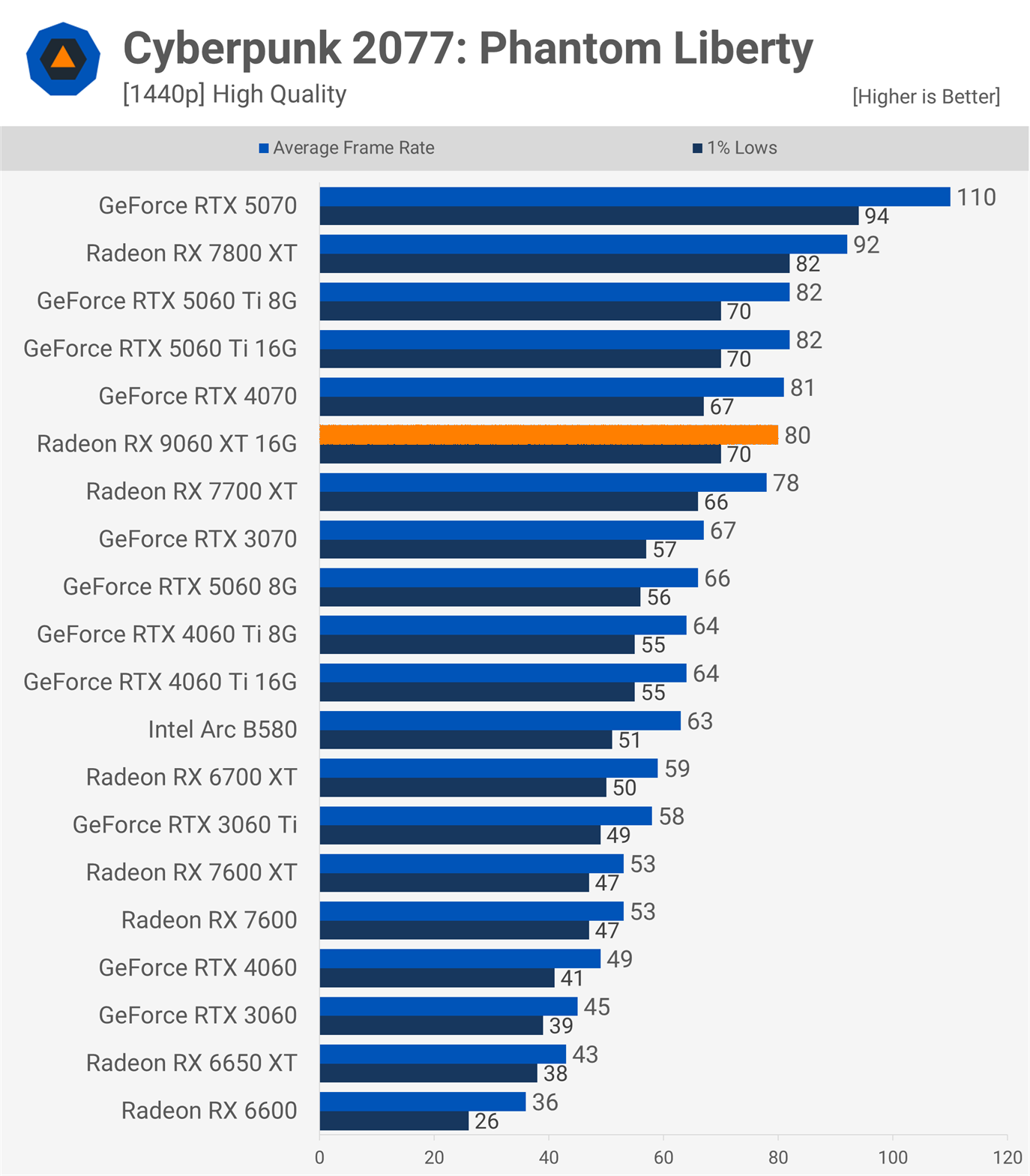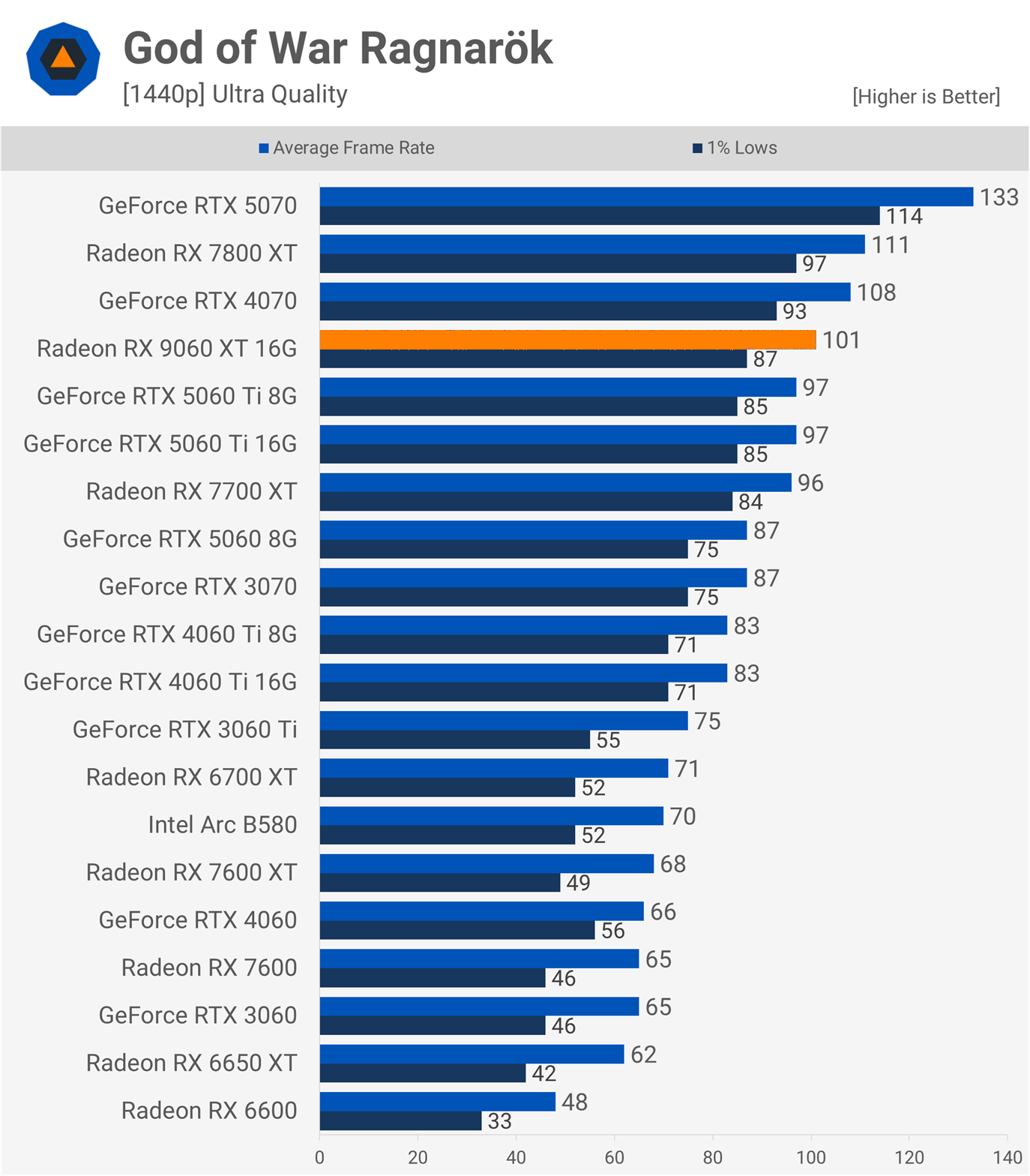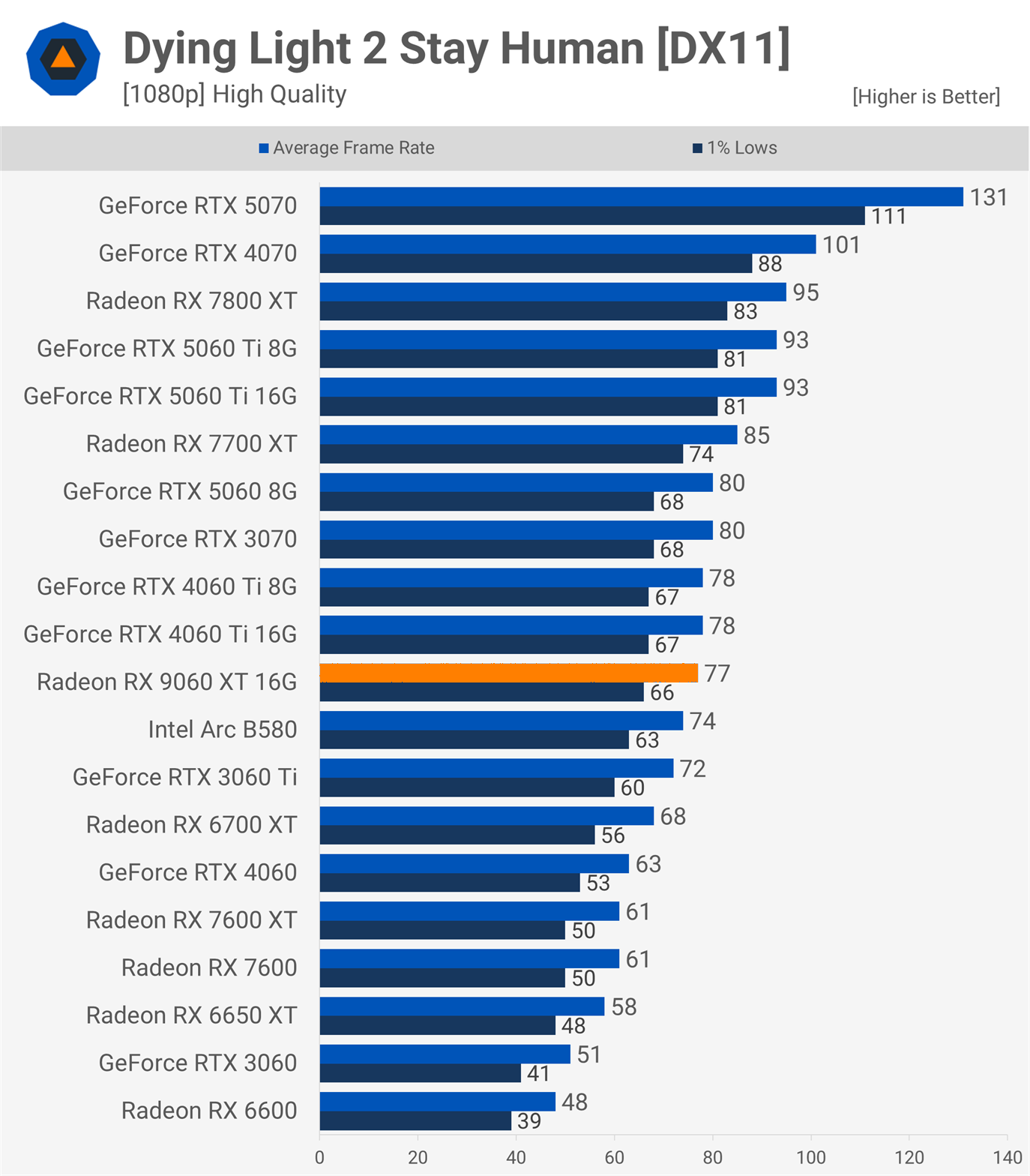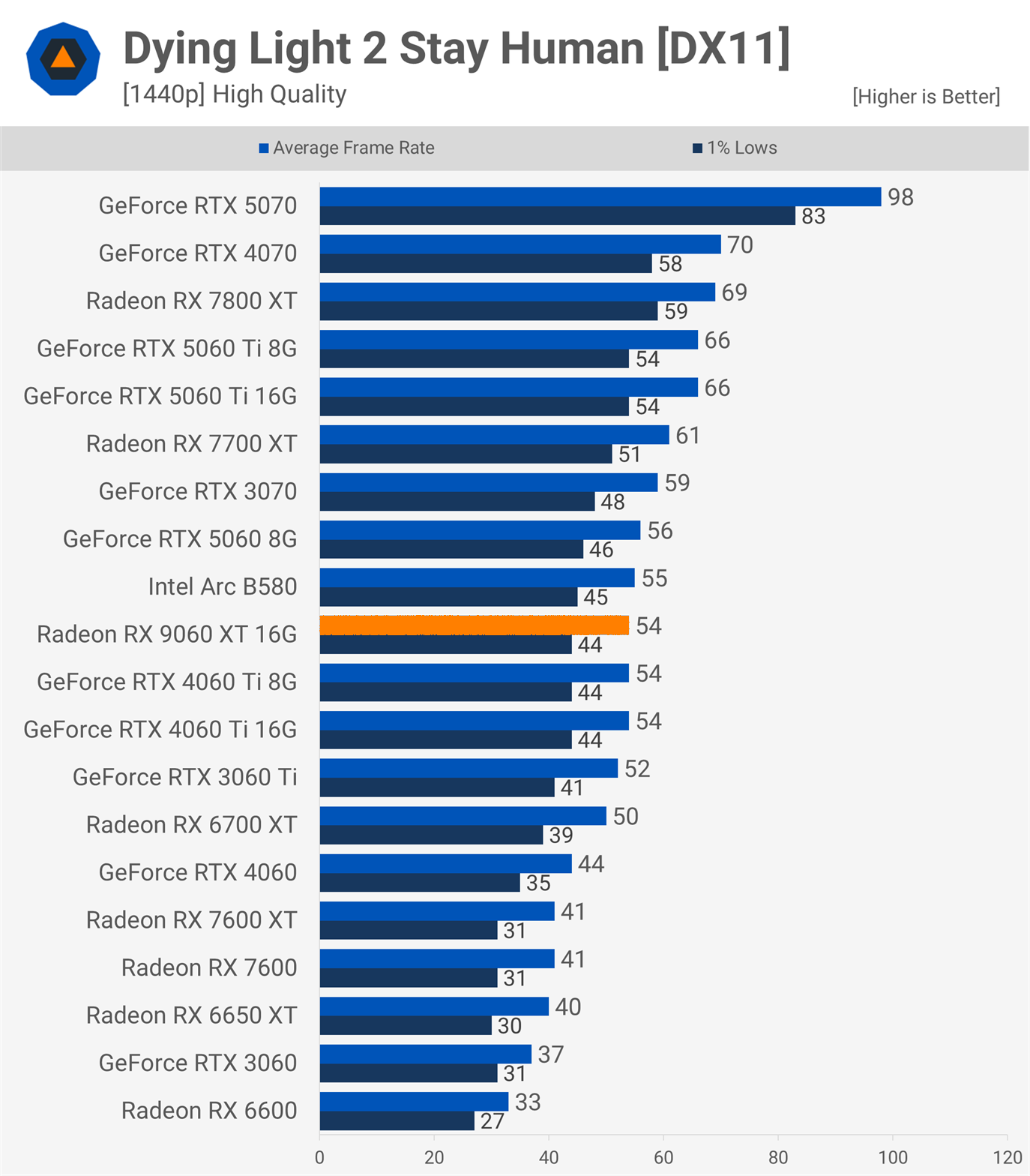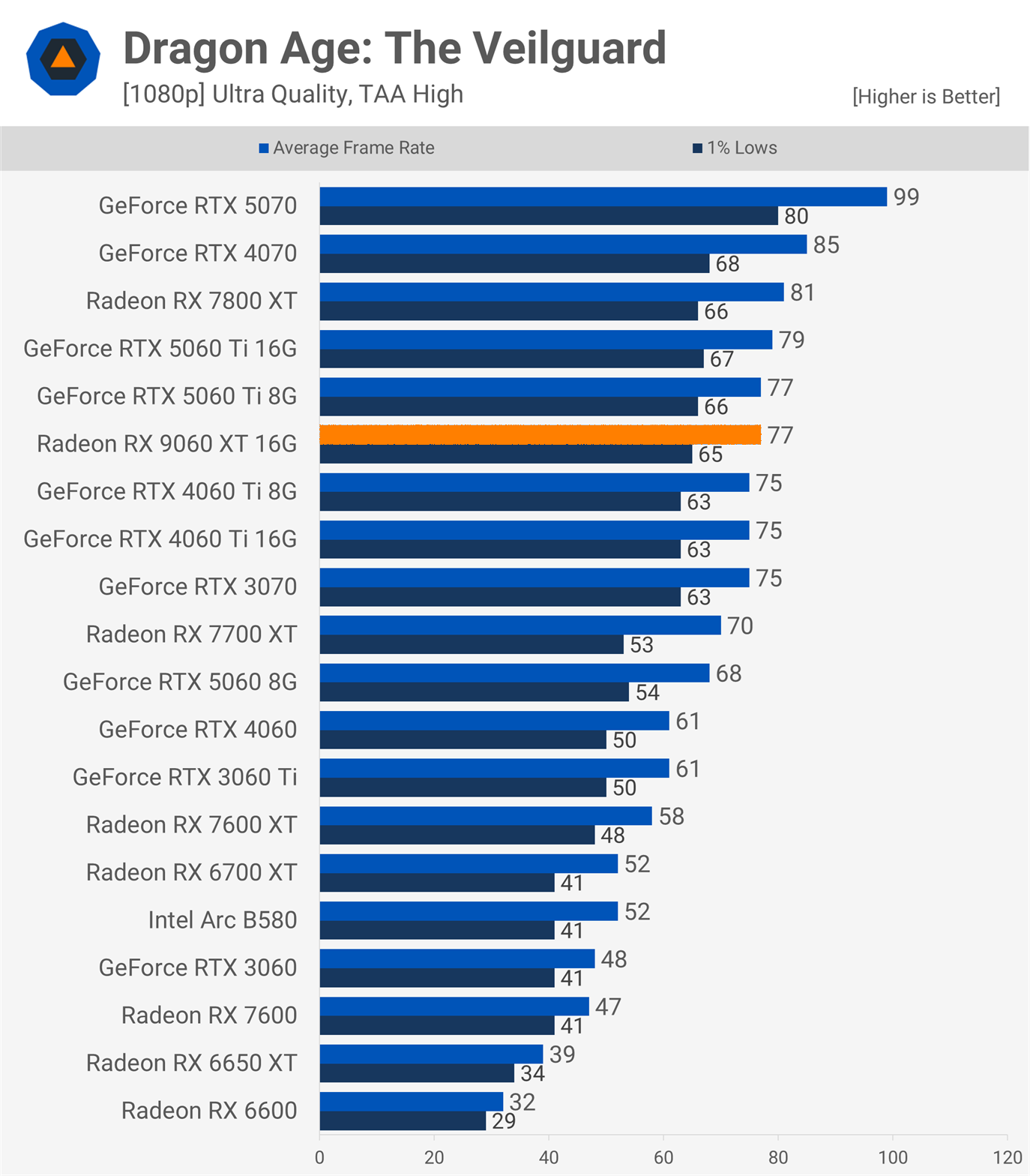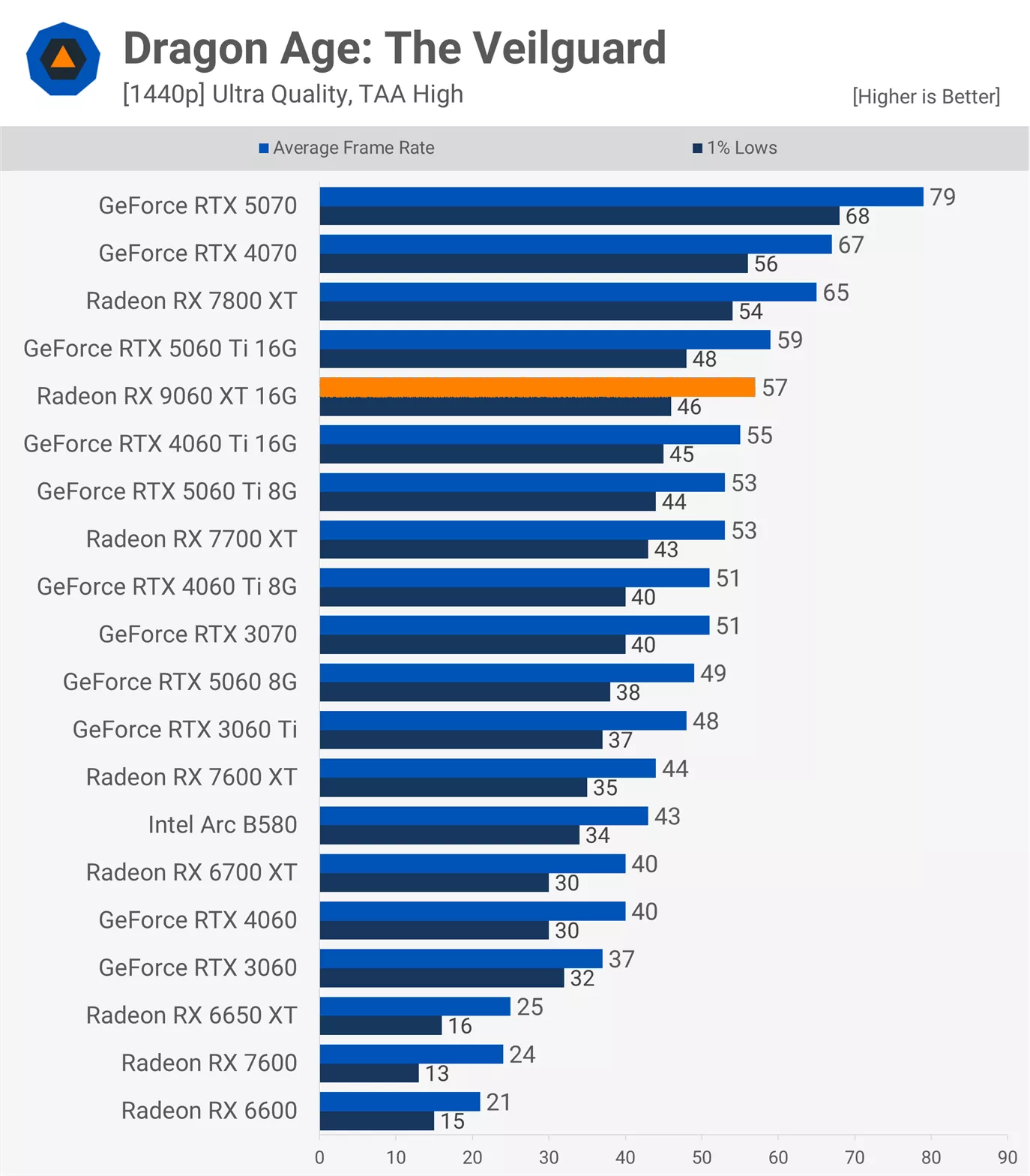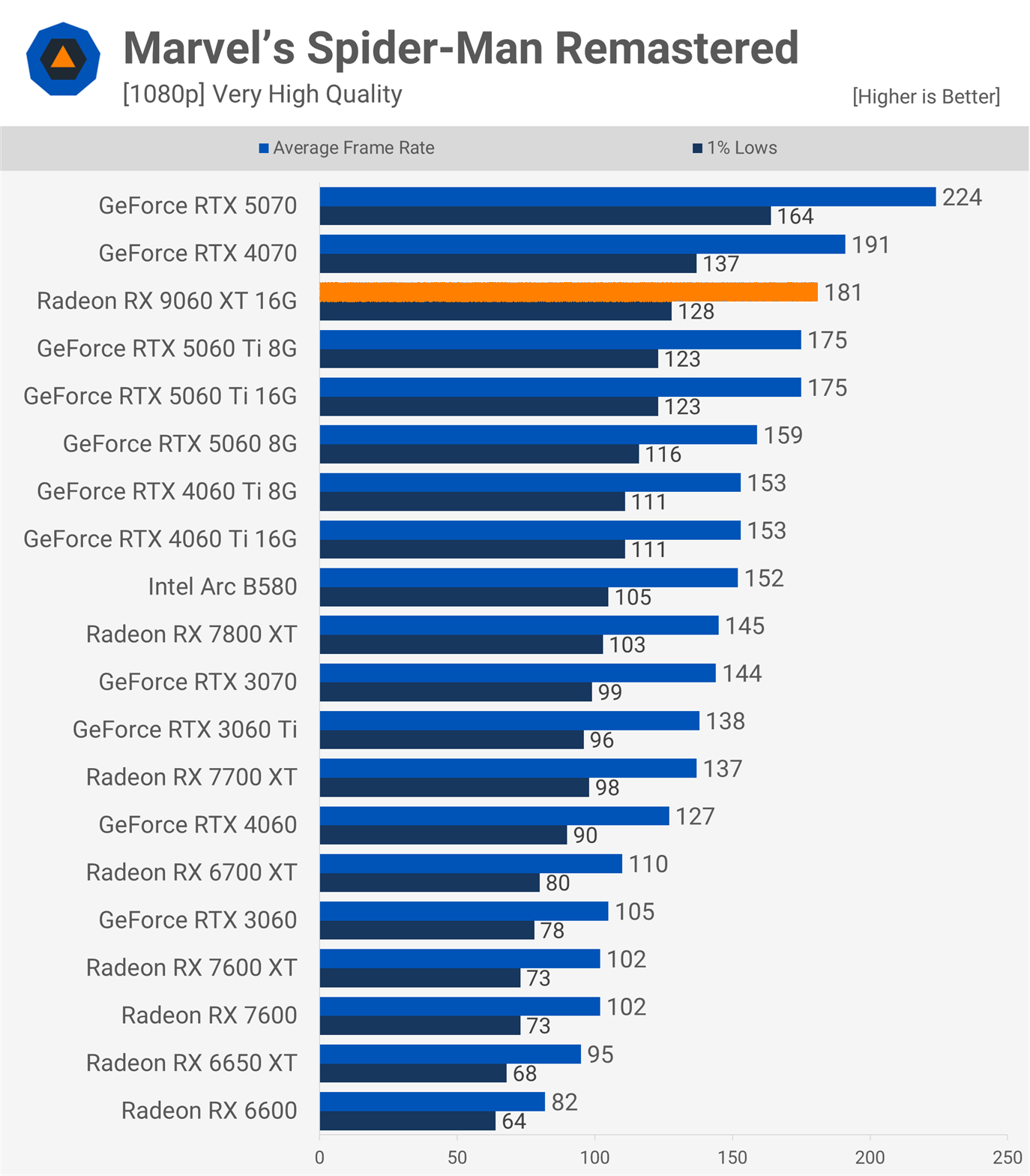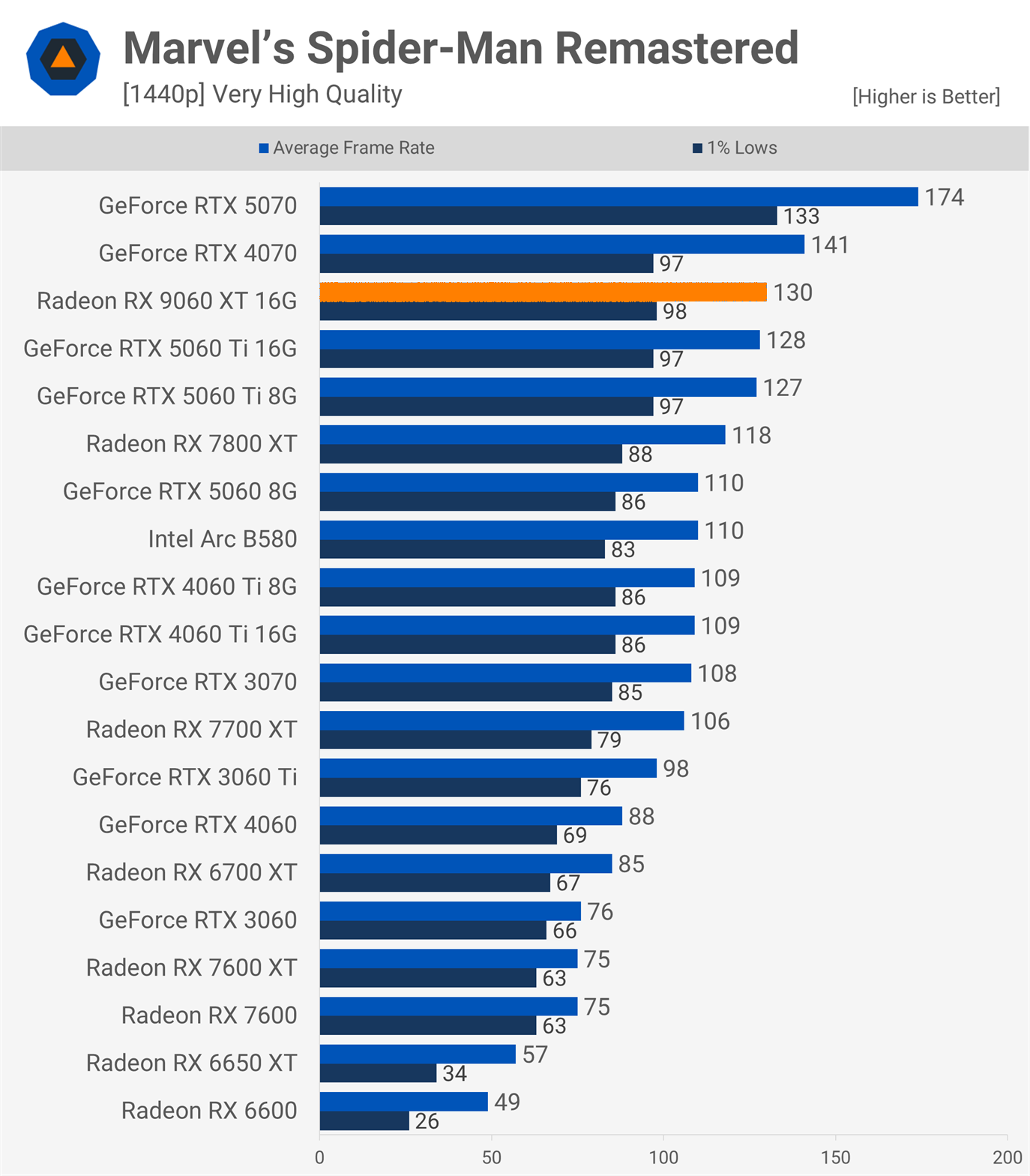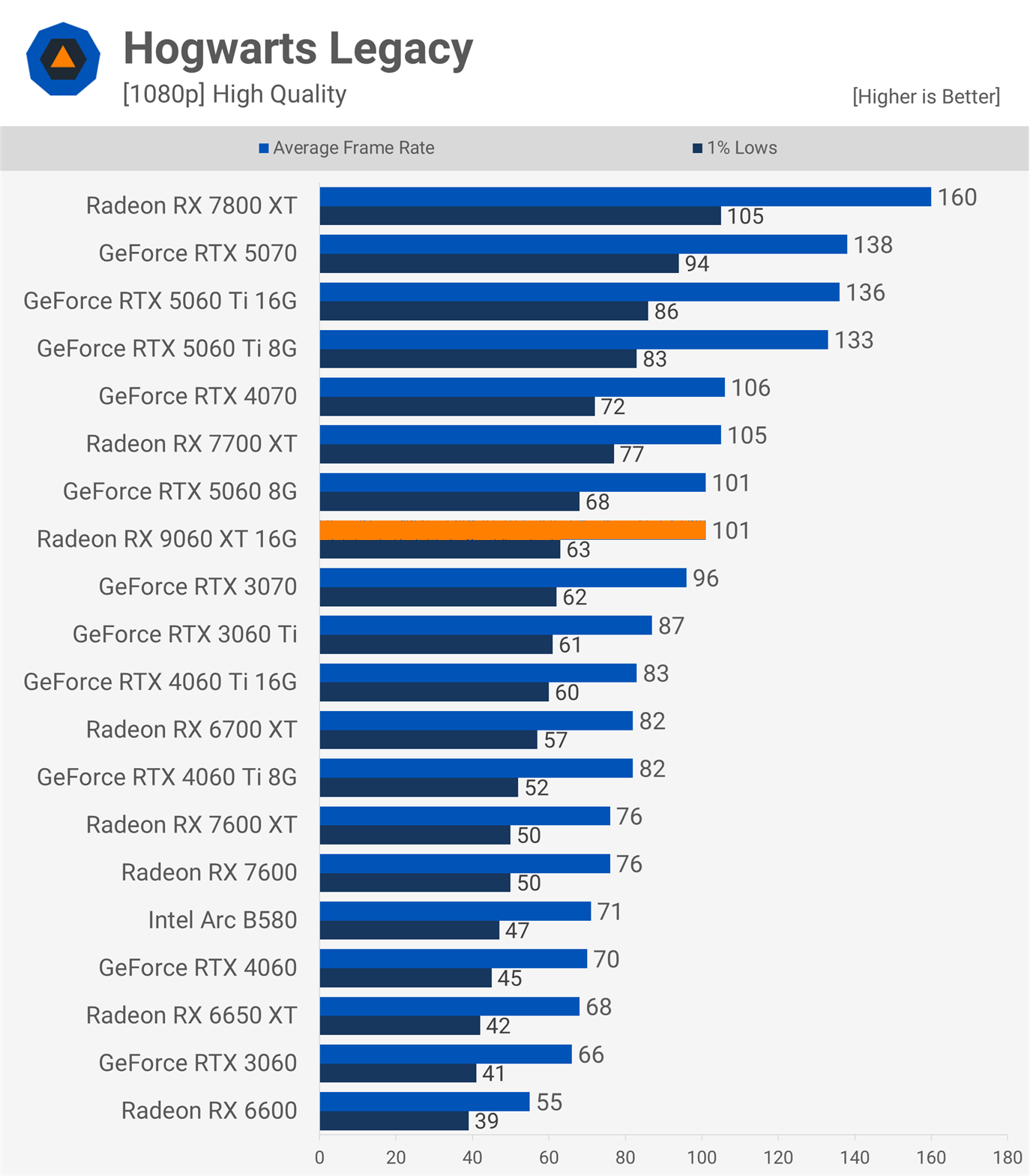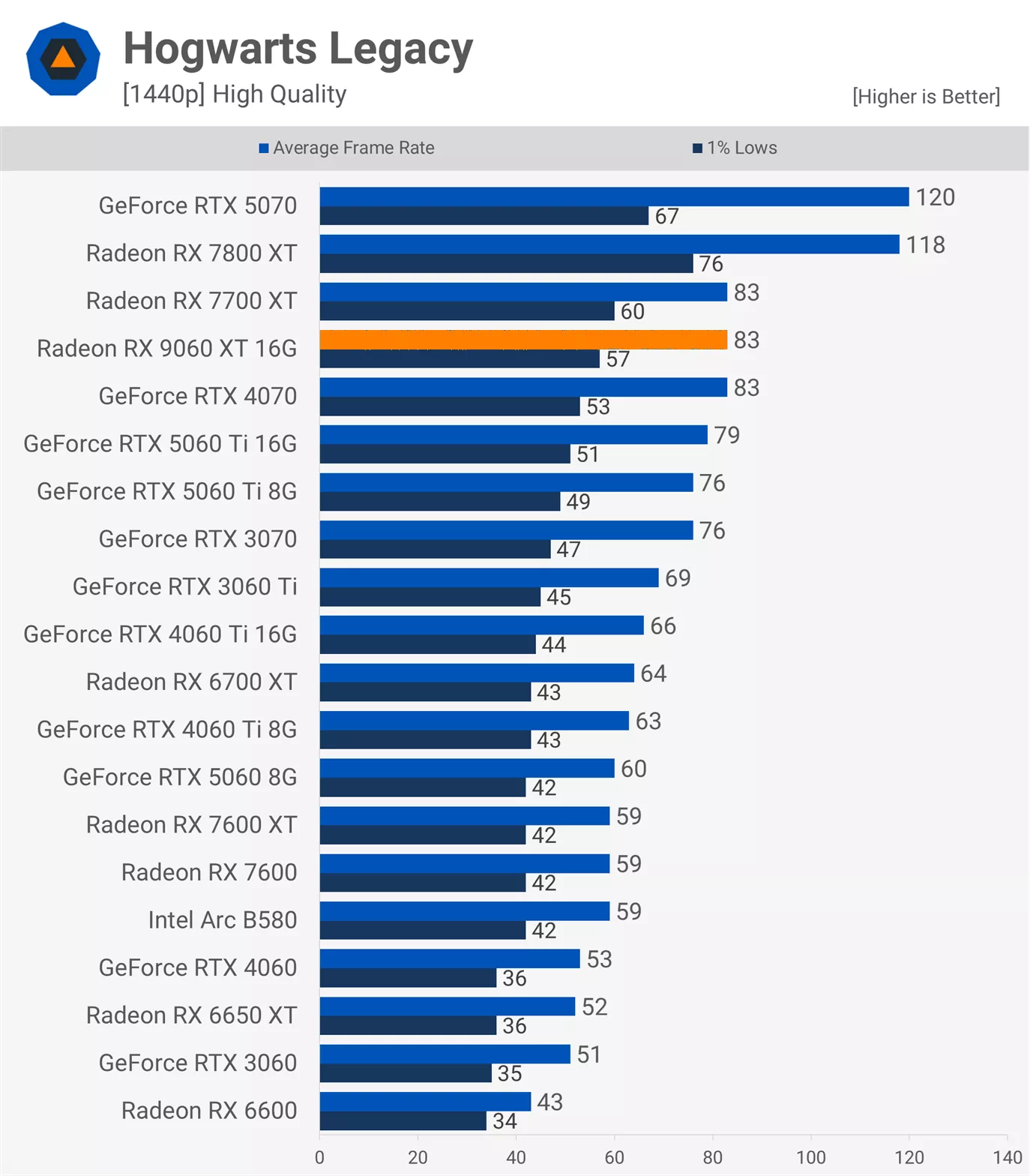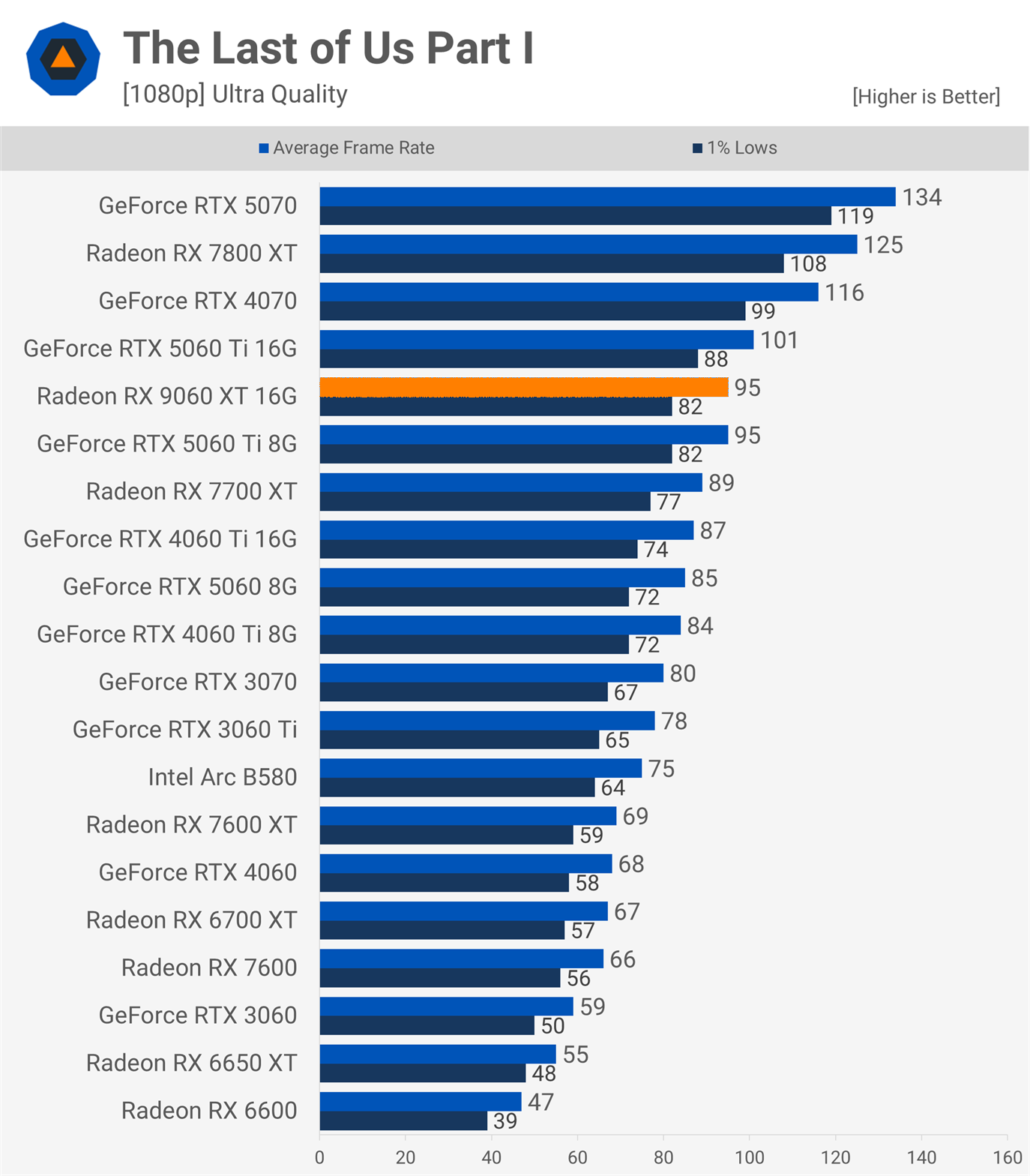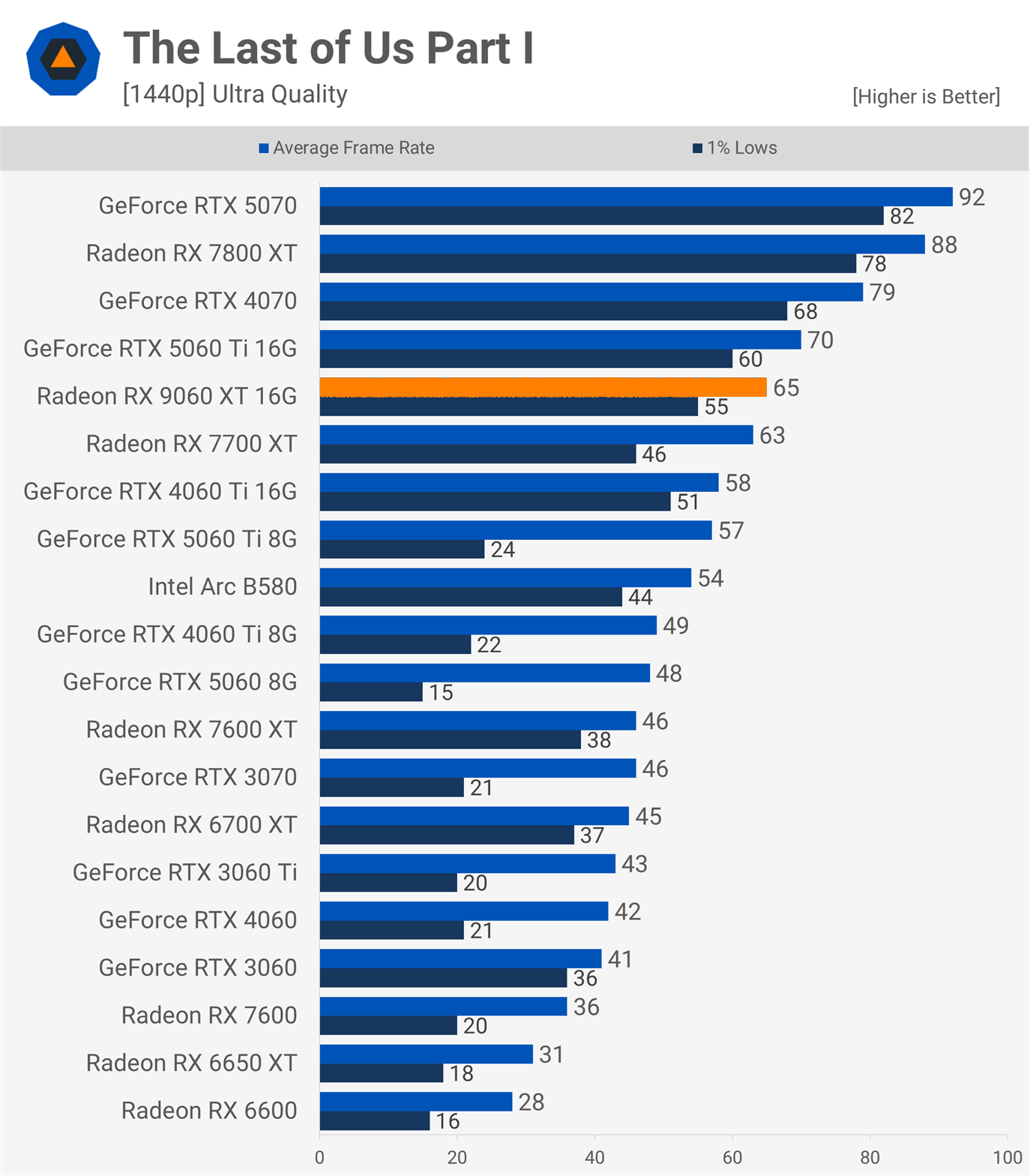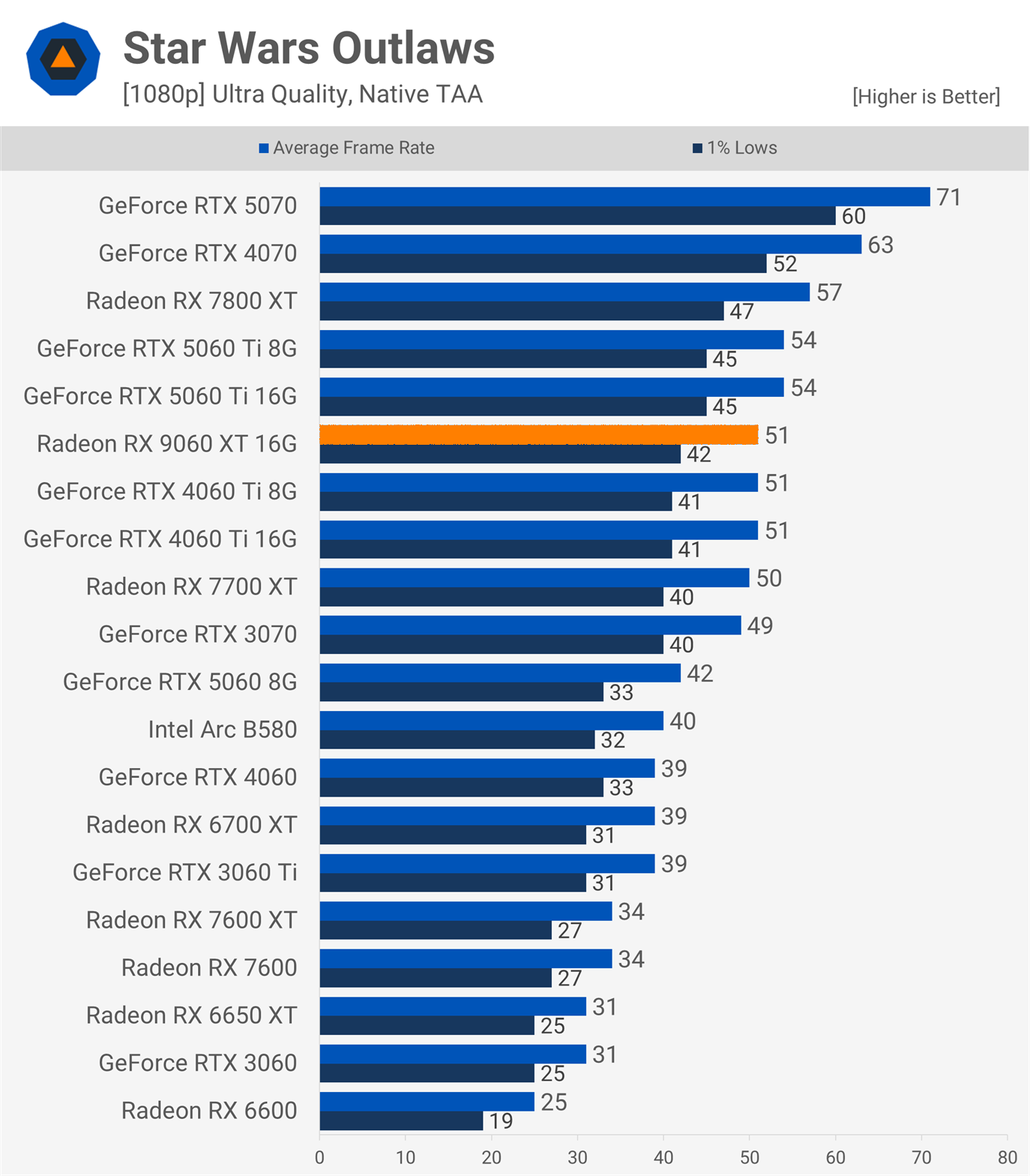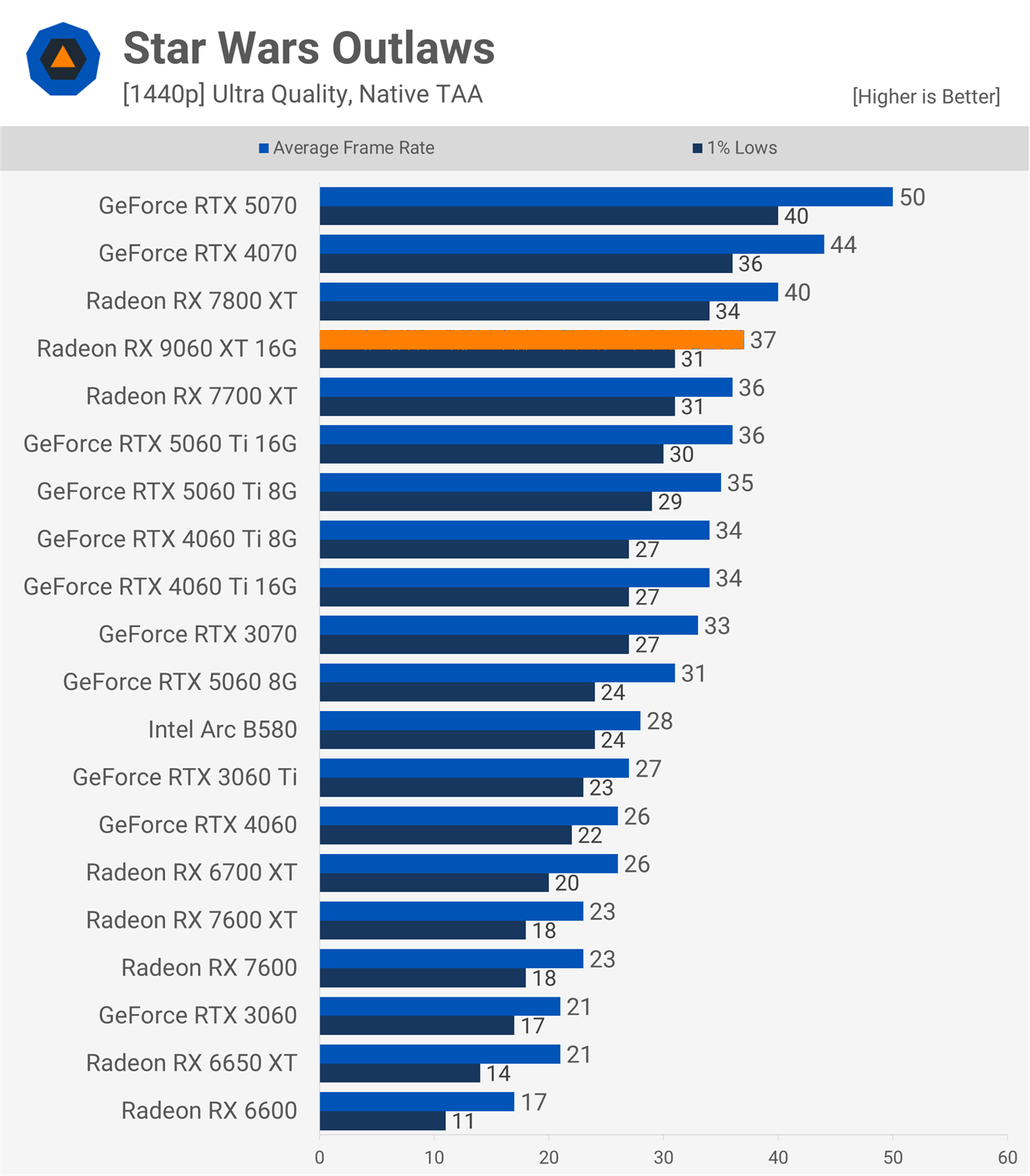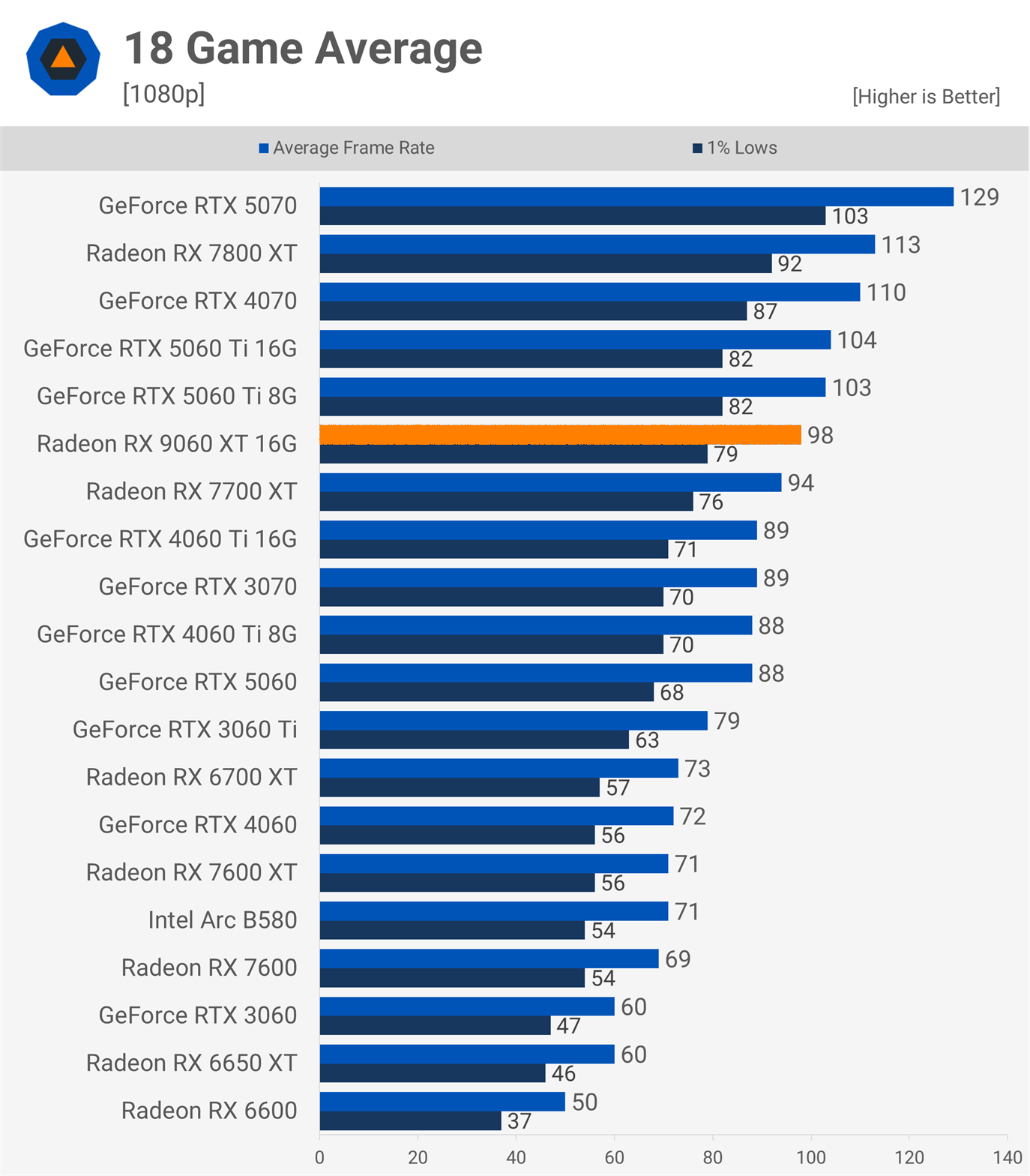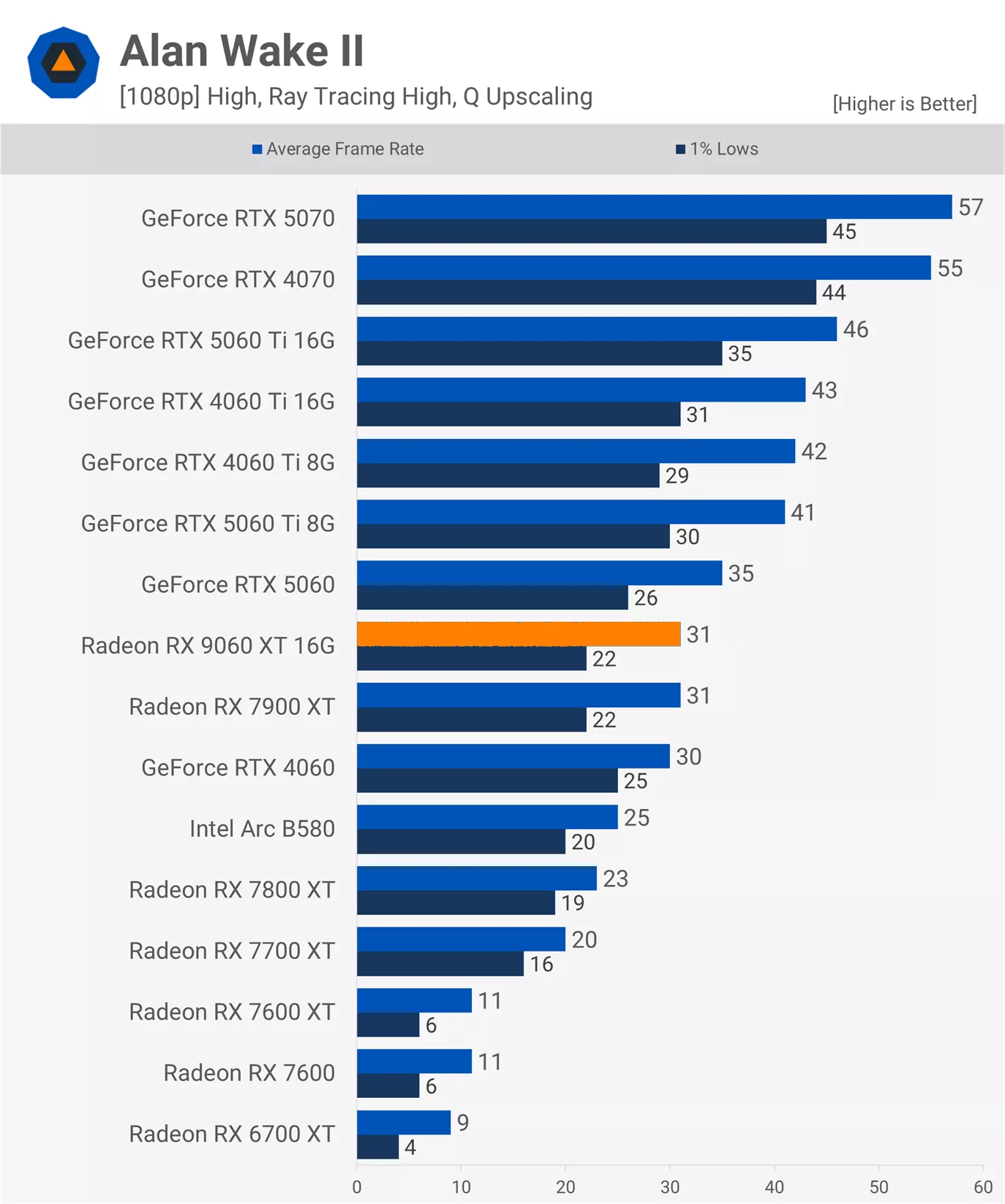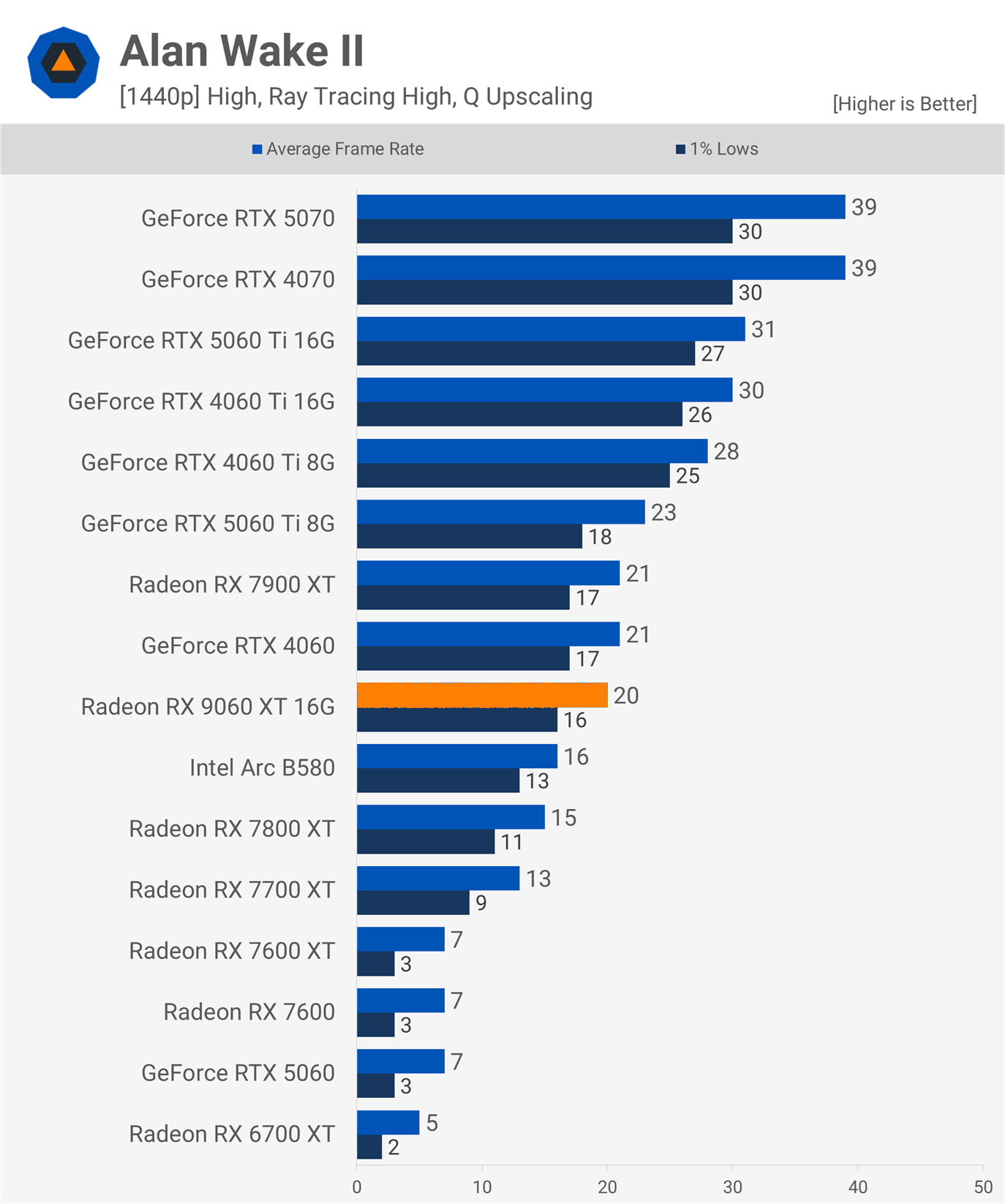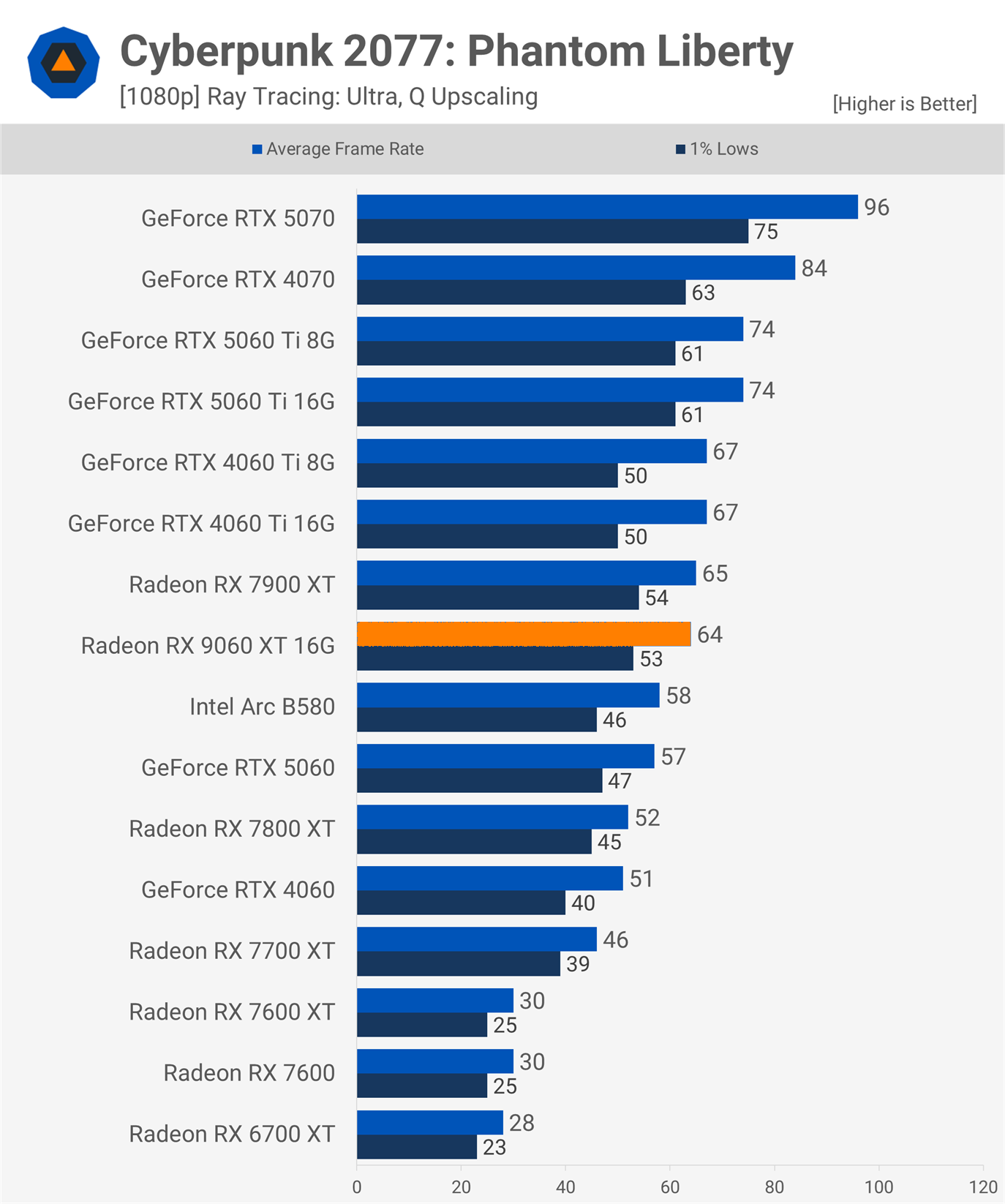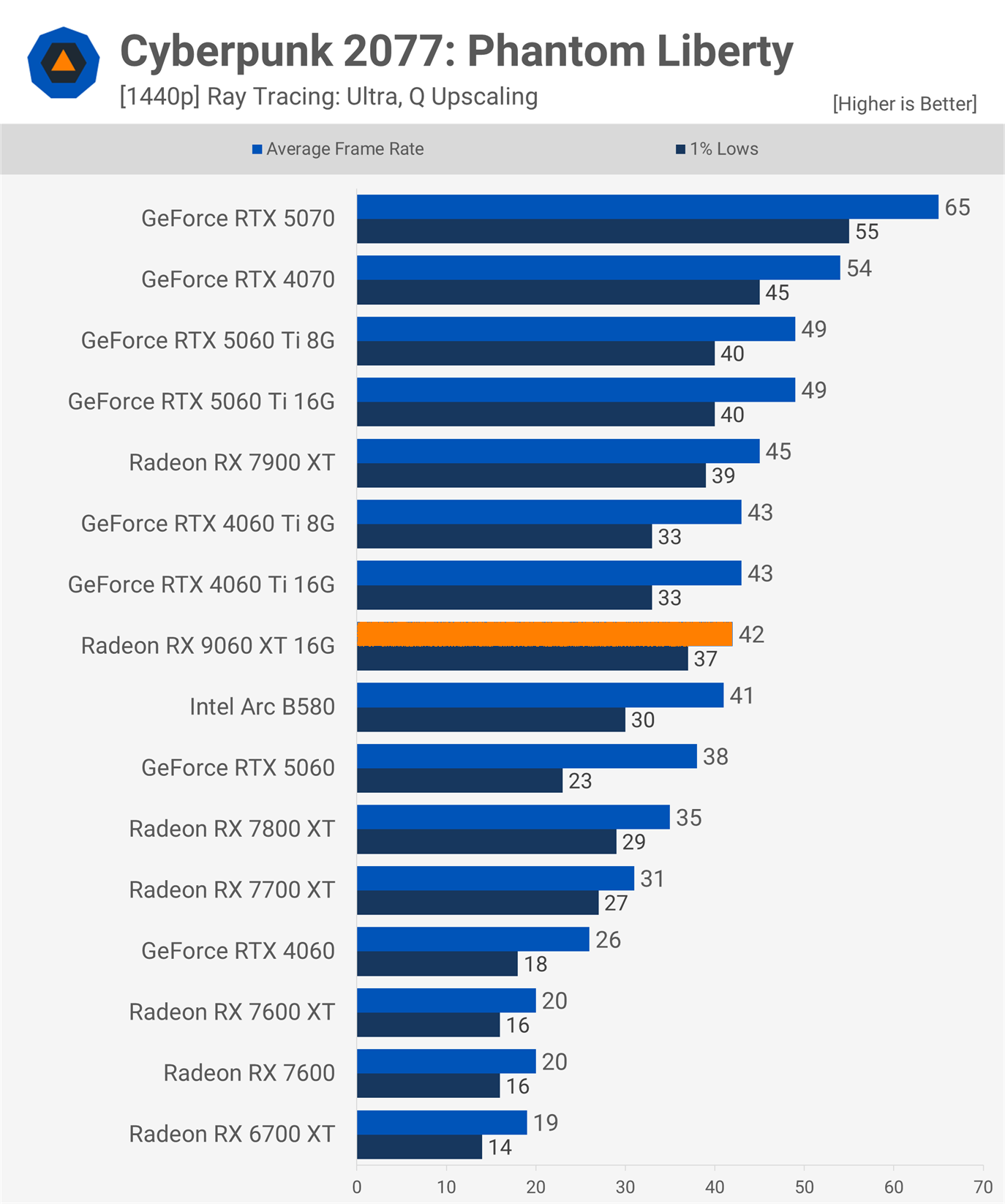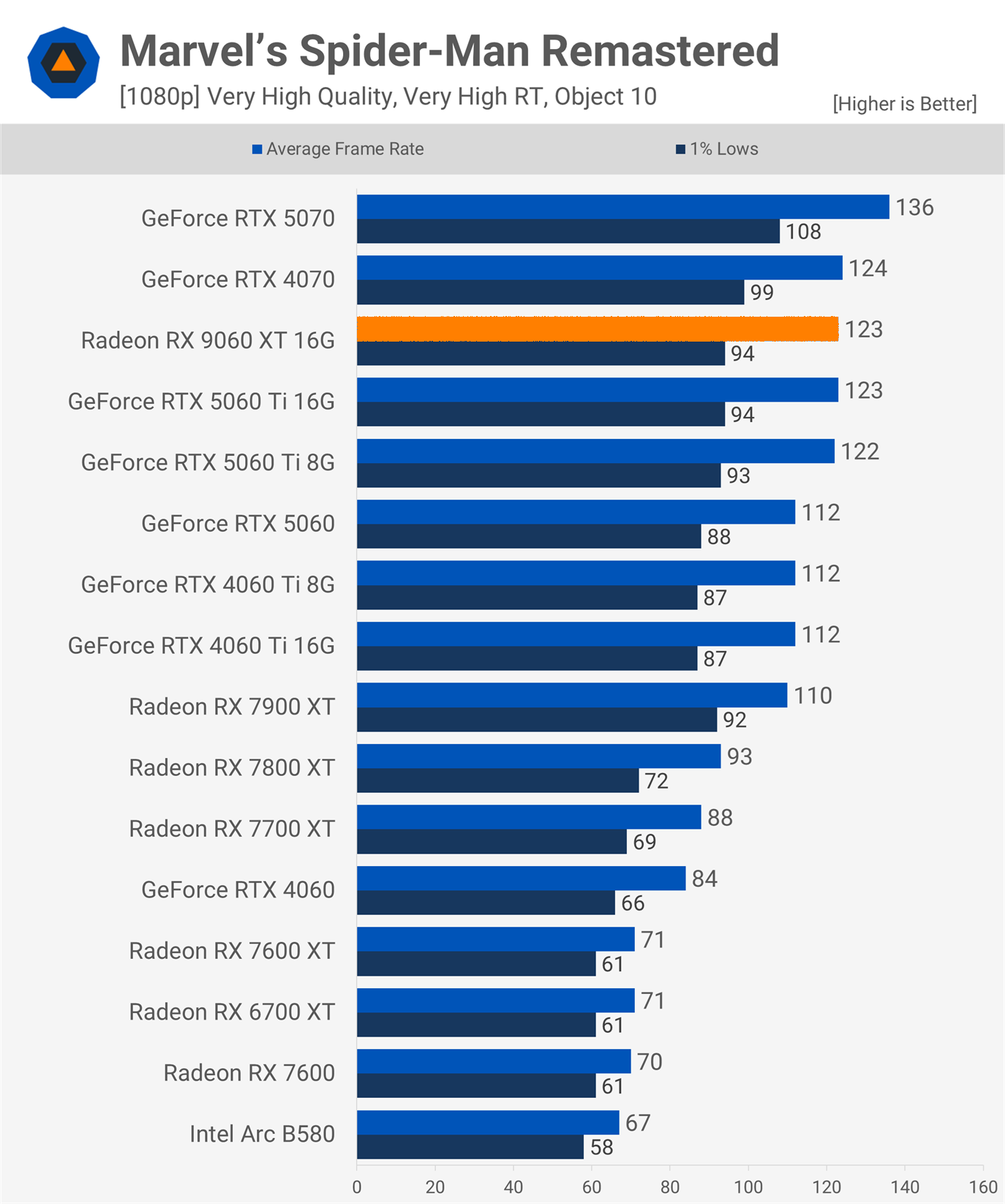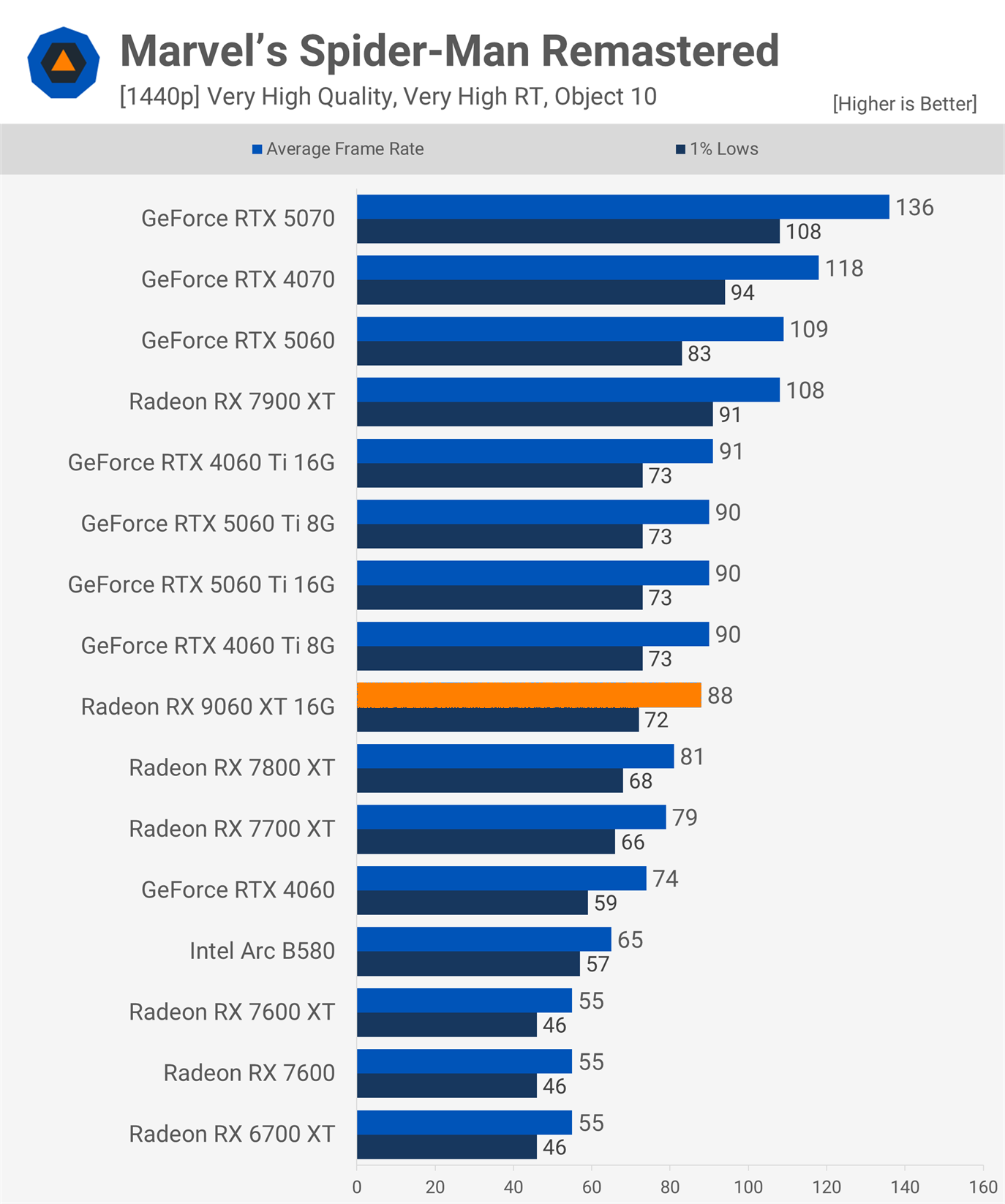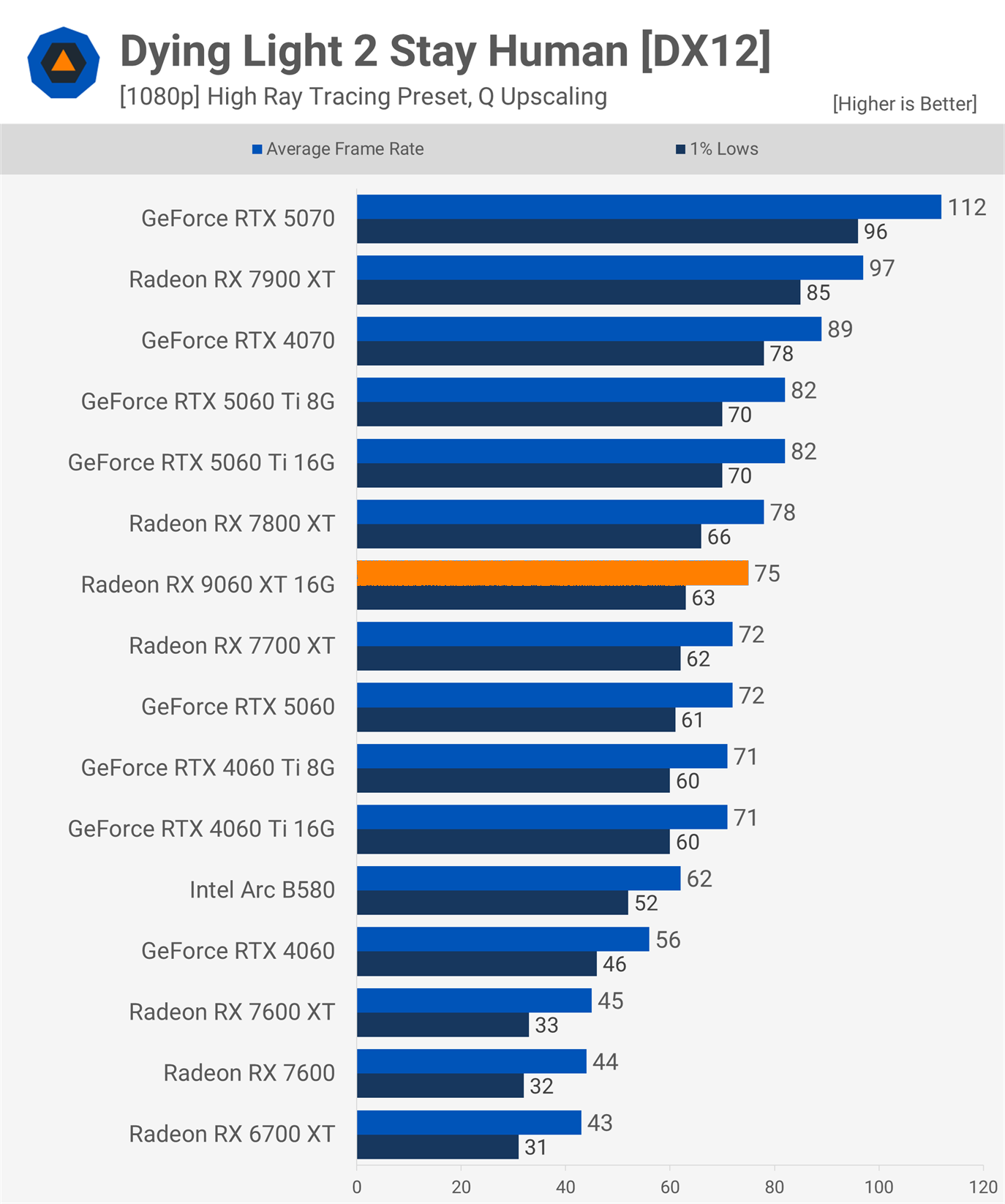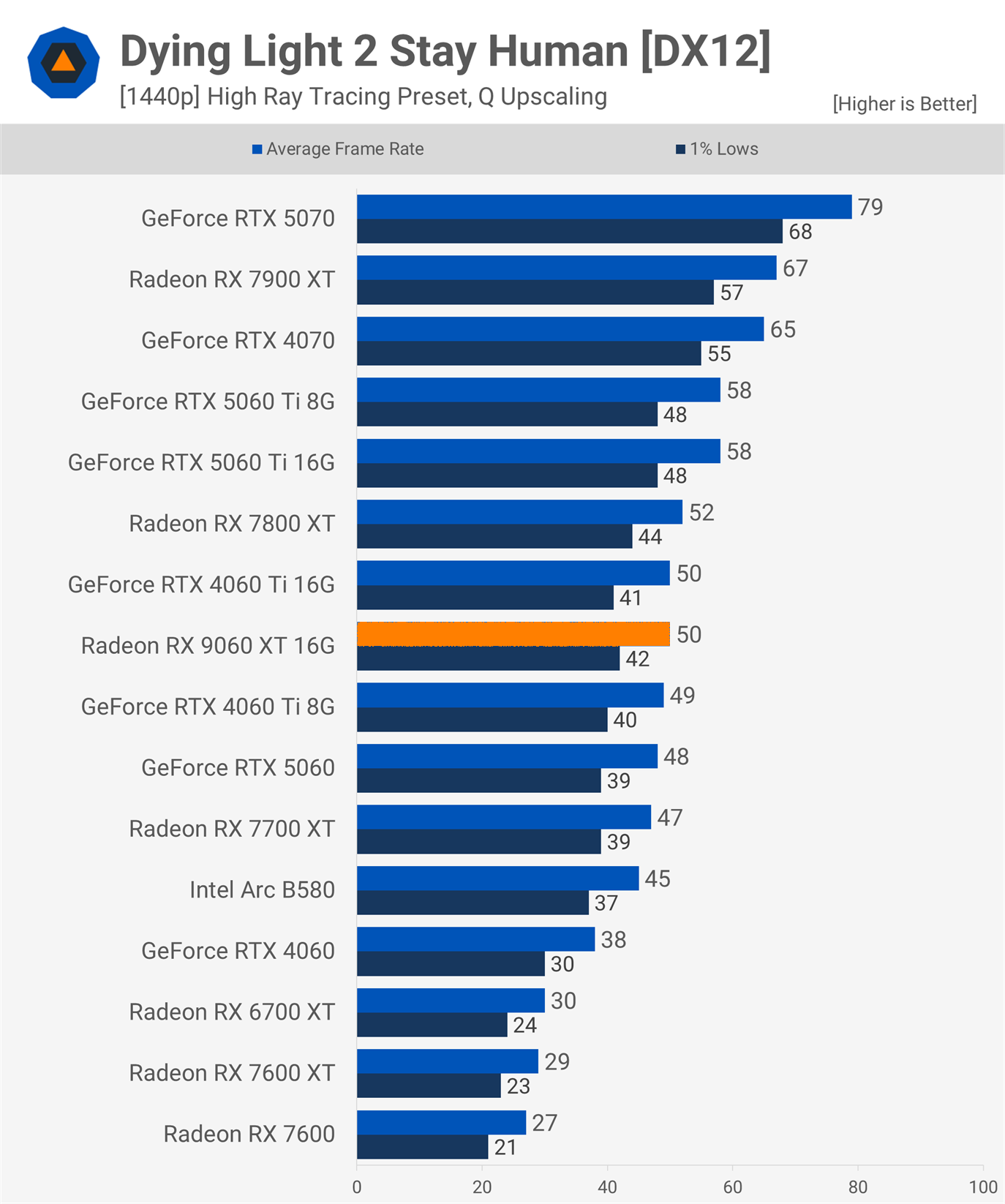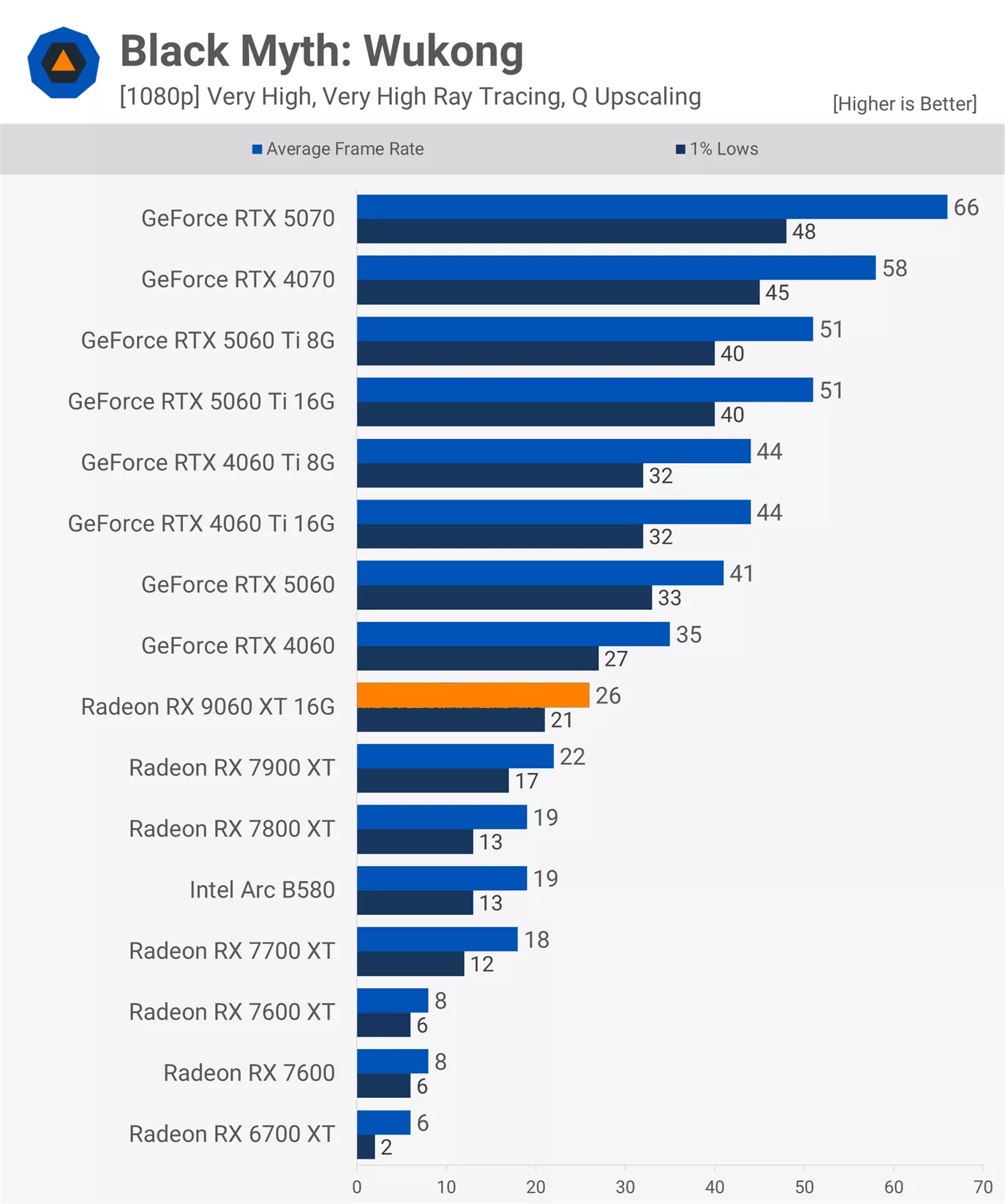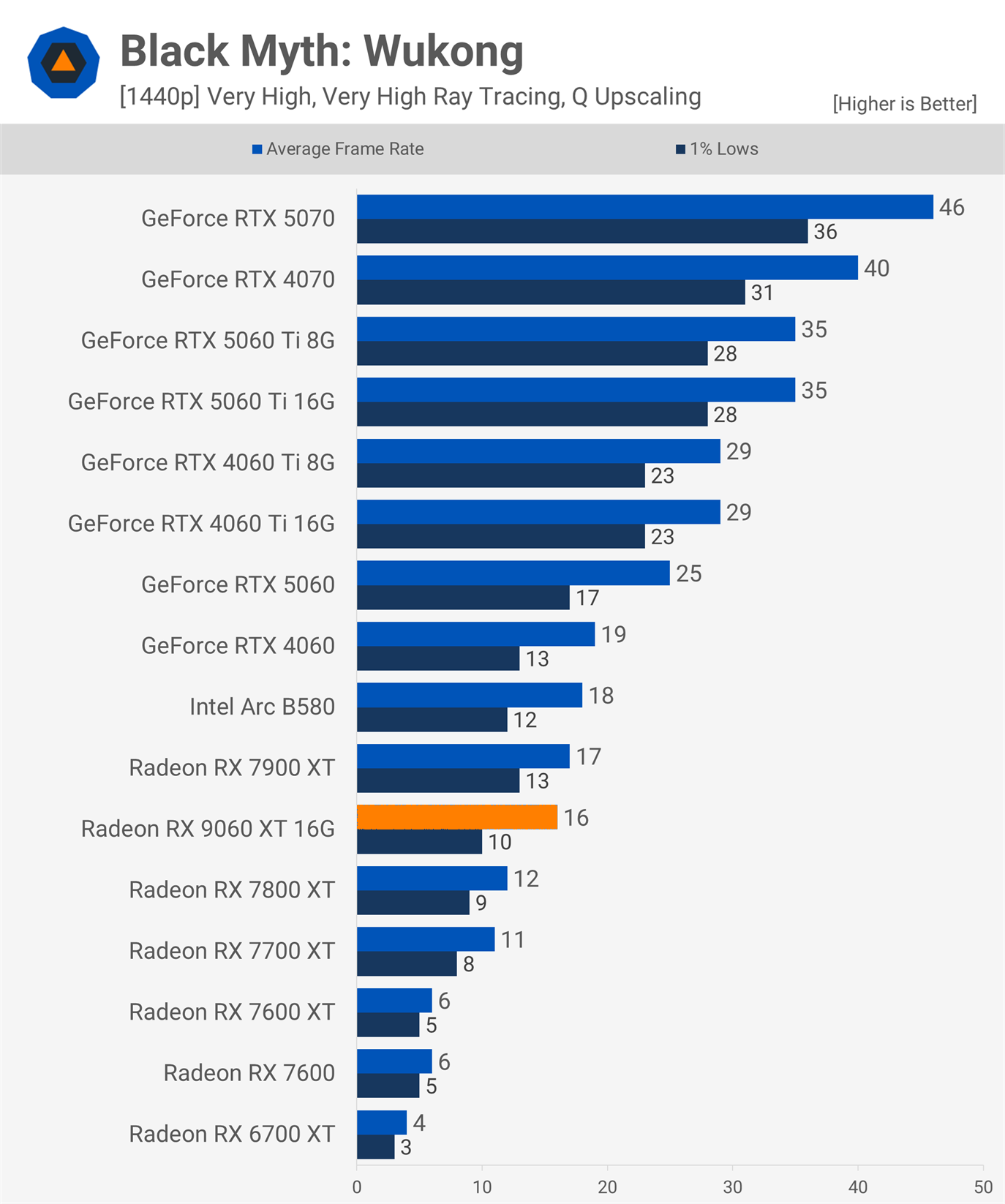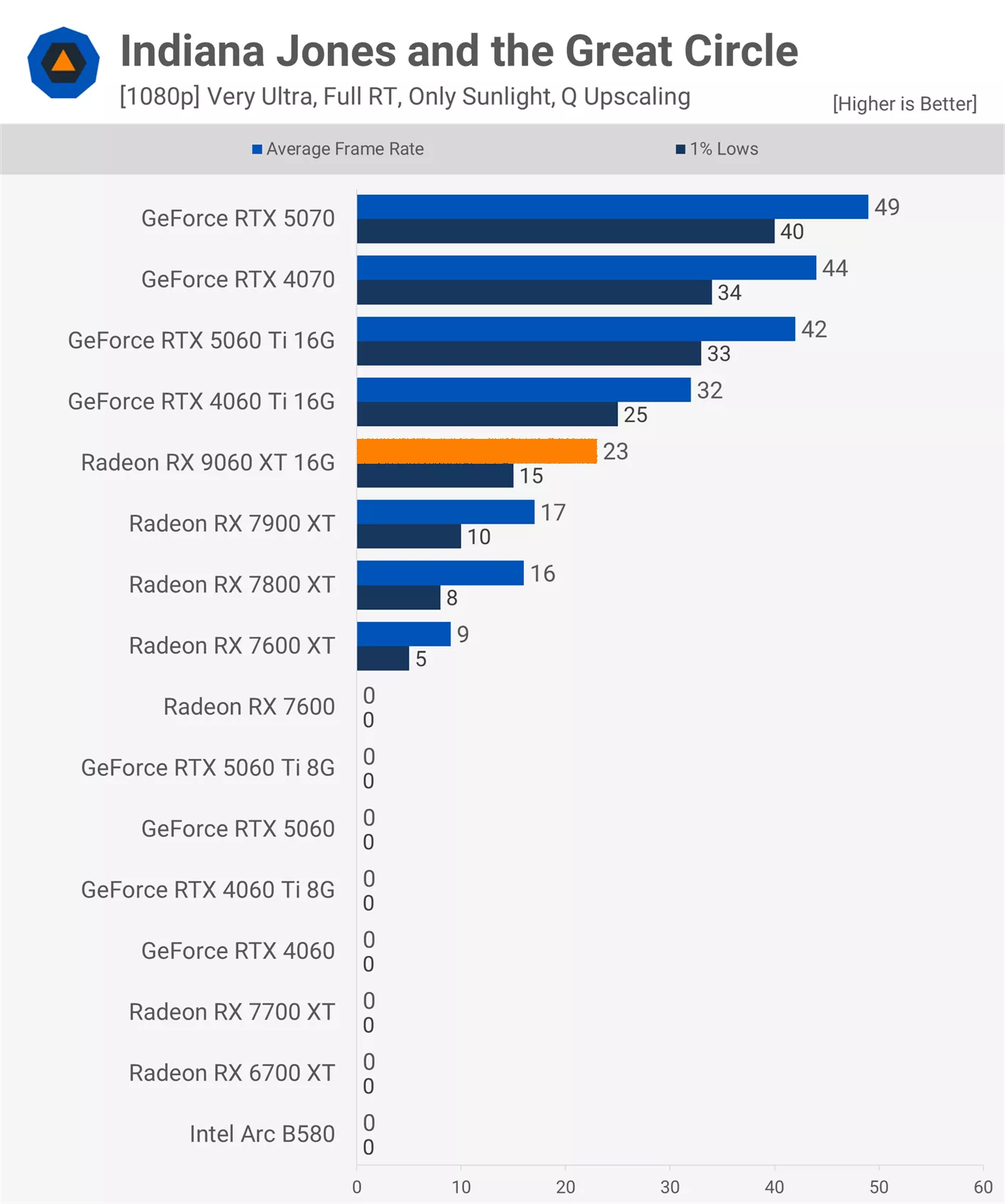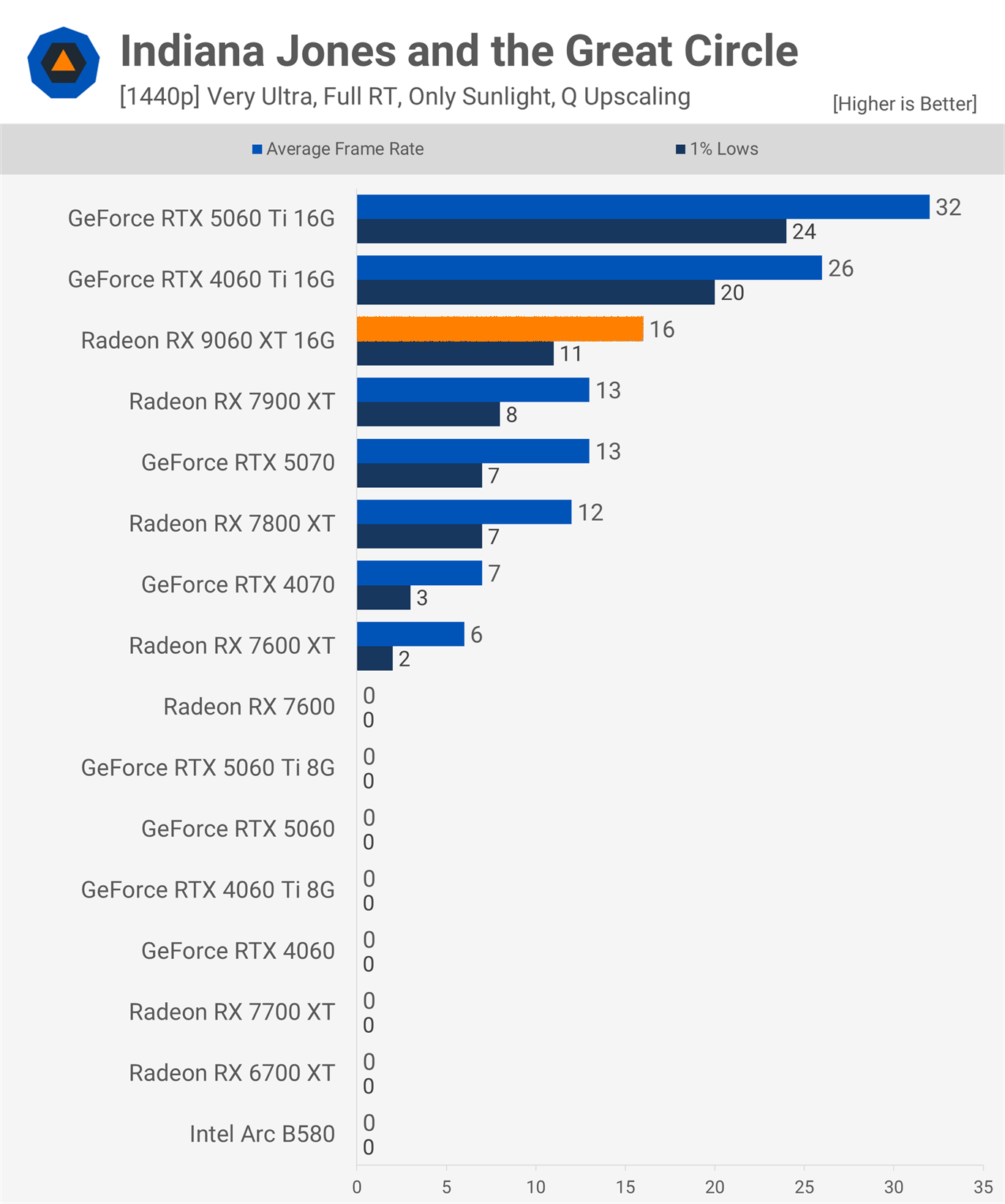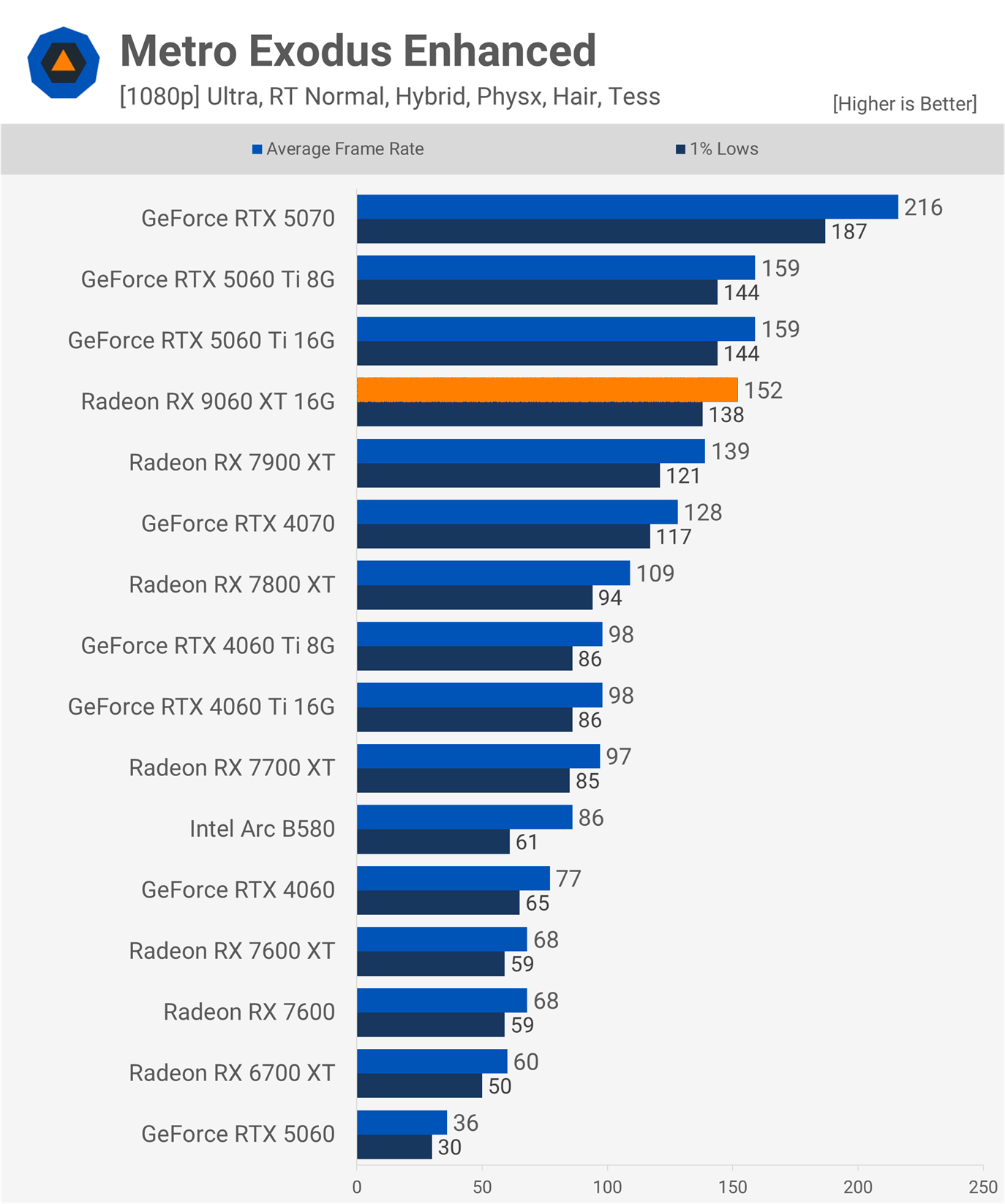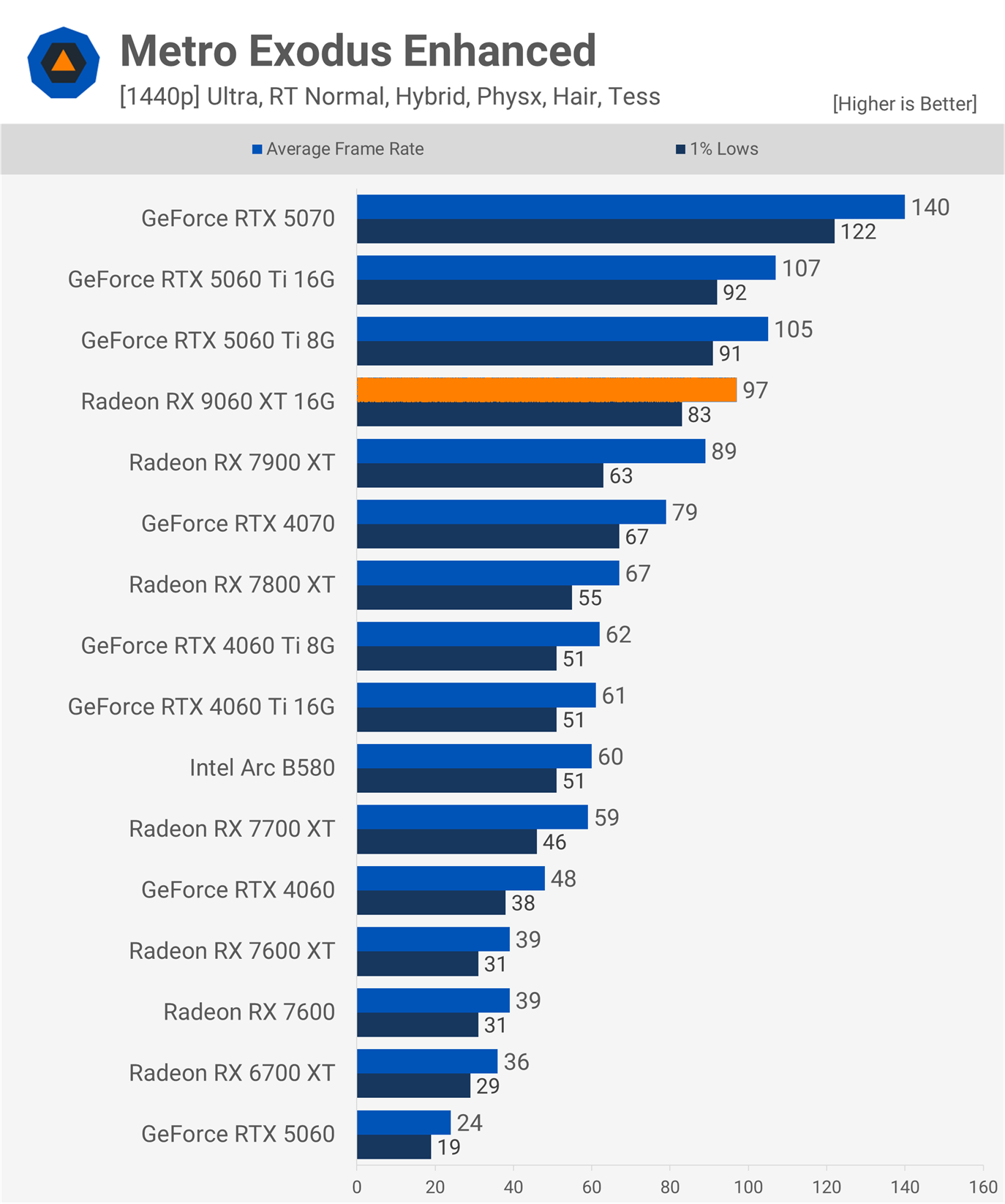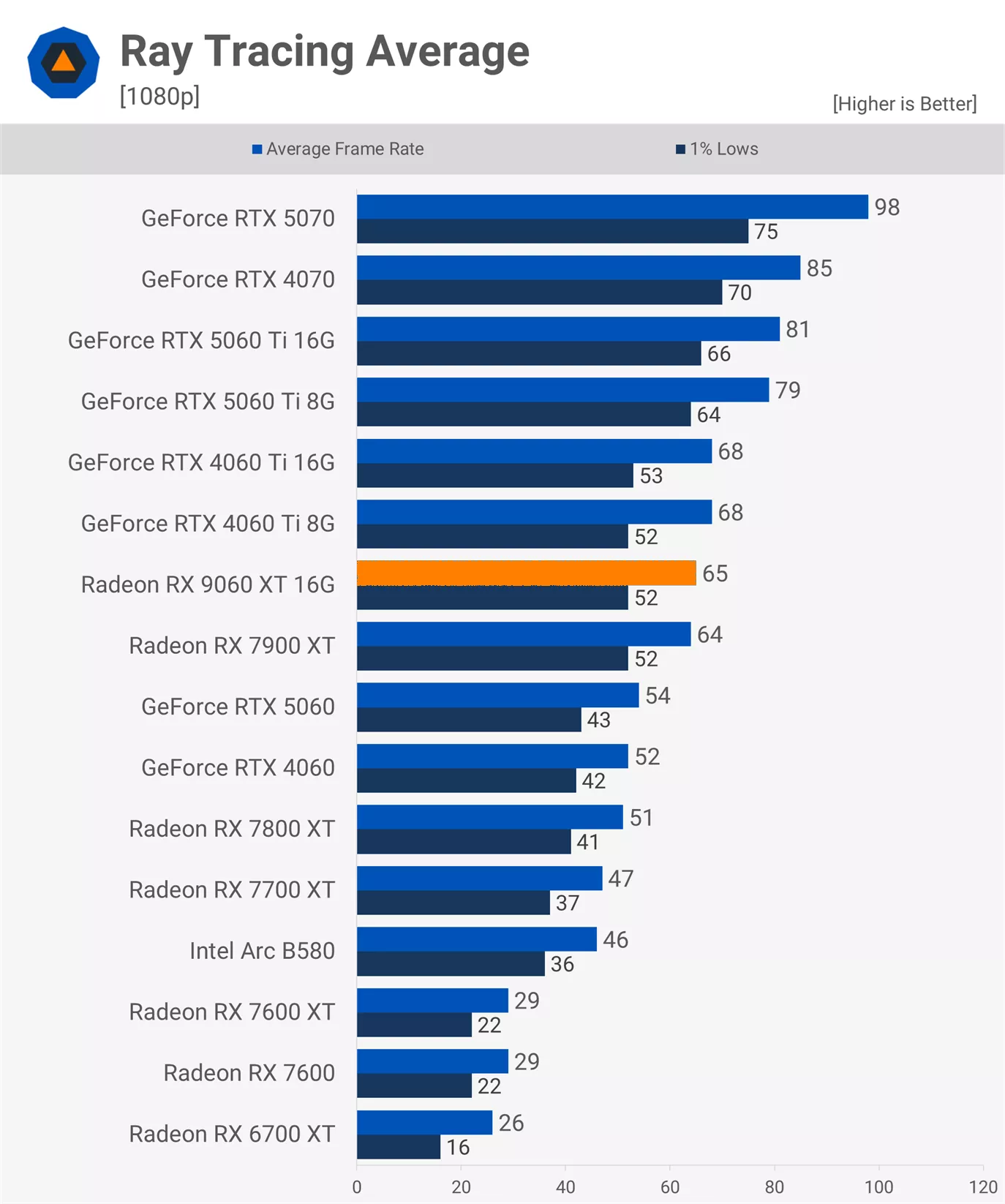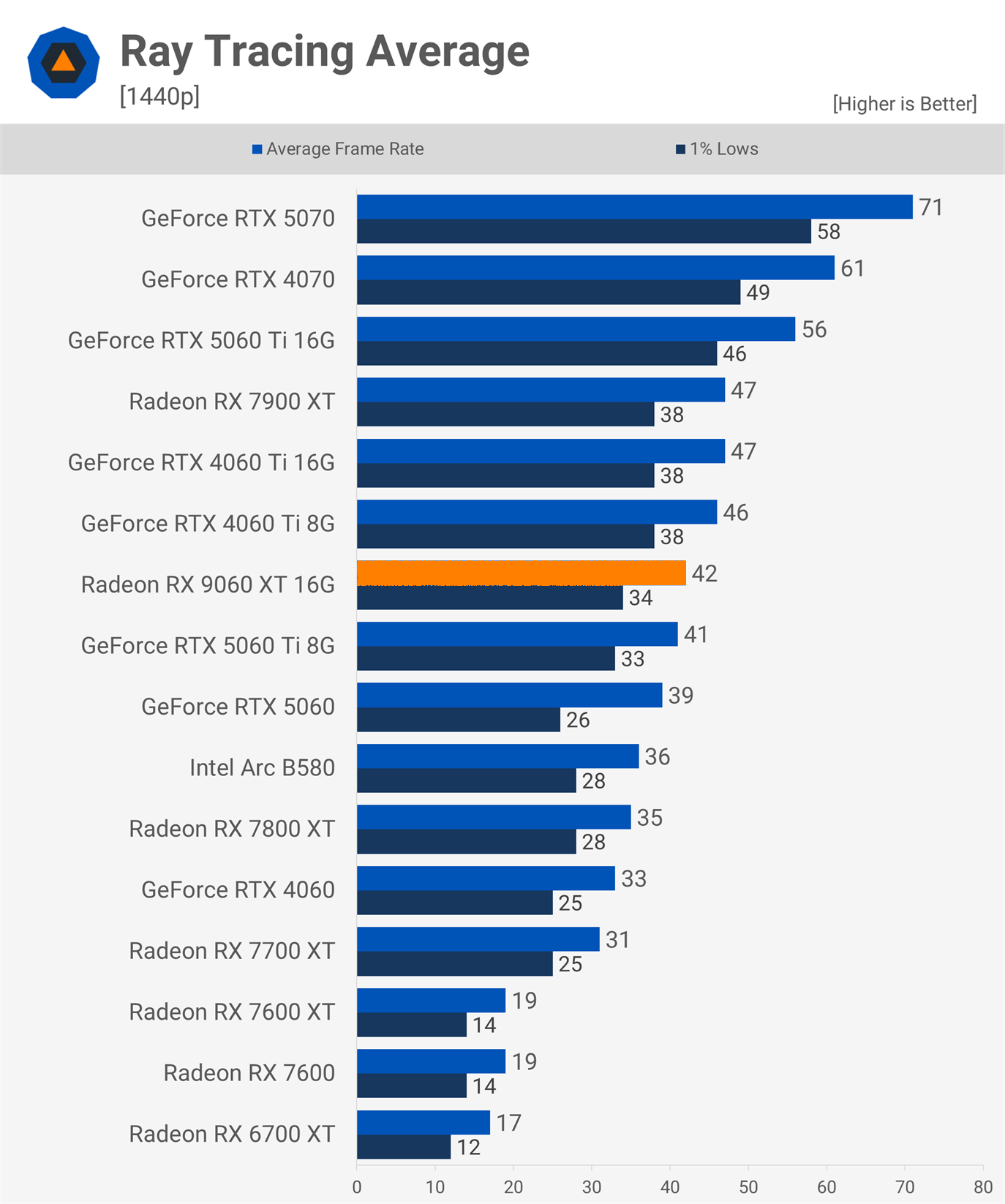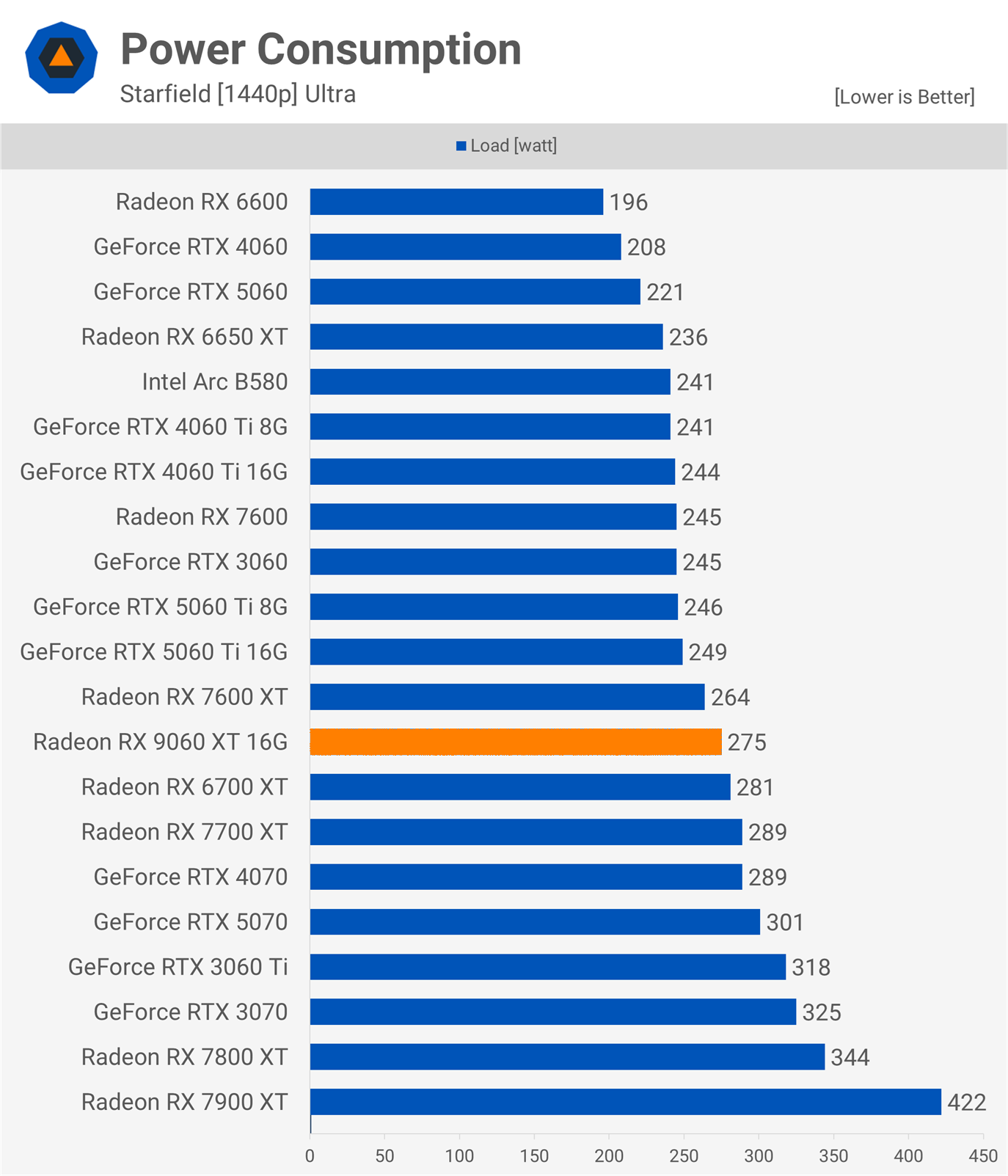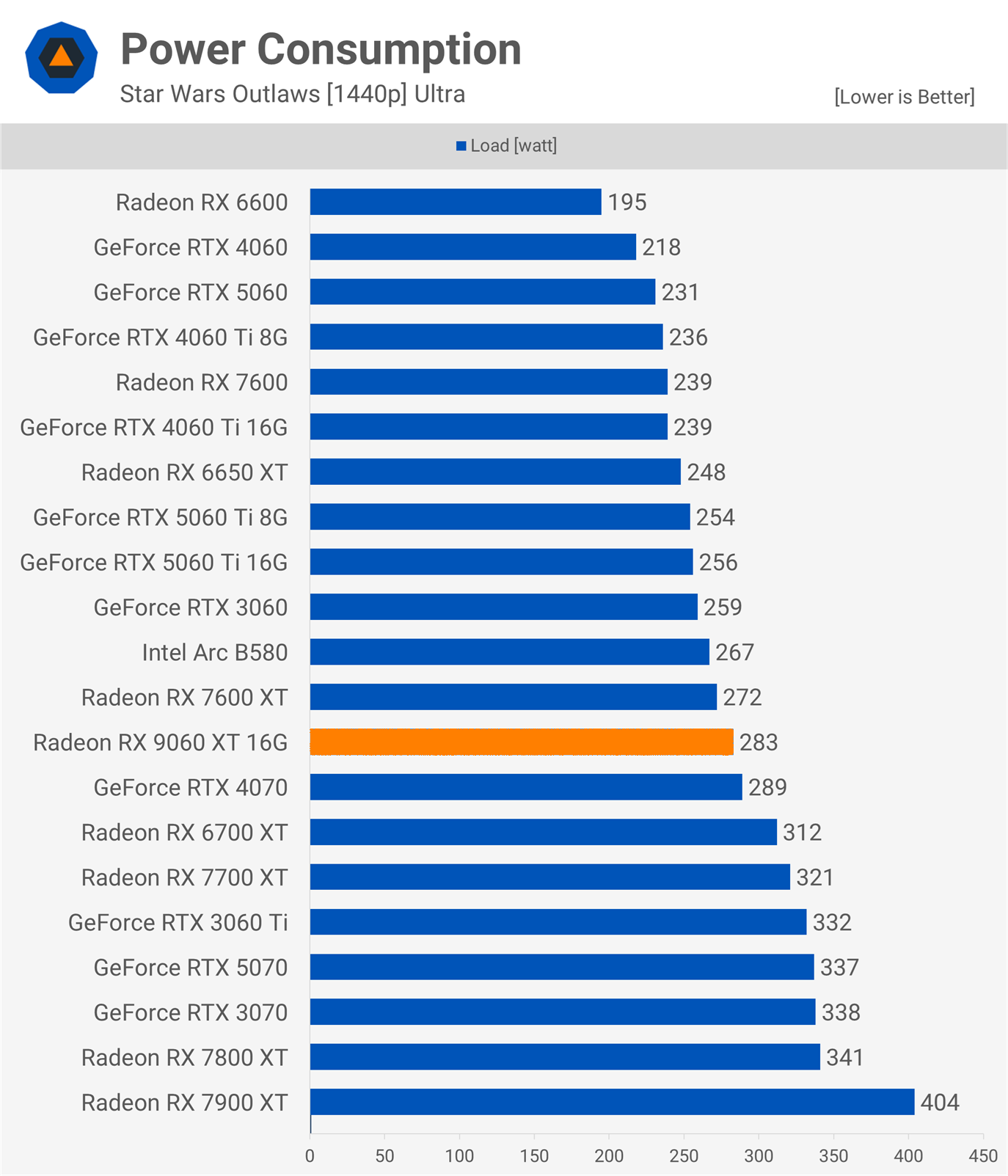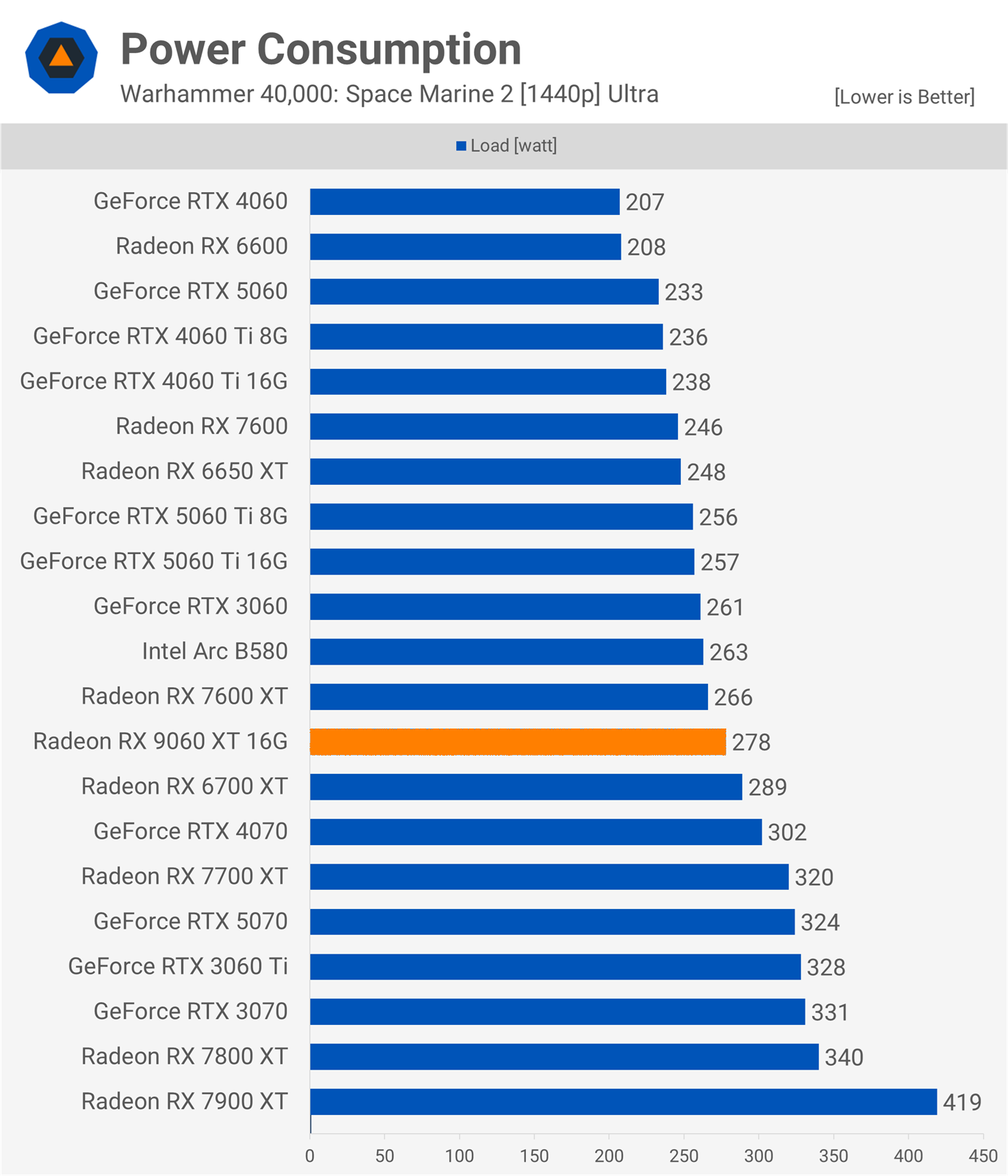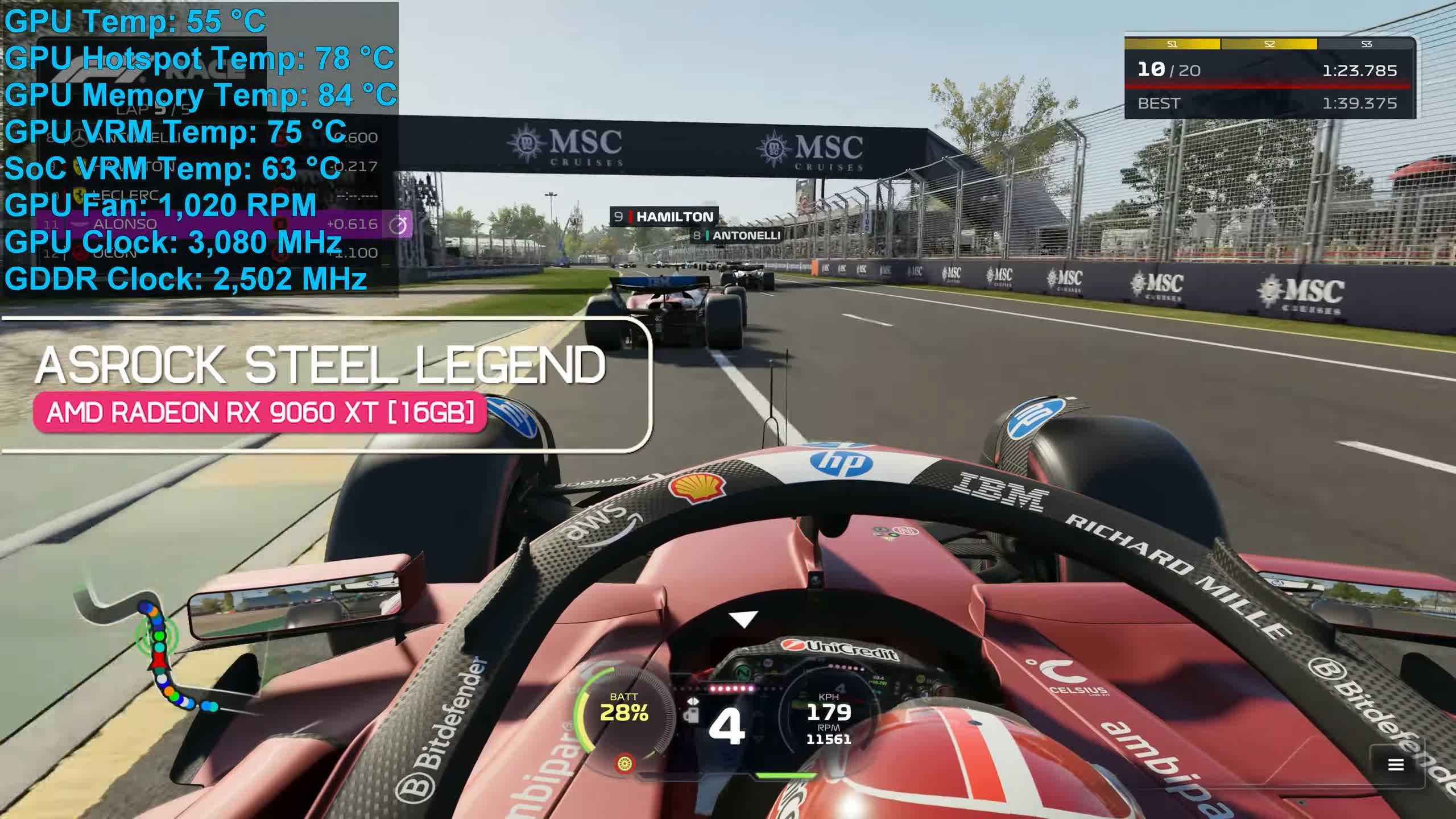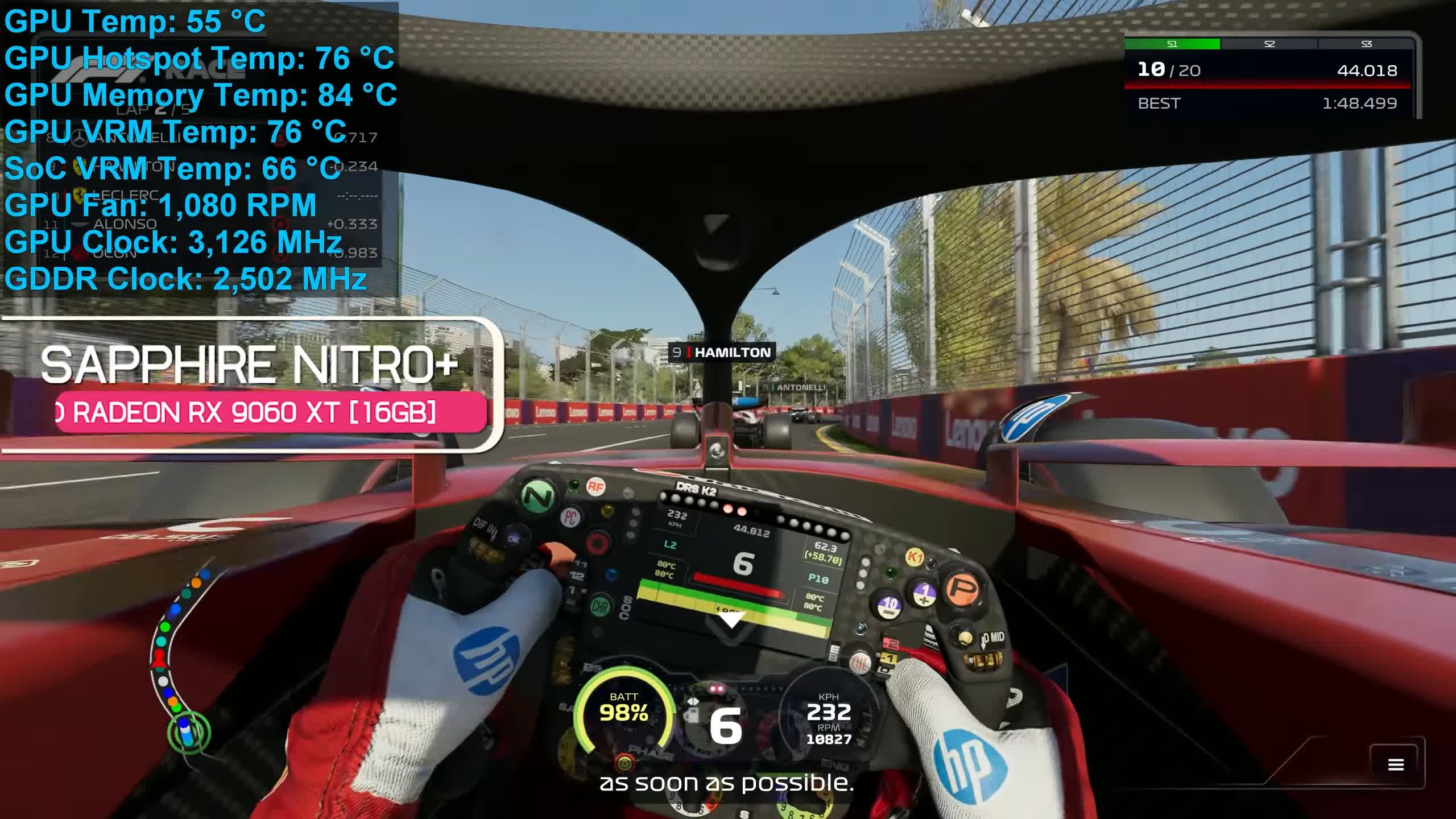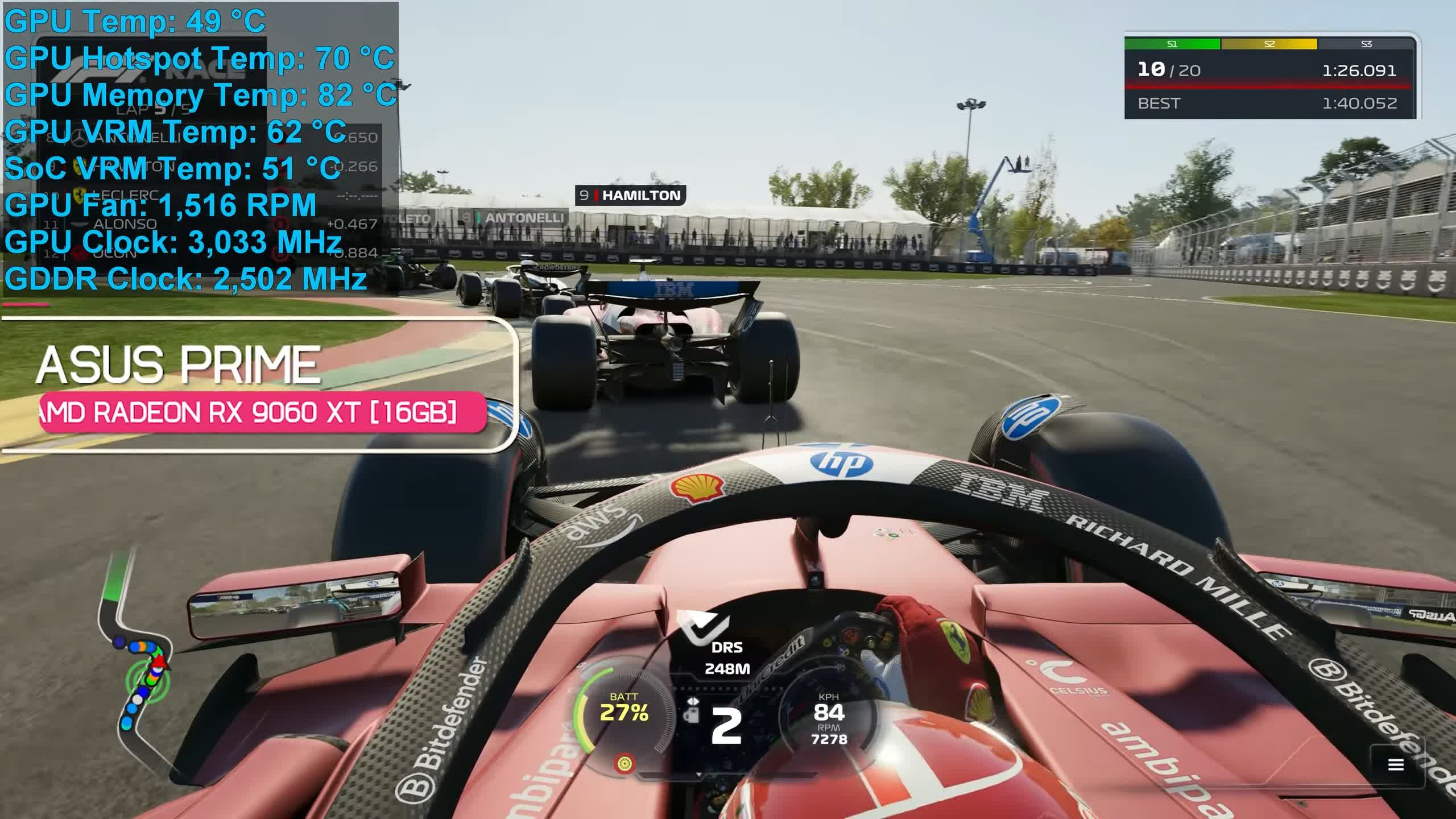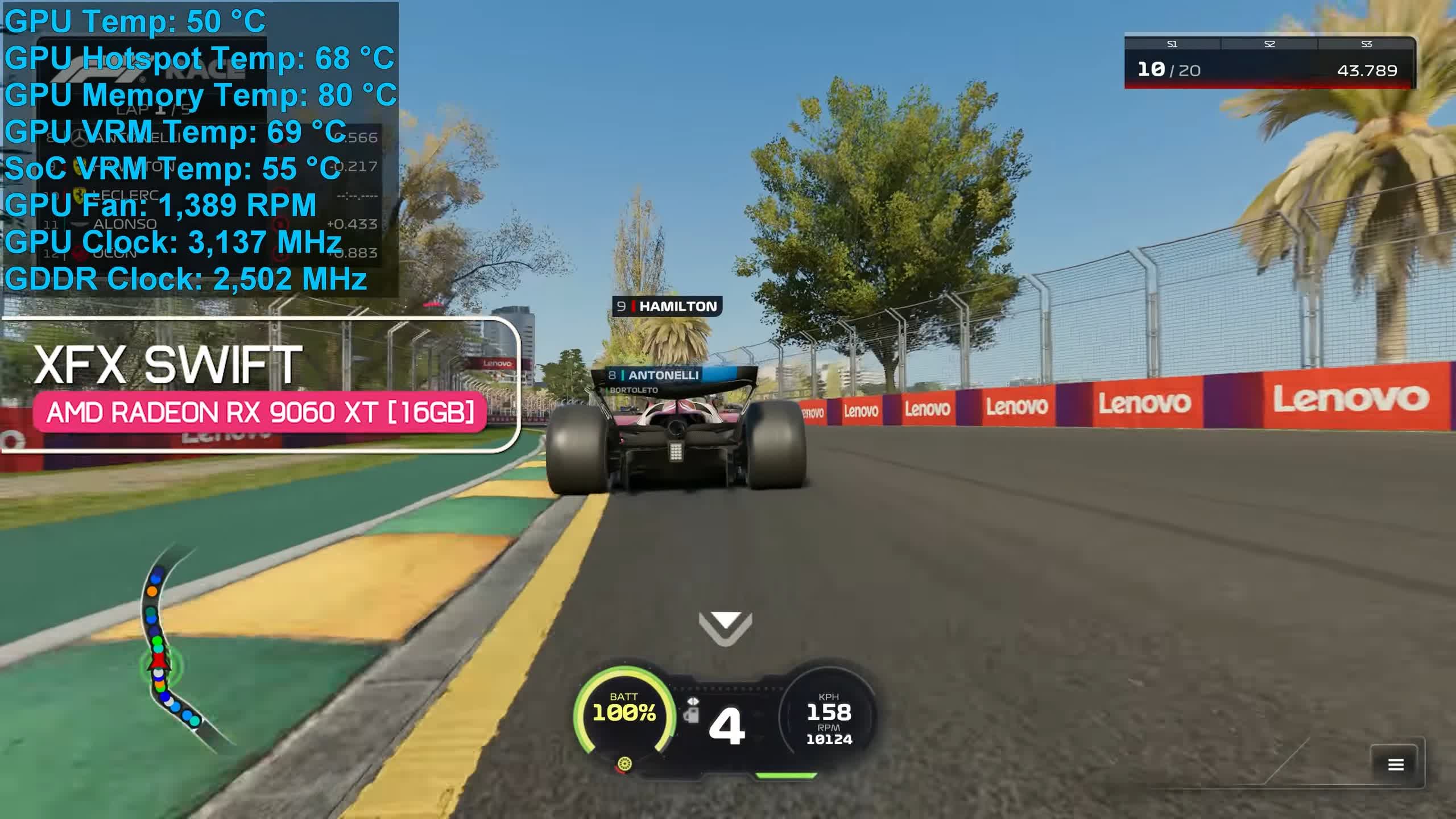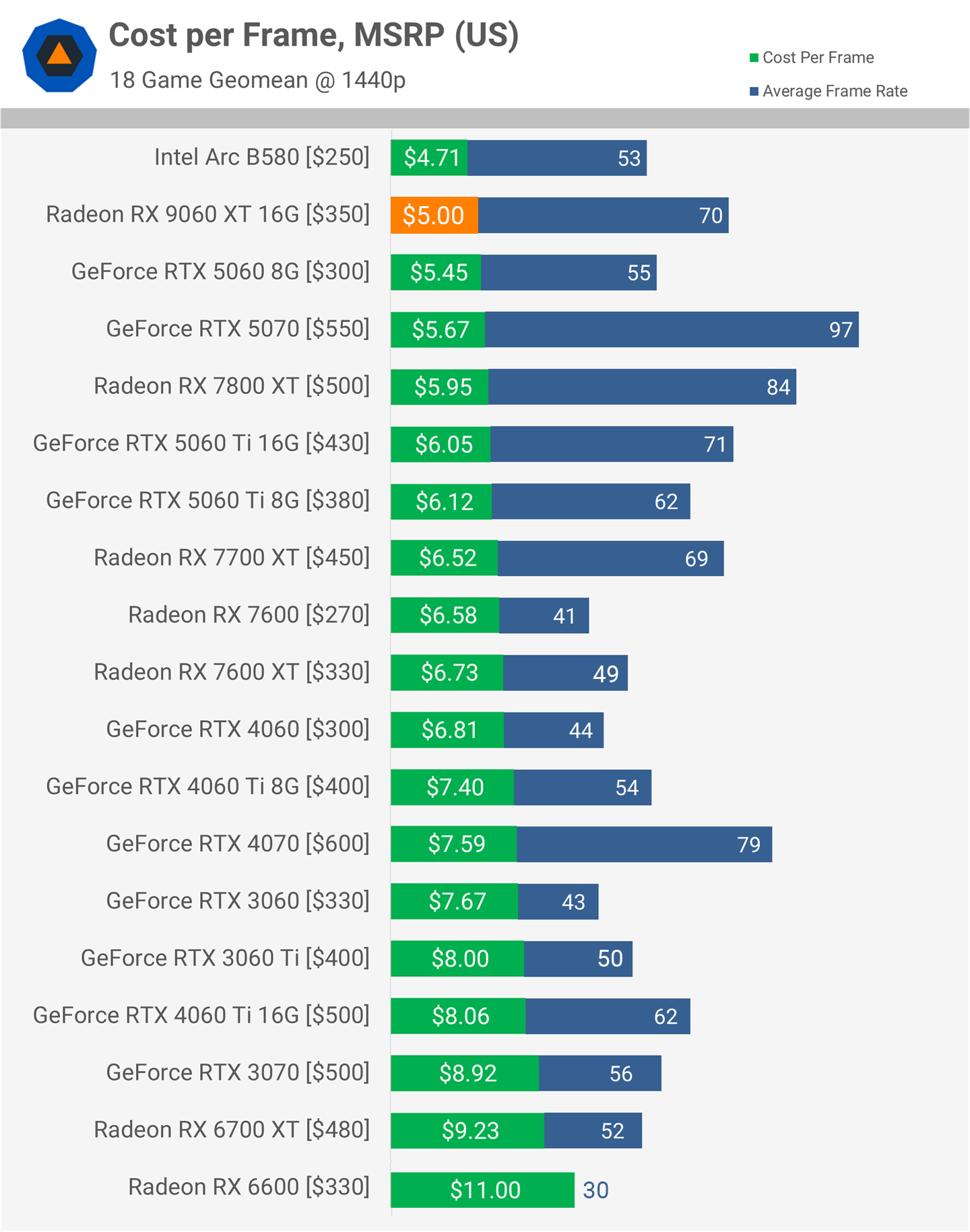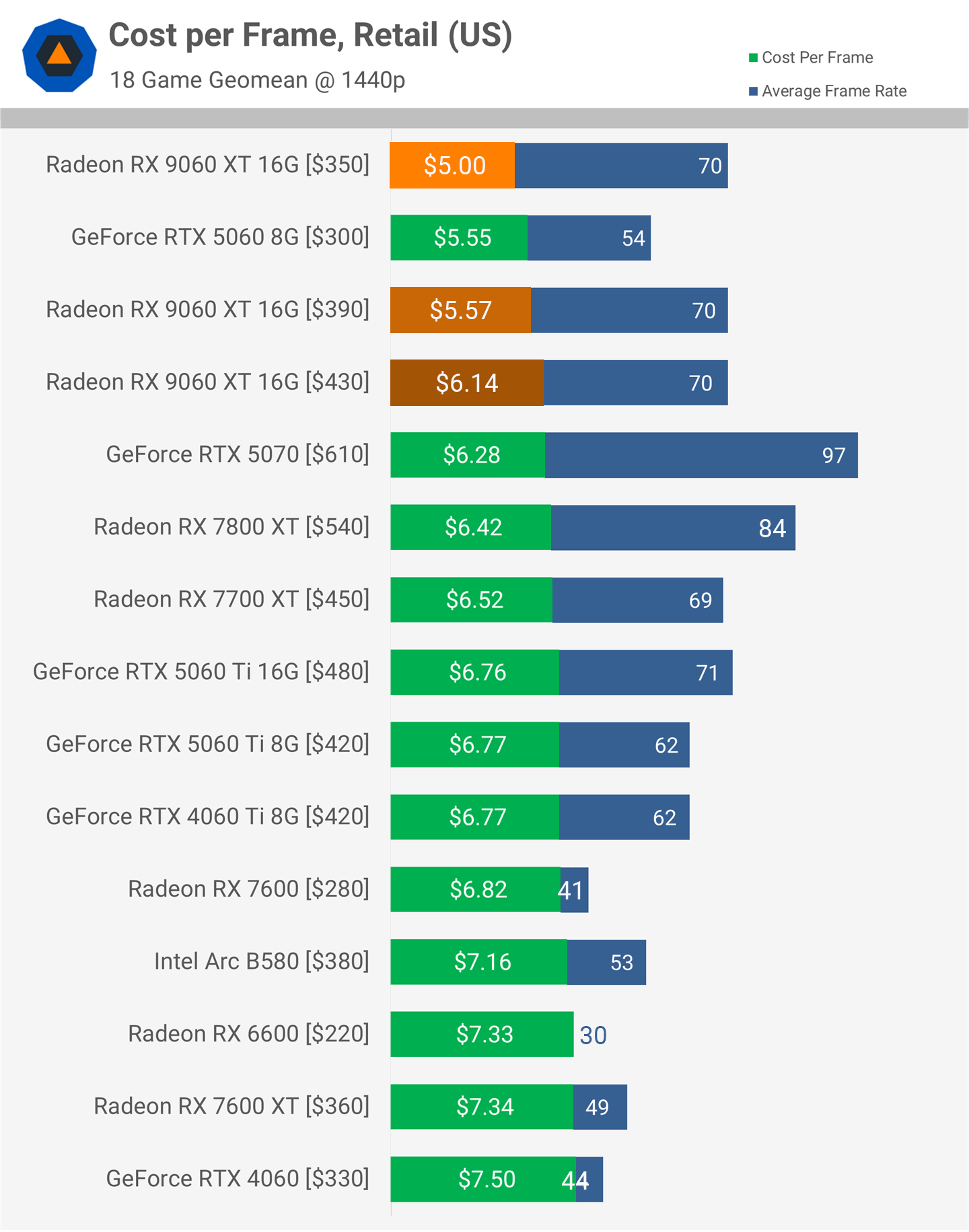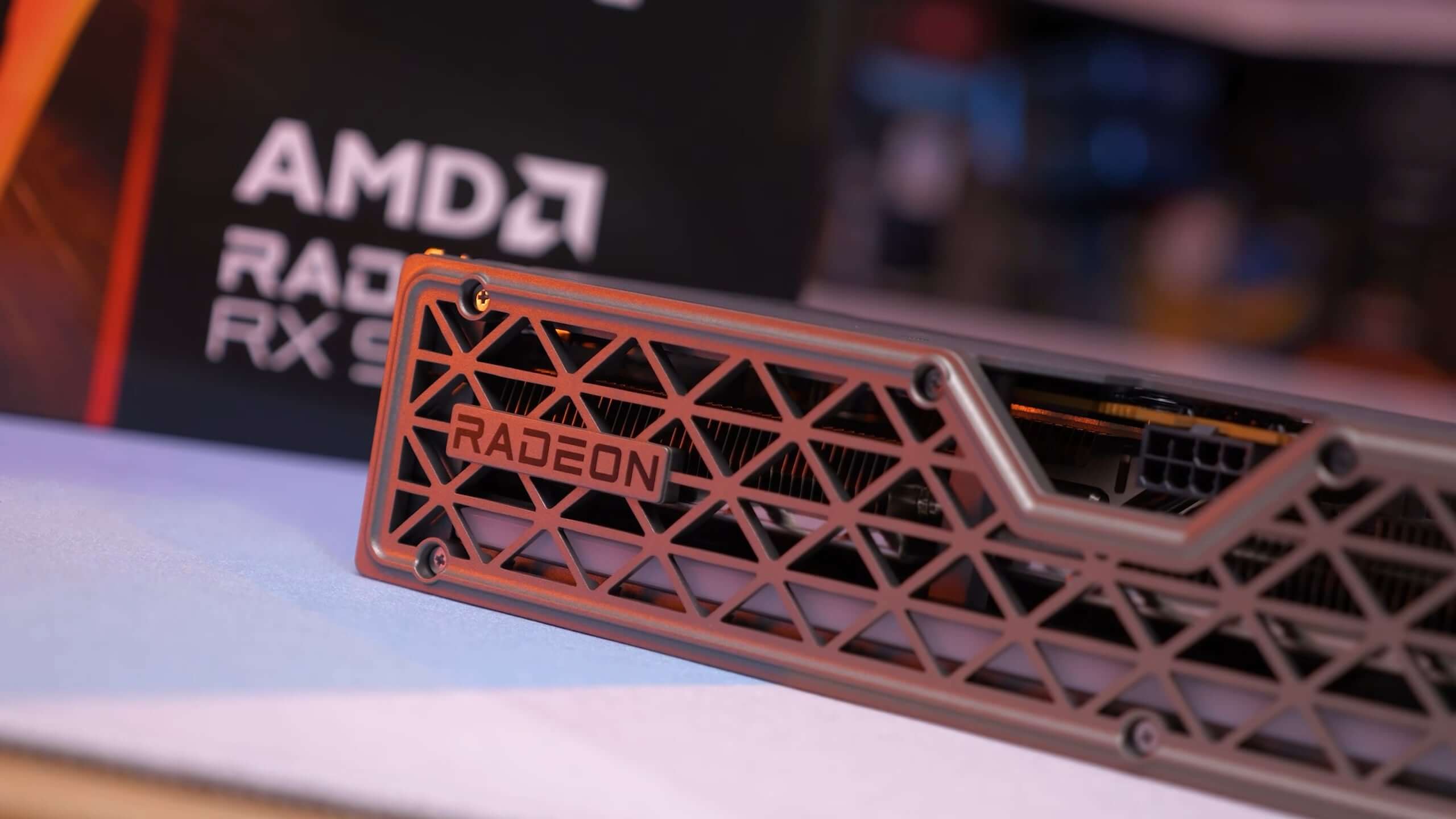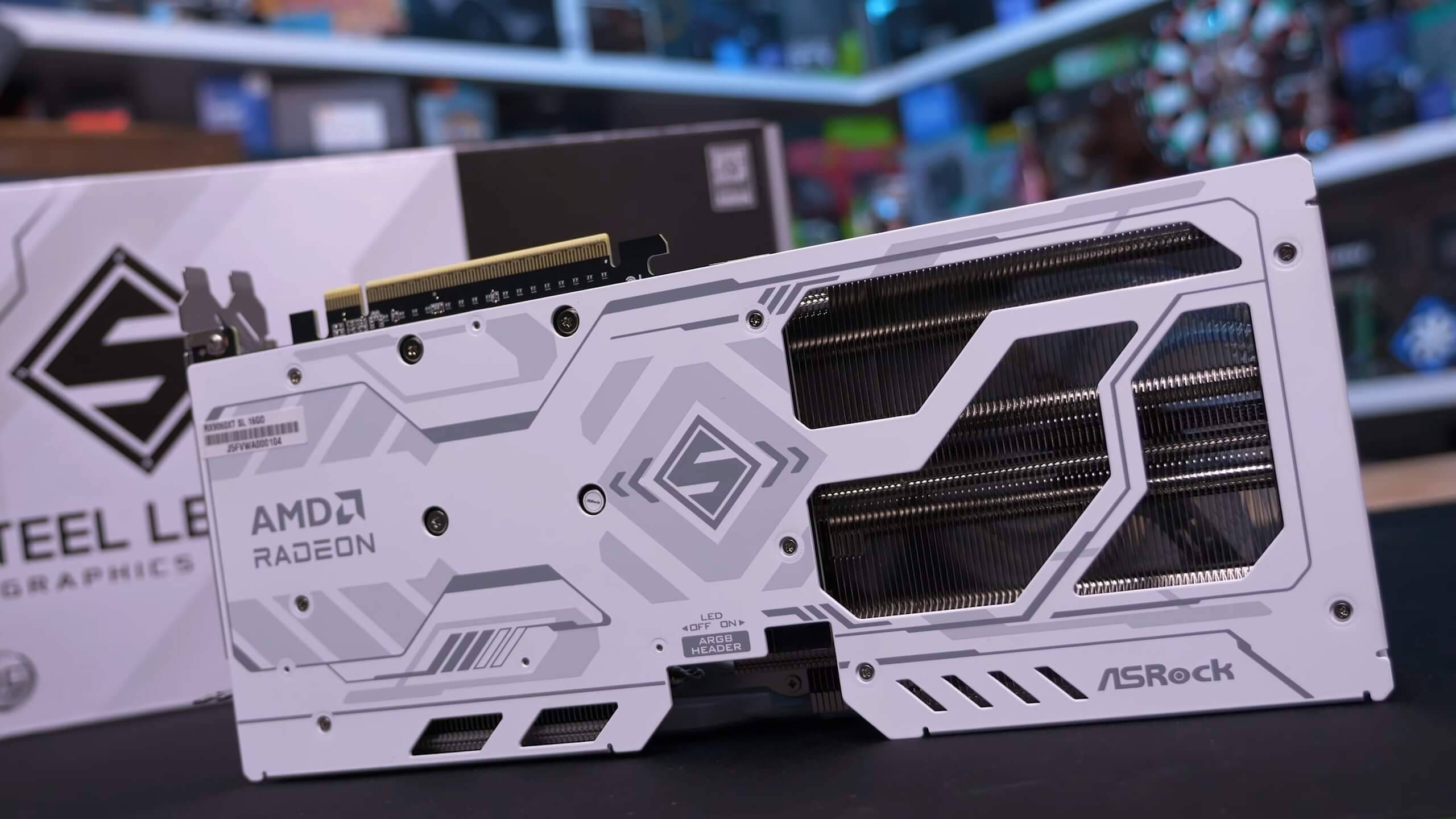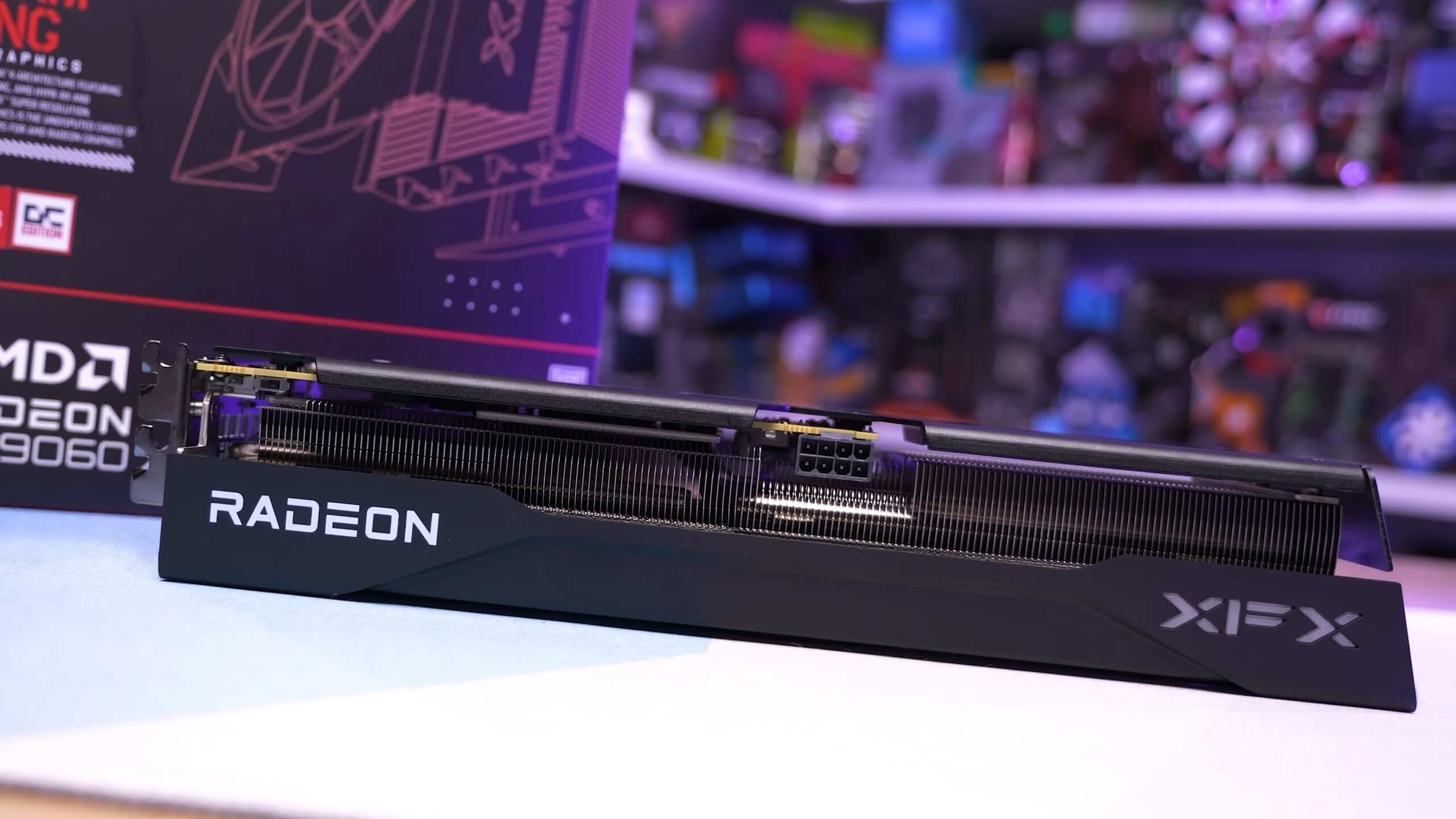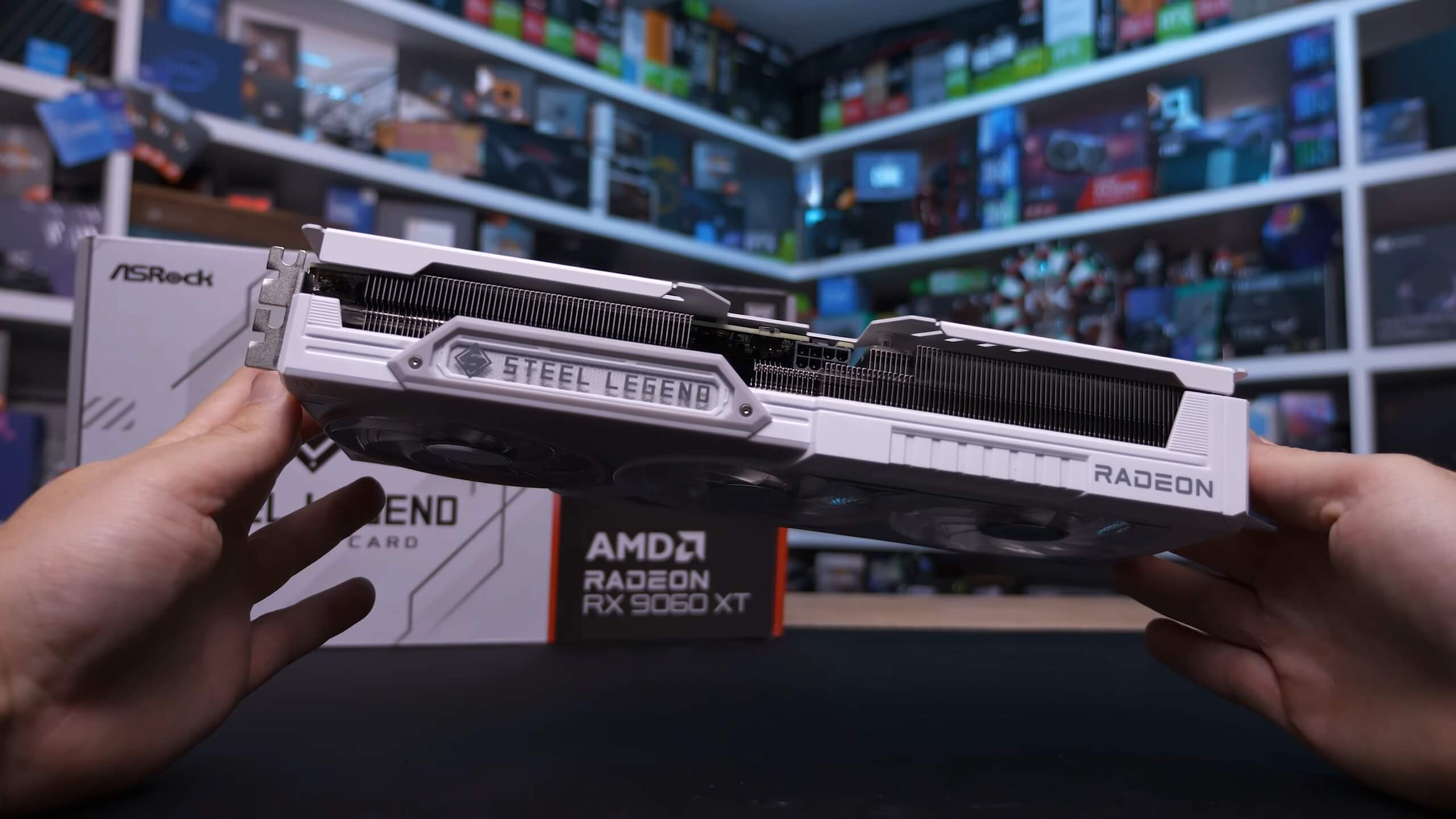In a market crowded with confusing naming conventions and marginal upgrades, AMD's new Radeon RX 9060 XT arrives in two forms: one you should avoid, and one you might even want to pre-order. The former is an 8GB graphics card that feels stuck in 2020. The latter – the focus of this review – is the 9060 XT 16GB, a GPU that could finally bring some sanity back to the sub-$400 bracket.
We'll cover the 8 GB model in a separate review later this week (update: now live), so we won't spend much time discussing it here. (Spoiler: it gets its own, far less flattering, story.)
Priced at $350, the new Radeon RX 9060 XT 16GB comes in ~20% cheaper than the 16 GB RTX 5060 Ti, despite featuring a die that's 10% larger. AMD likely offset some of that cost by sticking with GDDR6 memory. The new Radeon offers more VRAM than any competing current-gen card in its class, while still undercutting Nvidia's 8 GB RTX 5060 Ti in price.
| Radeon RX 9600 XT | Radeon RX 7600 XT | GeForce RTX 5060 Ti | GeForce RTX 4060 Ti | |
|---|---|---|---|---|
| Price MSRP | $300 / $350 | $330 | $380 / $430 | $400 / $500 |
| Release Date | Jun 5, 2025 | Jan 24, 2024 | April 16, 2025 | May 24, 2023 |
| Process | TSMC N4P | TSMC N6 | TSMC 4N | TSMC 4N |
| Die Size (mm²) | 199 mm² | 204 mm² | 181 mm² | 187.8 mm² |
| Core Config | 2048 : 128 : 64 | 2048 : 128 : 64 | 4608 : 144 : 48 | 4352 : 136 : 48 |
| L2 Cache (MB) | 32 MB | |||
| GPU Boost Clock | 3130 MHz | 2755 MHz | 2572 MHz | 2540 MHz |
| Memory Capacity | 8 GB / 16 GB | 16 GB | 8 GB / 16 GB | 8 GB / 16 GB |
| Memory Speed | 20 Gbps | 18 Gbps | 28 Gbps | 18 Gbps |
| Memory Type | GDDR6 | GDDR6 | GDDR7 | GDDR6 |
| Bus Type / Bandwidth | 128-bit, 320 GB/s | 128-bit, 288 GB/s | 128-bit, 448 GB/s | 128-bit, 288 GB/s |
| PCIe Bus Interface | PCIe 5.0 x16 | PCIe 4.0 x8 | PCIe 5.0 x8 | PCIe 4.0 x8 |
| Total Board Power | 150W / 160W | 190 W | 180 W | 160 W |
As we discussed at the time of its announcement, AMD appears to have taken a scalpel to its flagship 9070 XT, halving the die, memory bus, and shader count to create something leaner but still fast enough for 1440p gaming.
Compared to the previous-gen Radeon 7600 XT, the core configuration remains unchanged, but the 9060 XT adopts the newer RDNA 4 architecture. Its cores are clocked 14% higher, and AMD has opted for 20 Gbps memory, boosting bandwidth by 11% to 320 GB/s.
The PCIe interface has also been updated to the 5.0 specification, with all 16 lanes available. While this provides additional headroom on paper, it has little real-world impact for a 16 GB card under typical usage conditions.
For this review, we're testing the Asrock Steel Legend model, which was the first card we received – handed to us at Computex. We also have the Asus Prime and Sapphire Nitro+ variants on hand, which we'll examine in more detail toward the end of the review during our thermal testing. Let's get started.
Test System
| CPU | AMD Ryzen 7 9800X3D |
| Motherboard | MSI MPG X870E Carbon WiFi (BIOS 7E49v1A23 - ReBAR enabled) |
| Memory | G.Skill Trident Z5 RGB DDR5-6000 [CL30-38-38-96] |
| Graphics Cards |
GeForce RTX 4070
GeForce RTX 4070 Super GeForce RTX 4070 Ti GeForce RTX 4070 Ti Super GeForce RTX 4080 GeForce RTX 4080 Super GeForce RTX 4090 GeForce RTX 5070 GeForce RTX 5080 GeForce RTX 5090 Radeon RX 7700 XT Radeon RX 7800 XT Radeon RX 7900 GRE Radeon RX 7900 XT Radeon RX 7900 XTX Radeon RX 9060 XT 16GB Radeon RX 9070 Radeon RX 9070 XT |
| ATX Case | MSI MEG Maestro 700L PZ |
| Power Supply | MSI MPG A 1000G ATX 3.0 80 Plus Gold 1000W |
| Storage | MSI Spatium 1TB M470 PCIe 4.0 NVMe M.2 |
| Operating System | Windows 11 24H2 |
| Display Driver | Nvidia GeForce Game Ready 572.60 AMD Radeon Adrenalin 24.12.1 / 24.30.31.03 |
Benchmarks
Clair Obscur: Expedition 33
Starting with Clair Obscur: Expedition 33, the RX 9060 XT was 5% slower than the 5060 Ti. However, using the Epic preset, neither GPU delivered impressive performance at 1440p, so upscaling or reduced quality settings would be necessary. Frame rates were closer to 60 fps at 1080p, though the performance margin remained similar. For the purpose of comparing these GPUs, the 1440p data is appropriate.
The Elder Scrolls IV: Oblivion Remastered
Performance in Oblivion Remastered was also underwhelming at native 1440p using the Ultra preset, averaging just 41 fps. Still, the RX 9060 XT managed to outperform the 5060 Ti by 11%.
Delta Force
Delta Force is a much lighter title, allowing the 9060 XT to achieve 105 fps at 1440p. That said, it was still 10% slower than the 5060 Ti. In this scenario, performance was comparable to the 4060 Ti, making the 9060 XT only 6% faster than the older RTX 3060 Ti.
Stalker 2: Heart of Chornobyl
Stalker 2 is playable on the RX 9060 XT at 1440p with max settings, though upscaling would likely be needed to maintain 60 fps. Here, the 9060 XT and 5060 Ti were neck and neck, both averaging just over 40 fps.
Counter-Strike 2
In Counter-Strike 2, recent driver updates have improved performance for Blackwell GPUs, but not significantly for RDNA4. As a result, the RX 9060 XT was 17% slower than the 5060 Ti, averaging 331 fps. While that's still excellent performance, it lags behind the GeForce counterpart.
Warhammer 40,000: Space Marine 2
Next, in Space Marine 2, Blackwell GPUs again benefited from recent drivers. The RX 9060 XT, however, was 13% slower than the 5060 Ti, averaging 66 fps. This puts it in a similar range as the 7700 XT and RTX 3070.
Star Wars Jedi: Survivor
The RX 9060 XT was again behind the 5060 Ti, this time by an 8% margin at 1440p in Star Wars Jedi: Survivor. It also trailed the 7700 XT by the same amount, resulting in a disappointing showing overall.
Call of Duty: Black Ops 6
As usual, Radeon GPUs excel in Call of Duty, and Black Ops 6 is no exception. Here, the RX 9060 XT was a massive 32% faster than the 5060 Ti and even outpaced the 7700 XT by 10%.
A Plague Tale: Requiem
The RX 9060 XT also did well in A Plague Tale: Requiem, edging out the 5060 Ti by just 3%. In practical terms, both GPUs provided a similar experience in this title.
Starfield
Starfield performance wasn't bad, and upscaling could help push it beyond 60 fps. Even so, the RX 9060 XT was 6% slower than the 5060 Ti, delivering performance on par with the RTX 3070, 7700 XT, and 4060 Ti. Overall, it was an underwhelming result.
Cyberpunk 2077: Phantom Liberty
In Cyberpunk 2077: Phantom Liberty, the RX 9060 XT and 5060 Ti were very close, with the Radeon GPU trailing by just 2%. Compared to last-gen parts, performance is in line with the 7700 XT and RTX 4070.
God of War Ragnarök
The RX 9060 XT performed strongly in God of War Ragnarök, averaging 101 fps at 1440p and coming in slightly ahead of the 5060 Ti. This is yet another example of near-identical performance between the two.
Dying Light 2 Stay Human
Unfortunately for AMD, we benchmark Dying Light 2 using the High preset, which defaults to the DirectX 11 API. This is simply how the game is configured by default – we don't manually adjust settings to favor one brand over another. That said, if you're using a Radeon GPU, we recommend manually switching to DirectX 12, as it can significantly improve performance. Without this change, the RX 9060 XT ends up 18% slower than the 5060 Ti, whereas performance is much more comparable when using DX12.
Dragon Age: The Veilguard
We've already seen several examples where the RX 9060 XT and 5060 Ti deliver similar performance, and Dragon Age: The Veilguard is another case. Here, the Radeon GPU was just 3% slower.
Marvel's Spider-Man Remastered
Spider-Man Remastered also shows very similar performance between the RX 9060 XT and 5060 Ti. Impressively, the 9060 XT managed to outperform the 7800 XT by 10%.
Hogwarts Legacy
In Hogwarts Legacy, the RX 9060 XT edged out the 5060 Ti by a 5% margin. Once again, performance between the two is nearly identical, and both delivered excellent results at 1440p using the High preset.
The Last of Us Part I
Performance in The Last of Us Part I was also close. The RX 9060 XT was 7% slower than the 5060 Ti, but still averaged 65 fps at 1440p using Ultra settings. Overall performance was solid – better than the 7700 XT, especially in 1% lows.
Star Wars Outlaws
Finally, in Star Wars Outlaws, performance was nearly identical, with the RX 9060 XT rendering just one additional frame compared to the 5060 Ti. However, overall performance was underwhelming, as the game is not well optimized.
Performance Summary
1080p
At this resolution, the Radeon RX 9060 XT and 5060 Ti are fairly evenly matched, with the Radeon GPU coming in 6% slower overall. That places it just 4% ahead of the 7700 XT. In other words, it offers 7700 XT-like performance, but with improved ray tracing, FSR 4 support, more VRAM – and it should also be more affordable.
1440p
At 1440p, the data is slightly more favorable to the RX 9060 XT, which was just a frame or a percent behind the 5060 Ti. That's a solid result considering it should be priced nearly 20% lower. This is the same level of performance you'd expect from the 7700 XT.
Ray Tracing Benchmarks
RT - Alan Wake II
Now it's time to look at ray tracing performance in titles we believe offer meaningful visual enhancements, starting with Alan Wake II. At 1080p with upscaling, performance was poor – just 31 fps on average – making the 5060 Ti significantly faster. However, we wouldn't recommend playing at 1080p with DLSS either, which only produced 46 fps. At that point, it may be better to simply disable ray tracing effects.
RT - Cyberpunk 2077
Cyberpunk 2077 fared better, but still only hit 64 fps at upscaled 1080p – hardly impressive. The RX 9060 XT was 14% slower than the 5060 Ti, which itself only reached 74 fps under the same conditions. Neither GPU is capable of delivering a consistently smooth RT experience at this resolution. At 1440p, performance dropped further, with the 5060 Ti managing just 49 fps.
RT – Marvel's Spider-Man Remastered
Spider-Man Remastered is a well-optimized RT title, and both GPUs performed very well here, delivering 123 fps at 1080p. At 1440p, the RX 9060 XT averaged 88 fps, while the 5060 Ti reached 90 fps – both delivering excellent results.
RT – Dying Light 2 Stay Human
In Dying Light 2, the RX 9060 XT managed 75 fps at upscaled 1080p. While that may sound decent, it's less impressive considering the resolution and upscaling. The Radeon GPU was 9% slower than the 5060 Ti, and at 1440p with quality upscaling, both fell short of 60 fps.
RT – Black Myth: Wukong
In Black Myth: Wukong with very high ray tracing enabled, the RX 9060 XT managed just 26 fps at upscaled 1080p, making it effectively unplayable. It was roughly 50% slower than the 5060 Ti, which only managed 51 fps – still far from ideal at this resolution.
RT – Indiana Jones and the Great Circle
A similar result was seen in Indiana Jones and the Great Circle. The RX 9060 XT averaged only 23 fps, 45% slower than the 5060 Ti, which itself managed just 42 fps – again, not a strong showing for either GPU.
RT – Metro Exodus Enhanced
Older, better-optimized ray tracing titles like Metro Exodus Enhanced run much better on the RX 9060 XT, which delivered 152 fps – just 4% slower than the 5060 Ti.
Ray Tracing Performance Summary
Overall, the Radeon RX 9060 XT was 20% slower than the 5060 Ti in our ray tracing tests, averaging 65 fps overall. However, in most modern titles, neither GPU delivers an ideal RT experience, and in older games where ray tracing is playable, performance between the two is very similar.
Power Consumption
In terms of power usage, the RX 9060 XT performs as expected. In Starfield, it consumed slightly more power than the 7600 XT and around 10% more than the 5060 Ti, a 26W increase. For context, our measurements combine both CPU and GPU power draw to account for system-level overhead.
In Star Wars Outlaws, power consumption looked similar, with the RX 9060 XT drawing 27W more than the 5060 Ti – an 11% increase – again consuming a bit more than the 7600 XT.
Finally, in Space Marine 2, the RX 9060 XT used 21W more than the 5060 Ti, an 8% increase in this scenario.
Thermal Results for Different Brands
Here's a quick look at how the partner cards we have on hand performed under the same conditions: one hour of gameplay in F1 25, inside a closed ATX case at a room temperature of 21°C.
- Asrock Steel Legend and Sapphire Nitro+ both reported a GPU hotspot temperature of 79°C with fans spinning at 1,000 RPM. Both were extremely quiet and inaudible over our case fans.
- Asus Prime had slightly louder fans running at 1,550 RPM, but achieved a lower hotspot temperature of 70°C.
- XFX Swift ran its fans at 1,400 RPM, achieving the lowest hotspot temperature at 69°C, while also clocking its cores the highest.
For memory temperatures:
- Asrock Steel Legend peaked at 85°C
- Asus Prime at 82°C
- XFX Swift at 80°C
- Sapphire Nitro+ at 84°C
As for VRM temperatures:
- Steel Legend reached 75°C
- Prime stayed cooler at 62°C
- Swift hit 71°C
- Sapphire Nitro+ also reached 75°C
Cost per Frame: MSRP
Time to look at the cost-per-frame data, starting with MSRP. We always like to begin here, as it shows where each GPU should sit if all models were available at their suggested retail prices. In this scenario, if the Radeon RX 9060 XT 16GB is available at $350 and other GPUs are sold at MSRP, the 9060 XT represents excellent value.
First, it's by far the cheapest current-generation GPU offering 16 GB of VRAM. This is significant, even if it's not fully reflected in the cost-per-frame data – many of the games tested still perform fine with 8 GB of VRAM. However, that's becoming less true over time, with an increasing number of games now struggling or breaking on 8 GB GPUs when using otherwise reasonable settings.
That aside, the RX 9060 XT still looks very good here, coming in at a cost per frame of $5 – just a 6% premium over the B580. That makes the B580 a tougher sell, assuming all GPUs are available at MSRP. The 9060 XT 16GB also makes the RTX 5060 largely irrelevant; for just $50 more, it delivers nearly 30% better performance and twice the VRAM. That's a clear and easy upgrade.
It's also 17% better value per frame than the 5060 Ti 16GB, making the Radeon GPU the better value overall – and the one we'd recommend. If all cards were sold at MSRP, the 9060 XT 16GB would easily be the best budget GPU on the market.
Cost per Frame: Retail (US)
What about actual retail pricing? At the time of writing, we don't know what the RX 9060 XT will cost – or how long it will take for pricing to stabilize. So we've created a few scenarios to compare against GPUs that are currently available.
We've included the $350 MSRP, which some models may briefly hit, along with more realistic projections at $390 and $430 to compare against the 5060 Ti 16GB, which currently costs around $480.
If you're lucky enough to grab a 9060 XT 16GB at $350, it offers 26% better value than the 5060 Ti 16GB. At $390 – a price 11% above MSRP and the same markup the 5060 Ti 16GB currently carries – the 9060 XT still offers 18% better value, making it the smarter choice.
However, if the price climbs to $430, the value advantage shrinks to just 9%, at which point the 5060 Ti becomes a viable alternative. AMD will need to keep pricing below $400 to retain a meaningful advantage. We'll continue to monitor retail pricing and plan to provide an update next month.
What We Learned
AMD claimed the Radeon RX 9060 XT would deliver performance similar to the GeForce RTX 5060 Ti. Based on our testing, that claim holds up. We observed virtually identical performance at 1440p. Assuming AMD can meet demand (which might not be the case for the first few months), the new 9060 XT 16GB checks all the right boxes.
At $350, the 9060 XT would become the ultimate budget GPU and an outstanding value. You're getting 7700 XT-like performance, 16 GB of VRAM, support for FSR 4, and improved ray tracing. While ray tracing at this tier remains questionable – even on the 5060 Ti – it's there if you want it. Realistically, you're better off disabling RT to get higher frame rates and lower latency, but opinions on this will no doubt vary.
With an average of 70 fps across the 18 games tested at native 1440p, the 9060 XT is clearly capable. It also delivered 43% more performance than the 7600 XT, AMD's previous entry-level 16GB GPU, for what should be just a 6% price premium.
As it stands, the 9060 XT 16GB should be the least expensive GPU anyone considers buying. Saving $50 to get the RTX 5060 or RX 9600 XT 8GB is effectively throwing money away. And to be clear – we're not mocking or criticizing those who genuinely can't afford the extra $50. However, as we've seen with 8 GB and 16 GB versions of the 4060 Ti, the 8 GB models depreciate faster and are harder to sell later due to lower demand. A few years from now, the 8 GB versions of the 9060 XT and 5060 Ti are likely to sell for significantly less – well below the 14% savings they offer today.
If you're considering AMD's Radeon 9060 XT based on the performance shown in this review, be extremely careful when shopping – you do not want to accidentally buy the 8 GB version. When sorting listings by price, skip every 8 GB model.
We certainly advocate for AMD and Nvidia to offer better products at better prices. Specifically, in the case of the 9060 XT, GDDR6 memory is plentiful and affordable – there's no reason a base 9060 XT shouldn't include 16 GB of VRAM at a $300 price point.
On that same note, they could simply name the slower 8 GB version something else – why add to the confusion? So there's the ongoing issue of product naming. Releasing two drastically different models under the same name is anti-consumer. In 2025, an 8 GB GPU is simply not viable for many modern games, and labeling such products as "XT" or "Ti" only adds to the confusion.
If you're considering AMD's Radeon 9060 XT based on the performance shown in this review, be extremely careful when shopping – you do not want to accidentally buy the 8 GB version. When sorting listings by price, skip every 8 GB model. We plan to show you just how trash that product is in a second review later this week.
Sadly, the 8 GB version casts a shadow over what should be a straightforward win for AMD.
There should be nothing negative to say about the 9060 XT, but AMD undermined themselves by not taking the opportunity to deliver a knockout blow to Nvidia's 5060 series. That said, the 16 GB model looks very strong at MSRP – we just need to see whether that price holds. We'll reserve final judgment until retail availability and pricing stabilize.
